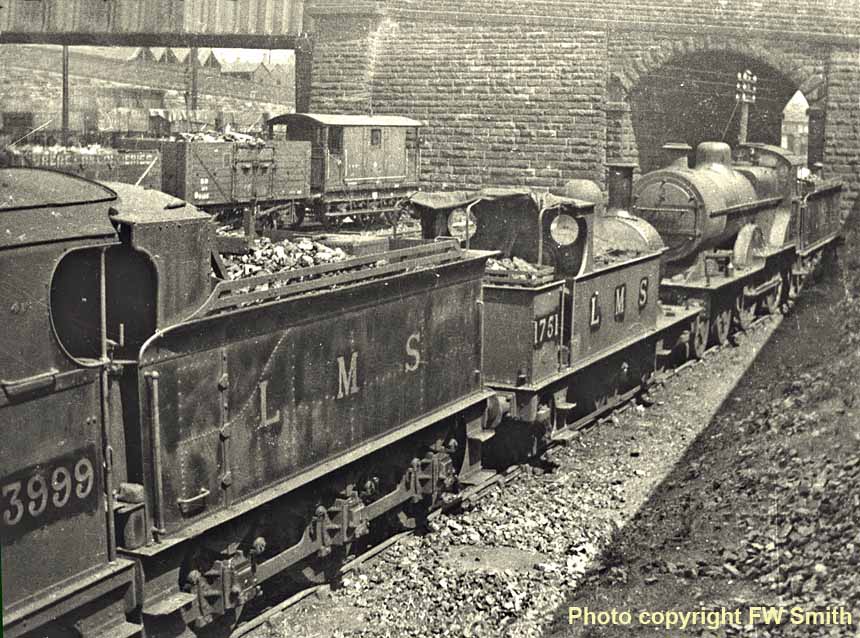(Below) When I first posted this splendid shot on the final Aire Valley page of WD 2-8-0 No 90517 arriving at Skipton on 27 September 1963, I described it as hauling the Tilcon train from Rylstone...
Wrong!
I am advised by FW (Bill) Smith, then signalman at Embsay station in 1963, that it is not a Tilcon train. Bill writes - ' On looking in my 1963 diary I see I was on duty at Embsay station box that morning, and this was a special train of ballast hoppers from the Skipton Rock Company at Embsay destined for New Hey in Lancashire. I signalled this train out at 9.55am that morning. Special ballast trains from Embsay were common at this time mostly on Thursdays and Fridays for reballasting work at weekends...'
Thanks Bill, corrections are always welcome, and thanks also for your contribution to this page featuring the railways of Wharfedale...your memories of the old days are priceless!

FW SMITH's RAILWAYS THROUGH WHARFEDALE
Introduction by David Hey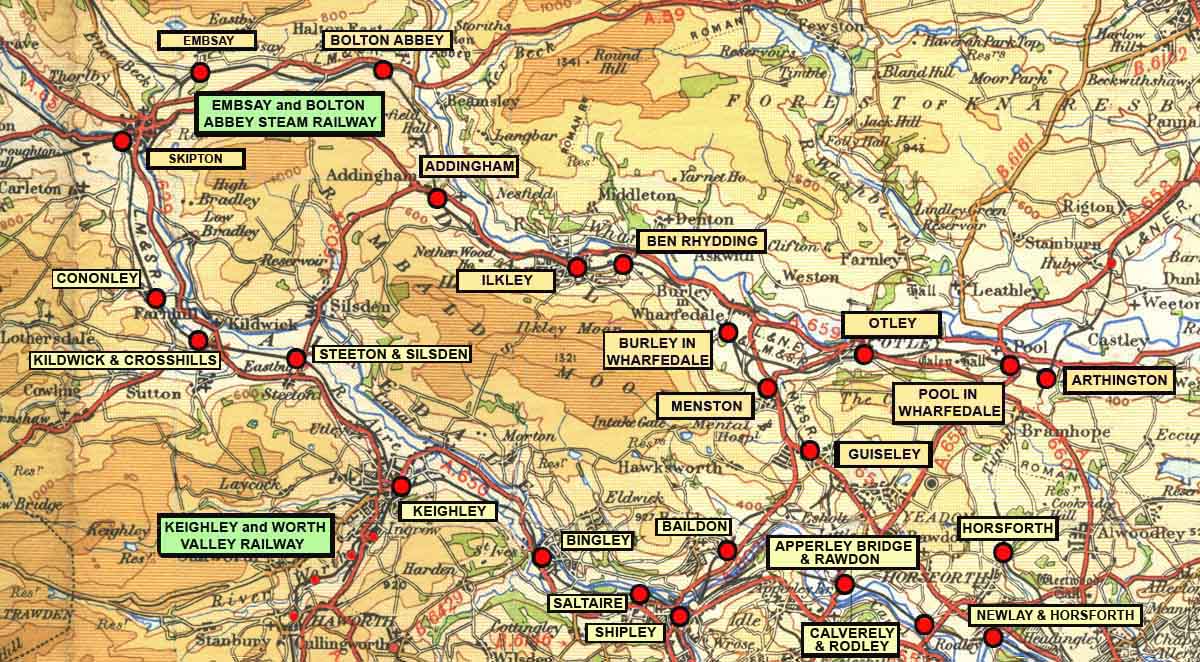
Opened to passenger traffic on 1 August 1865, the Otley and Ilkley Joint Railway between Otley and Ilkley later came under the auspices of the Midland Railway (MR) and the North Eastern Railway (NER). Most of 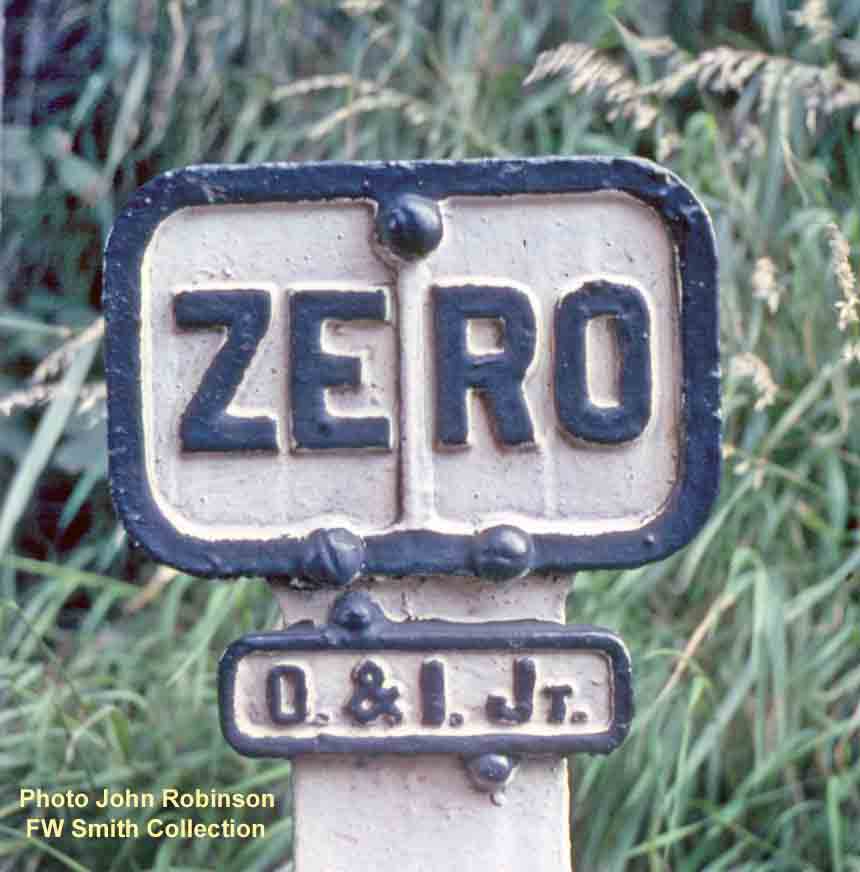 the passenger traffic on the line through Wharfedale consisted of local trains and passengers travelling further afield had to change trains at either Leeds, Bradford, Harrogate or Skipton.
the passenger traffic on the line through Wharfedale consisted of local trains and passengers travelling further afield had to change trains at either Leeds, Bradford, Harrogate or Skipton.
(Left) The start of the Otley & Ilklèy Joint Line mile post situated at the Arthington end of the goods yard at Otley station (see map below).
The North Eastern Railway's passenger services ran from Ilkley to Leeds via Otley, a slightly longer route than the Midland Railway's more direct service which joined the Aire Valley line at Apperley Junction between Leeds and Shipley.
Following Grouping in 1923 the Wharfedale line was managed on a joint basis by the LMS and LNER as the successors to the MR and NER companies. The LNER operated eight trains each way on weekdays between Ilkley and Leeds and also eight trains between Harrogate and Bradford, whereas the LMS services were comprised of nine trains between Ilkley and Leeds, and fourteen trains each way between Ilkley and Bradford. Seven of the LMS trains were through services to and from Skipton. 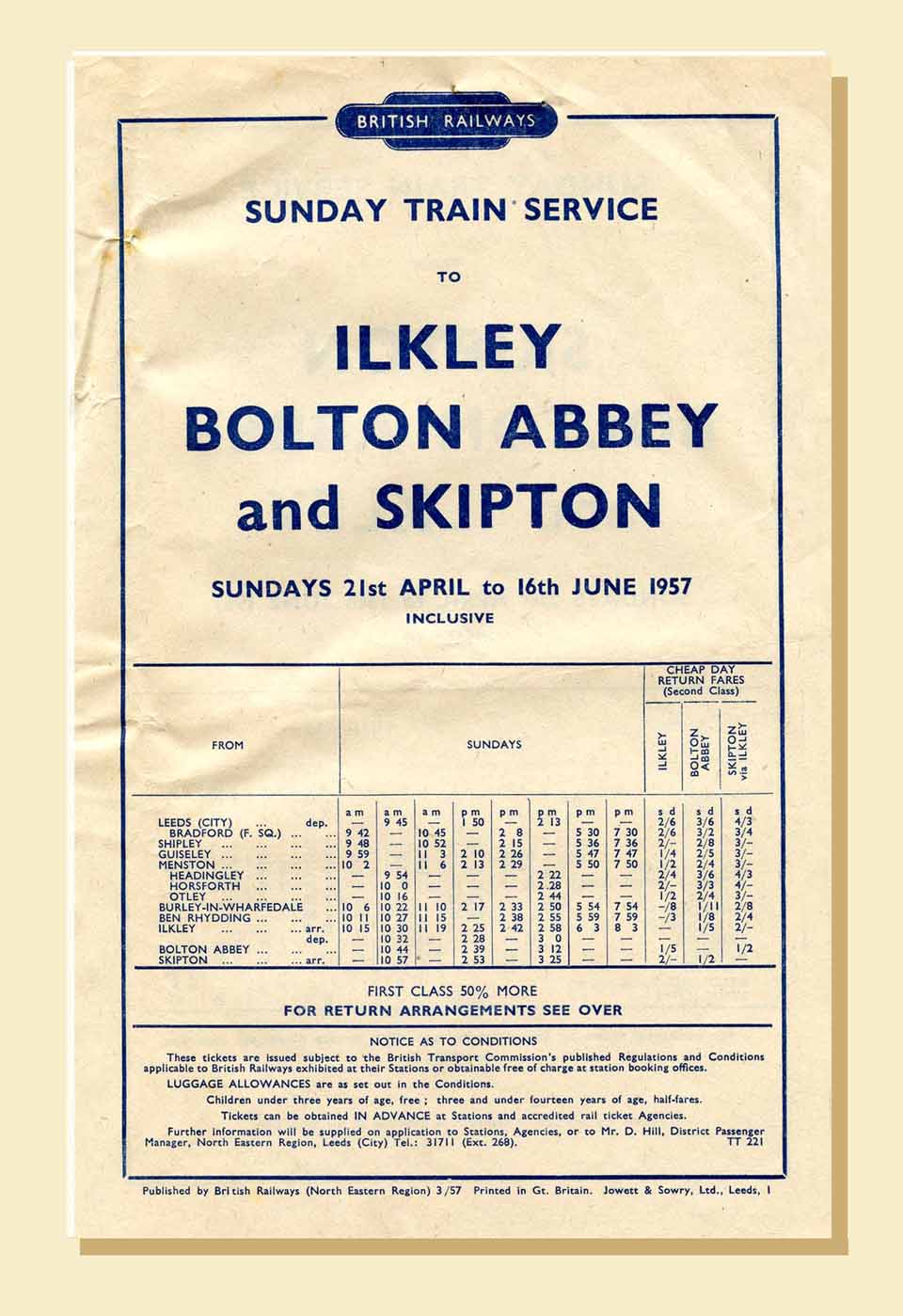 Following World War II, the LNER's direct service between Ilkley and Leeds via Otley was reduced tojust one each way, albeit a further six journeys were possible by a shuttle service to Arthington with its connection to Harrogate-Leeds trains; the number of trains between Harrogate and Bradford was reduced to two each way. The LMS service was not much better with only seven trains between Ilkley and Bradford and six trains between Ilkley and Leeds.
Following World War II, the LNER's direct service between Ilkley and Leeds via Otley was reduced tojust one each way, albeit a further six journeys were possible by a shuttle service to Arthington with its connection to Harrogate-Leeds trains; the number of trains between Harrogate and Bradford was reduced to two each way. The LMS service was not much better with only seven trains between Ilkley and Bradford and six trains between Ilkley and Leeds.
Following nationalisation in 1948, the Wharfedale line became part of the London Midland Region before being transferred to the North Eastern Region during the Regional reshufle of 1955. However, neither event had much effect on train services and it wasn't until local passenger services were dieselised in 1959 that any major changes were seen. The introduction of diesel multiple units led to the number of daily trains increasing from 41 to 72 with an hourly service between Ilkley and Bradford and Ilkley and Leeds via Guiseley.
However, under the Beeching plan of 1963, formal notices were issued for the closure of all the lines in Wharfedale, and had it not been for the hard-fought campaign by the Ilkley Railway Supporters Association both the service from Bradford and from Leeds via Guiseley to Ilkley would not have been reprieved.
Alas the same can't be said for line north of Ilkley to Skipton and the line via Otley and Arthington; both were closed in 1965 and Ilkley once again became a terminus.
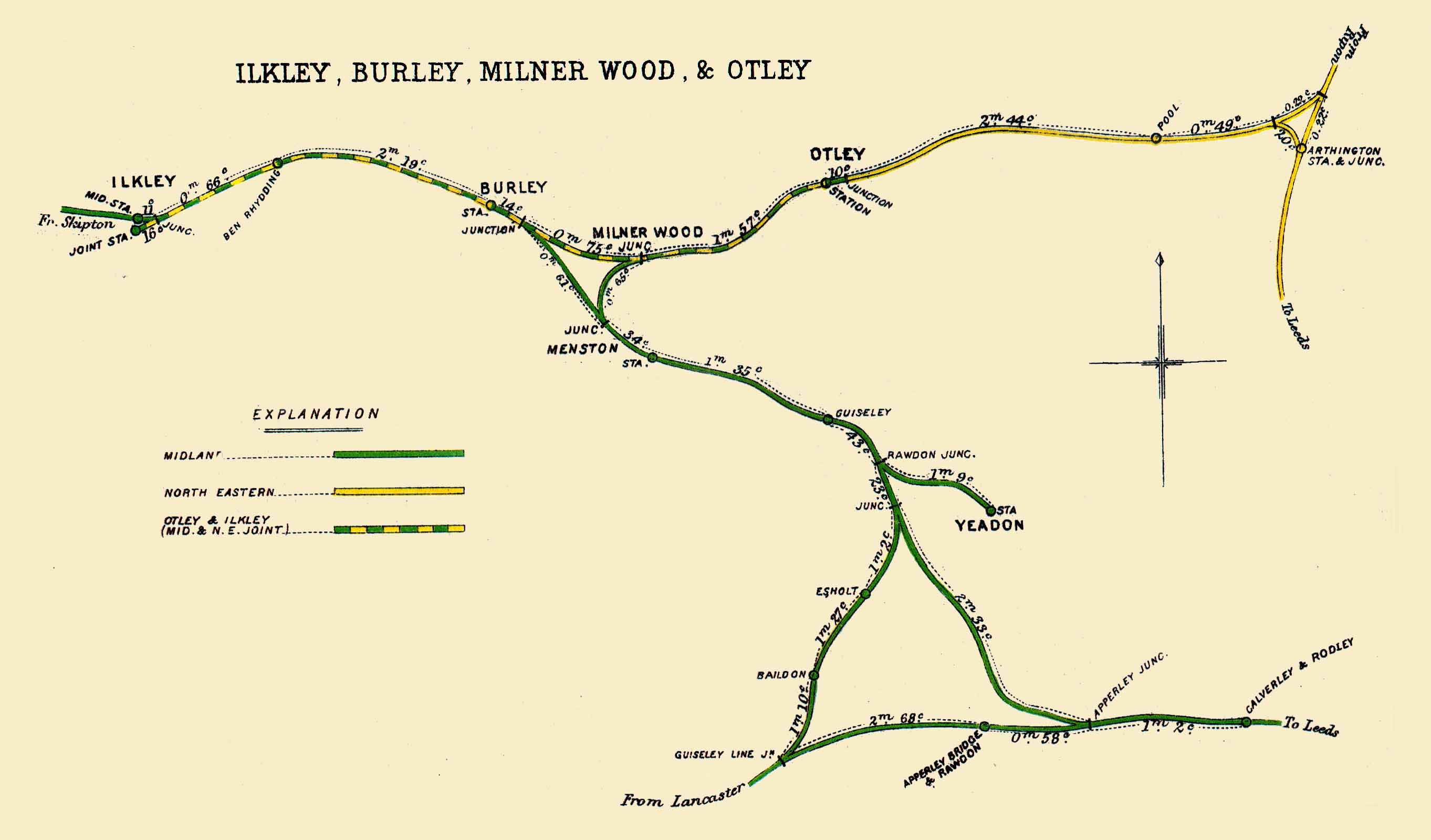
FW Smith's Early Spotting Days
Born and bred in Ilkley, FW (Bill) Smith's interest in railways began as a small boy in 1938. His grandfather was a driver at Ilkley shed up to retirement in September 1934, and the last engine he had driven was Class 2P 0-4-4T 6402. Even today this engine number has a lasting resonance for Bill as it was drilled into him as being granddad's engine; indeed when he first saw the 0-4-4T from the footbridge at Ilkley in 1938 it set him  off on a lifetime's interest in trains and railways, and over the next few years he spent many happy hours collecting numbers at Ilkley and at Steeton & Silsden station on the Aire Valley Line plus he made regular visits to Skipton and of course, Leeds.
off on a lifetime's interest in trains and railways, and over the next few years he spent many happy hours collecting numbers at Ilkley and at Steeton & Silsden station on the Aire Valley Line plus he made regular visits to Skipton and of course, Leeds.
(Left) This is a shot of a bespectacled Bill in school uniform standing on platform 1 at Ilkley in 1946. The locomotive is Class 2P 0-4-4T No 1903 of Manningham shed (20E). At this time Nos 1900 to 1904 in the class were based at Manningham shed, previously numbered 6400 to 6404.
During the war years Bill and his spotting pal went to Manchester Victoria for the day. He was just 12 years-old at the time, and he still doesn't know how his mother allowed him to travel to Manchester at such a young age. Not that they had any problems - the only time anyone queried what he was writing in his notebook happened at Holbeck shed when a policeman asked why he was noting down numbers, nigh on accusing him of recording the direction of goods trains and the type of wagons being used, and how many they had on!
He was just 13 years-old...some spy!
Bill and his school pal Ken Wardell spent many hours spotting at points along the Wharfedale line, during which Bill always recorded the date and where he had seen each engine, and before long they had collected most of the common engines on their lists. Of special interest in 1943 were the Sentinel steam railcars, two of which - 'Cleveland' and 'Surprise' - were quite common; these were used on the service from Ilkley to Leeds via Otley and Arthington or the shuttle between Ilkley and Arthington only, enabling passengers to change for Leeds or Harrogate...
Bill now takes up the story below....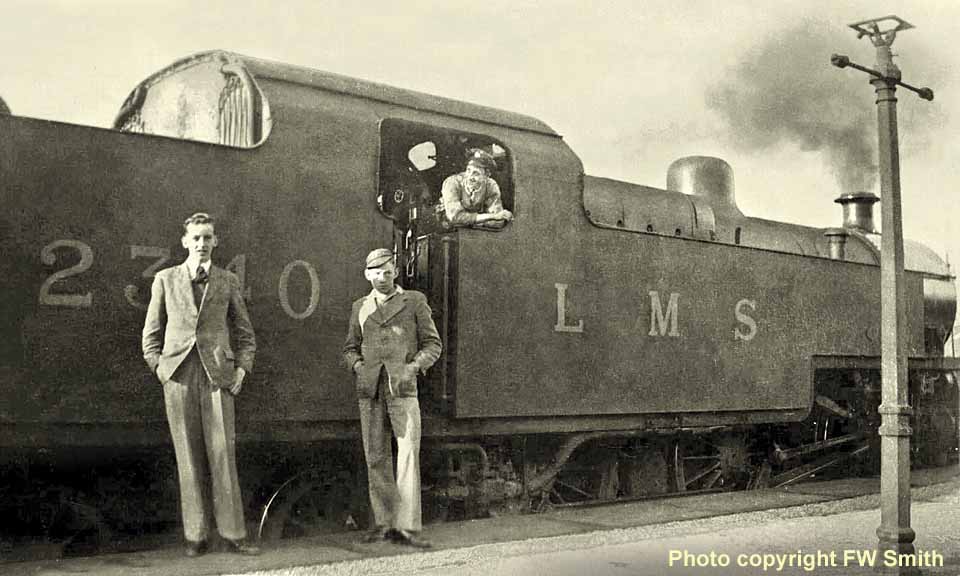
(Above) Bill's spotting pals Dennis Vallender and Ken Wardell pose in front of Fowler Class 4 2-6-4 T 2340 at Ilkley platform 3 with a train for Leeds via Guiseley in 1946.
RAILWAYS THROUGH WHARFEDALE
by FW Smith
Harking back to early spotting days, some dates spring to mind above all others. One date is Monday 20 October 1941 as it heralded the start of LNER freight workings on the Wharfedale line; these consisted mainly of coal and coke traffic from the Newport Teeside area to Lancashire.
This traffic was routed south from Northallerton via Ripon and Harrogate before diverging at Arthington through Otley, Ilkley and Skipton where the changeover from the LNER to LMS engines took place, with occasional changeovers at Colne from April 1942. This was a very special time for observers as the trains produced many classes of LNER Locos never seen at Ilkley before, with up to six trains a day each way.
The following day I was at Ilkley on Tuesday 21 October and the first freight working I noted was hauled by Class B16 4-6-0 No 849 and Class J39 0-6-0 No 3092 with a train of wooden bodied coke hoppers heading towards Skipton. I recall seeing Class K3 2-6-0 No 17 with some relish as it was then the lowest LNER number I had seen!
Other classes of note were J27 0-6-0 No 2391 with Class J11 0-6-0 No 5952 on 28 January 1942; Class J39 No 1460 with Class J17 No 8206 on 23 May 1942; Class J21 No 1814 with Class B16 No 1378 on 7August 1942, and super power B16 928 with K3 3822 on 5 October 1942. Such was the interest in those far off days...

(Above-Below) Class J39 0-6-0 64859 of Starbeck shed passes through Ilkley with the Heysham to Haverton Hill ammonia tank train on Sunday 10 June 1951. (Below) Ex-Midland Class 2P 4-4-0 406 of Skipton shed (20F) awaits departure at Ilkley's platform 4 with a Skipton to Bradford Forster Square working in 1946. The locomotive was withdrawn in August 1951. 
During the summer of 1946, after taking a couple of pictures of locos on Ilklèy station with my Brownie box camera, I was heading home along the street past Ilkley box when the signalman appeared on the steps to wave a loco back with a duster. After taking his photo, he asked - 'Do you want to come up?'
I didn't need asking twice.
His invitation was the start of many visits to the box where I was allowed to work the occasional lever. Jack Metcalfe was the signalman and he lived at Foulridge near Colne. He had to leave home about 3am to open Ilkley box at 4.15am, but on rare occasions he did not make it on time; indeed sometimes not at all!...and when this happened the Ilkley porter signalman Cecil Chatterton was called out to work some unwanted overtime.
In 1946 Jack Metcalfe decided he'd had enough of the travelling involved and demoted himself to porter signalman closer to home at his local station at Foulridge. On 20th December 1946 I went to visit him, catching the 10.02am from Ilkley to Skipton. This train departed Leeds at 9.10am hauled by Class 2P 4-4-0 No 633, this being one of only two fitted with the ugly Dabeg feed water heater. Prior to our departure from Ilkley, I noted the 10am Ilkley to Leeds via Otley departing behind Class D20 4-4-0 No 2393 and also an ex-Caledonian Class 2P 0-4-4T No 15130, one of four of the class recently transferred to Manningham shed from Scotland to replace 0-4-4Ts Nos 6400-04 which had been transferred elsewhere.
As it turned out, things were rather tame for Jack at Foulridge station, as he was now a porter signalman spending all his time in the booking office, the box only being open for the pick up goods to shunt the sidings. My return train from Foulridge was hauled by 2-6-4 T No 2645 to Skipton where I caught the 4.55pm Bradford train to Ilkley with Compound 4-4-0 No 1100 in charge. I made further visits to Foulridge in 1947, and also to Colne with Jack to visit Colne Number 2 box which had 60 levers and was very busy. Noted there were two ex-LYR 2-4-2T locos Nos 10653 and 10654 on push-pull working.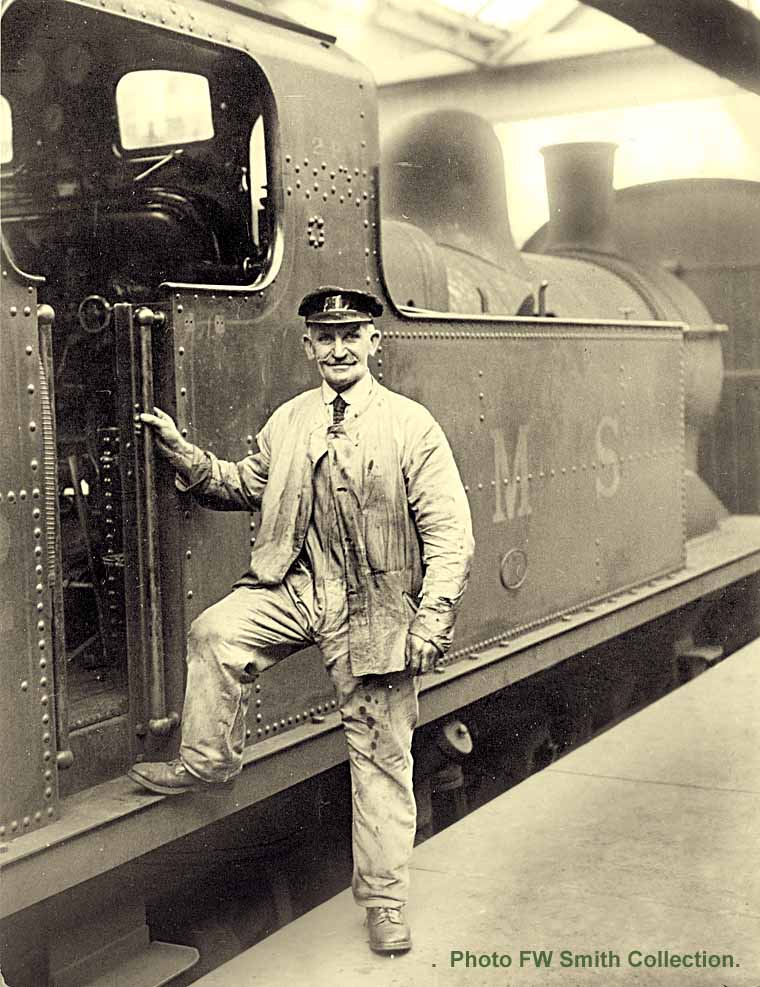
(Above) This is my grandfather, Driver Frank Burgess, at Ilkley station in 1934. Born on 8 September 1869, he started as a cleaner at Manningham shed at 17 years of age before moving as driver to Keighley shed where he worked on shunting engines in Keighley goods yard and later as passenger driver on trains to Leeds and Bradford, Skipton and also the Oxenhope branch. He moved to Ilkley shed in 1915 and retired there in September 1934. He was badly burnt in a fire blowback in Bingley tunnel while working a Skipton train, and was off work for six months. This photo shows him after working his last train into Ilkley before retirement. The engine is Stanier 0-4-4 T 6402 which had been his most regular engine for the previous two years. He died at Ilkley on July 22 1960 aged 90 years. Engine 6402 became 1902 in early 1946 and BR 41902 after 1948. It was withdrawn from service in November 1959.
(Below) Here is another of my Box Brownie photos taken in 1946; it shows Class 2P 4-4-0 323 of 20F Skipton shed on the 4.55pm train from Skipton to Bradford departing Ilkley at 5.28pm. No 323 was built at Derby for the Somerset & Dorset Railway and taken into LMS stock in 1930s. 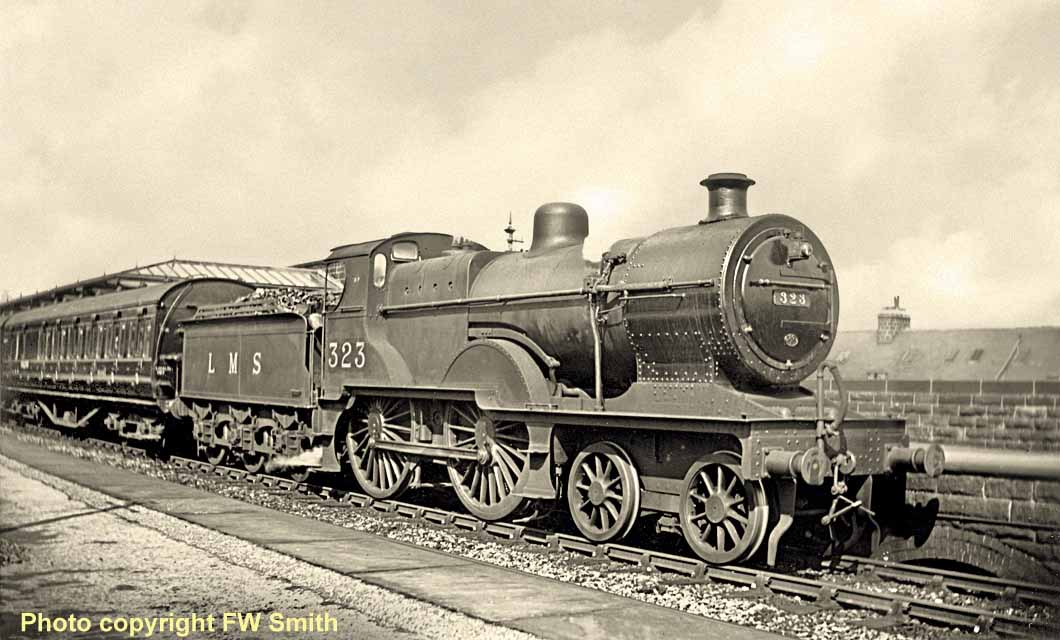
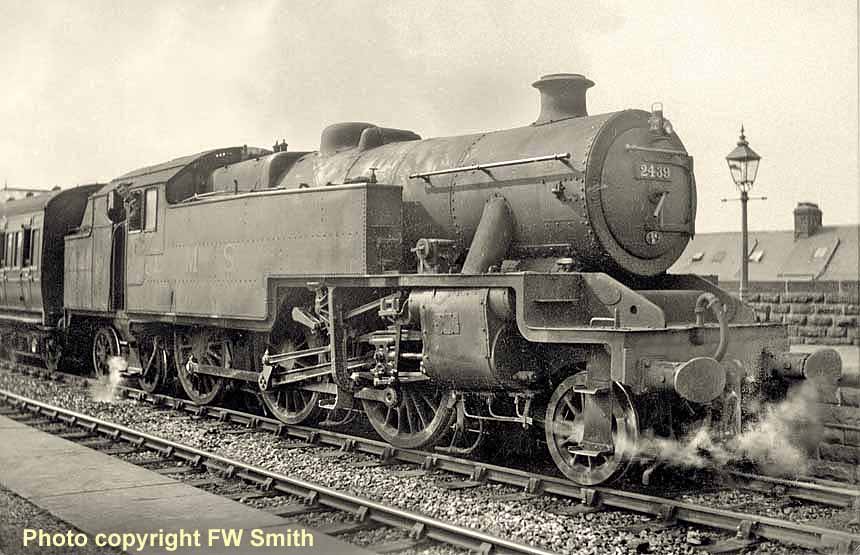
(Above-Below) Stanier 4MT Class 2-6-4T No 2439 of 24B Rose Grove shed stands at Ilkley with the 4.55pm Skipton to Bradford train, departing Ilkley at 5.28pm. Summer 1946. (Below) Ilkley engine shed on 14 August 1939 with Stanier 0-4-4T 6403 and ex-Midland 0-4-4T 1413 in residence. The shed closed 20 years later on 5 January 1959.
The original engine shed of 1865 stood to the south of platform one on the site of the former carriage sidings and the present bus station. But because of smoke there was much complaint, and with the line to Skipton opening in 1888 a new site was selected in January 1889 a little further east on the south side of the line but this was not taken up.
Three years later the Otley & Ilklèy Joint Committee accepted a tender for a new two-road shed on the North side of the line about a ¼ mile east of the station. Orders were given for the demolition of the old shed in December 1892. The stone was used to build the houses in Springs Terrace on the south side of the  Railway. The new shed stood at a level below the main line and had a 7000 gallon water tank plus a 50 foot turntable; during the 1950s I recall either a Gresley Hunt 4-4-0 or a J39 0-6-0 working in from Leeds with Sunday trains and both would amble down to the turntable but only just fit!
Railway. The new shed stood at a level below the main line and had a 7000 gallon water tank plus a 50 foot turntable; during the 1950s I recall either a Gresley Hunt 4-4-0 or a J39 0-6-0 working in from Leeds with Sunday trains and both would amble down to the turntable but only just fit!
On the north side of the shed were two sidings, a sand drying plant and offices. Six LMS and one LNER engine were allocated to Ilkley although engines from 20E Manningham were regular visitors.
The shed's LNER engine, usually a G5 0-4-4T, had 'Ilkley' painted in white on the buffer beams, but never entered the shed; its usual resting place being by the wooden coaling stage on the north sidings. In my days it was usually the push-pull fitted No 1695, later 67337.
There was no Sunday work from Ilkley shed and all engines were dead, their fires being dropped on Saturday night, and since no one was on duty I had the opportunity to wander around at will! Two cleaners were booked on soon after midnight on Monday morning to begin steam raising. Meanwhile the normal Sunday service was maintained by crews working from other depots. The LMS was responsible for coaling the LNER engine and two young cleaners were provided daily for this task. First they had to unload the coal from the wagon onto the coaling stage (see insert right) and then throw it up into the engine's bunker; often the G5 being loaded was one of the hopper types, higher than normal, making it hard work. The cleaners at Ilkley gained an extra task during 1943 and 1944 when bags of soda ash and lime arrived in rail vans for storage. These were stacked against both walls inside the shed and despatched as required for water softening purposes at other  sheds; the reason for storage at Ilkley was presumably as an air raid precaution.
sheds; the reason for storage at Ilkley was presumably as an air raid precaution.
(Inset-Below) In December 1946, Manningham shed's two Stanier 0-4-4 Tanks 1902 and 1903 were replaced by, of all things, two ex-Caledonian 0-4-4 tanks Nos 15030 (inset) and 15192 (below)…both are shunting coaches into number 2 platform or the middle carriage siding in 1947.The Midland men were not impressed but had to put up with them. Next to go were Stanier tanks 1900 and 1904 which were replaced by 15169 and 15227. During 1947 all four could be seen on Ilkley shed overnight and on Sundays. I well remember their melodious Caly hooters whistling to go on shed in the evenings. The Ilkley men also did not like these locos and all four were packed off back to Scotland in August 1948 being replaced by Stanier 2-6-2 tanks. 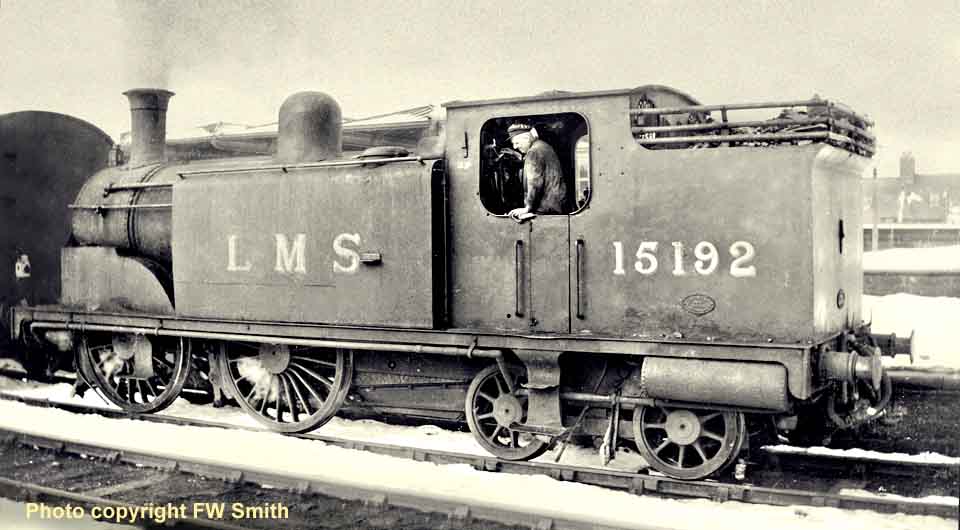

(Above) Two of the locos replaced by the Caly tanks, Stanier tanks 1902 and 1904 on Ilkley shed in 1947. By the late 1950s most passenger services in Wharfedale had been taken over by diesl multiple unit operations. Following closure of Ilkley shed on Monday 5 January 1959, its engines were worked away that morning to Holbeck or Manningham and the redundant shed stood empty until it was demolished in June 1960. Meanwhile the shed's twelve drivers were transferred to Ilkley station joining six guards there. Three DMUs were stabled overnight, with two early departures being operated before anything worked in, and it was not unknown for one of these to be delayed until the arrival of a spare guard from Leeds by taxi!
FOOTNOTE. The following locos were noted on Ilklèy shed on various Sundays:
15 September 1946: 2P 0-4-4Ts Nos 1900 and 1903; 2P 2-4-2Ts No 10636, 10714, 2P 4-4-0 391, 4F 0-6-0 4264; LNER G5 0-4-4T 1912.
8 July 1951: 2P 2-6-2T 41265; 2P 2-4-2Ts Nos 50621, 50622, 50633, 50634, 50795; G5 0-4-4 T 67290.
18 October 1953: Class 3 2-6-2Ts Nos 40112, 40155, 40178; 2P 2-4-2Ts Nos 50621, 50636, 50795.
19 September 1954: Class 2 2-6-2T 41247, Class 3 2-6-2Ts Nos 40112, 40193; Class 2P 2-4-2Ts Nos 50686,50795; Class 2 2-6-0 46453.
20 April 1956: Class 3 2-6-2T Nos 40074, 40112, 40114, 40147, 40178; Class 2P 2-4-2T 50636.
(Below) Ilkley signalman Cecil Chatterton - known to us as 'Chat' - poses in front of 'Hunt' Class D49/2 4-4-0 No 62739 The Badsworth on the turntable at Ilkley in July 1953. This type of engine worked in from Leeds on Sundays. Cecil Chatterton was renowned by loco crews for his ability to position a Hunt class just right on the table for ease of turning. 
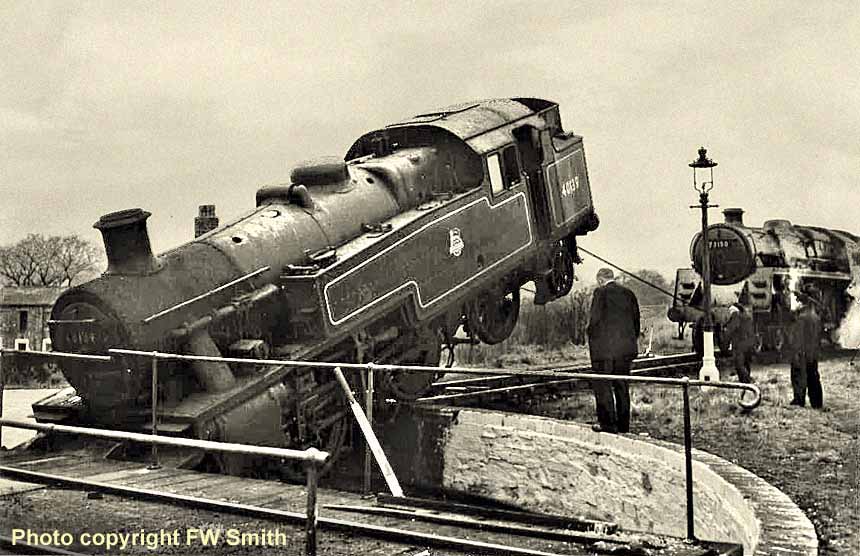
(Above) During the early hours of 9 April 1957 Stanier 2-6-2 T 40139 slid on greasy rails while coming off Ilkley shed and tumbled into the turntable pit which was under repair at the time and not in use. 40139 was re-railed later that same day with the help of Standard Class 5 No 73150 sent from Leeds.
(Below) Having dropped their fires on the Saturday night, Stanier Class 3 2-6-2Ts Nos 40112 ,40114 ,40147 and 40178 plus ex-LYR 2-4-2T No 50636 take up residence inside Ilkley shed on Sunday 22 April 1956. Two cleaners were booked on soon after midnight on Monday morning to begin steam raising.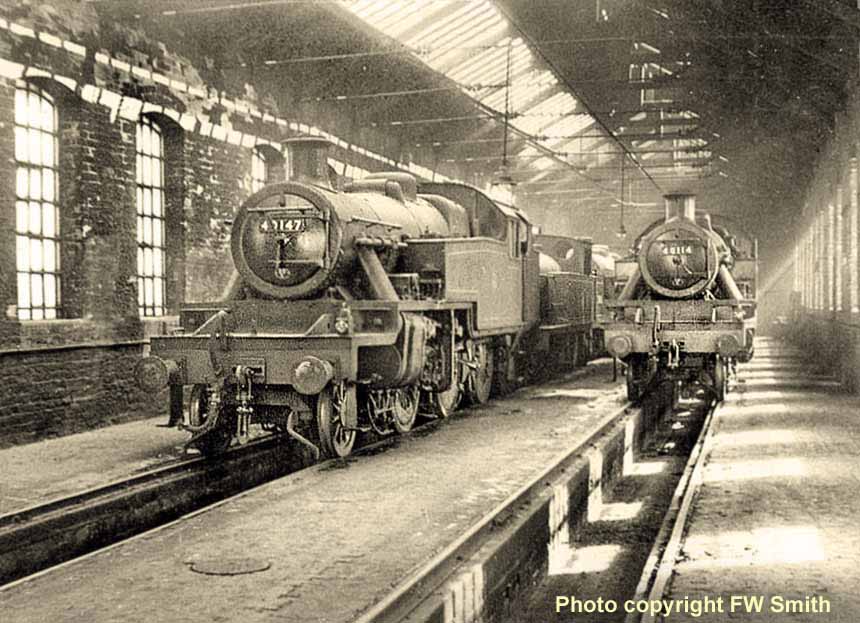
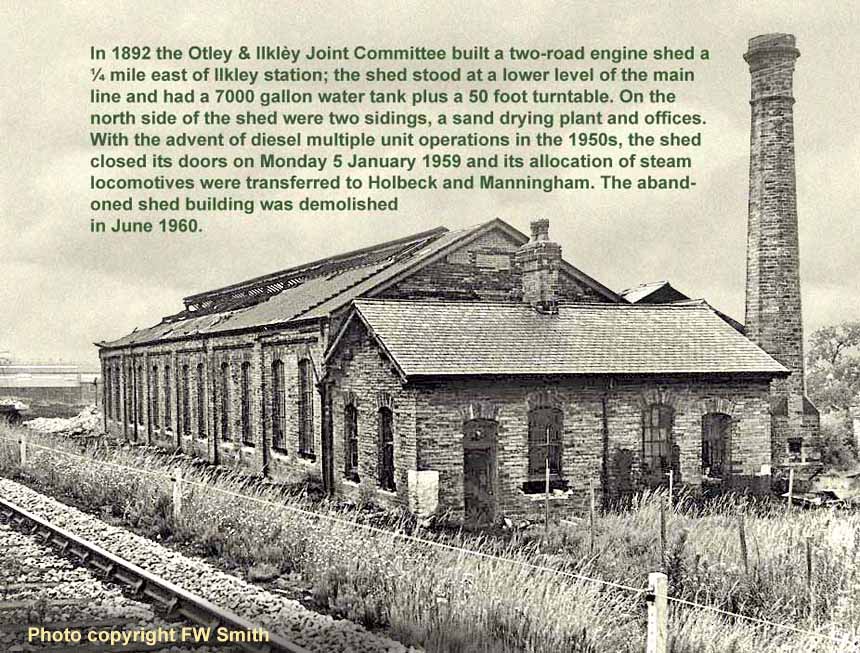

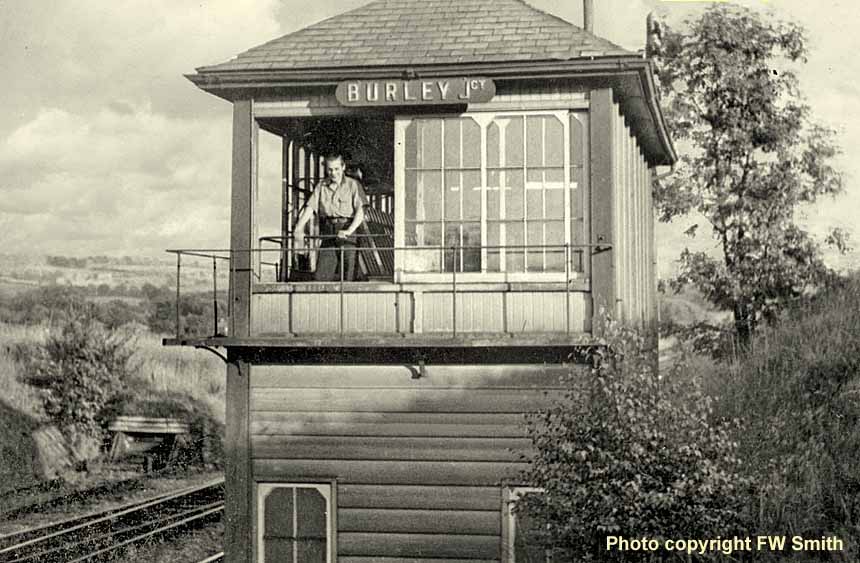 (Above) Here is one of the first photos I took with my Box Brownie. It's of signalman Jack Metcalfe asking me if I would like to come up into the box. Jack's invitation started my many visits to local boxes
(Above) Here is one of the first photos I took with my Box Brownie. It's of signalman Jack Metcalfe asking me if I would like to come up into the box. Jack's invitation started my many visits to local boxes
(Left) My visits to Jack Metcalfe at Ilkley box enabled me to get to know Morris Patrickson at Burley Junction box, and Farrar Fern at Menston Junction box, leading to many further visits to both boxes during the next few years.
This is Burley junction box with signalman Farrar Fern, who allowed me to work the box while he read the paper! I was even allowed to book the time the bell signals were received in the train register. I also studied the Regulations for train signalling which helped me a lot when I joined the Railway years later.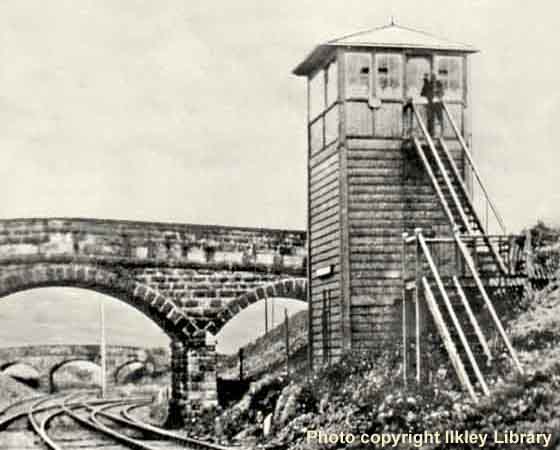 (Inset-Below) Two photos of Menston Junction box. The first box was a small pointsman's affair opened with the line on 1 August 1865. This was subsequently replaced by an exceptionally tall box on the up side from which trains could be seen beyond the over bridge. The third box opened on 24 March 1895. This was on the down side and low enough to view trains through the arch of the offending bridge. Up until the mid-1940s the box was switched out in the Otley direction avoiding having to be open for the Sunday excursions to and from the northeast. By 1946 the switch had been altered to the Burley direction allowing the box to close earlier on weekday evenings. After withdrawal of the Bradford to Harrogate service on 25 February 1957 the hours of opening were reduced to one shift only. By August 1961 the hours were 11-10am to 6-25pm, but only to 1-20 pm on Saturdays. During 1962 the signalman's position was abolished and the box was opened by the Guiseley men on overtime from 11-10am to 1-20pm for the pick up goods, and from 5-20pm to 6-25pm for the benefit of passenger trains in the evening peak. The box closed on 24 July 1966 and all signal arms were removed. The end came on 22 January 1967 when it was set on fire, the junction points and crossings having been replaced by plain line earlier that month.
(Inset-Below) Two photos of Menston Junction box. The first box was a small pointsman's affair opened with the line on 1 August 1865. This was subsequently replaced by an exceptionally tall box on the up side from which trains could be seen beyond the over bridge. The third box opened on 24 March 1895. This was on the down side and low enough to view trains through the arch of the offending bridge. Up until the mid-1940s the box was switched out in the Otley direction avoiding having to be open for the Sunday excursions to and from the northeast. By 1946 the switch had been altered to the Burley direction allowing the box to close earlier on weekday evenings. After withdrawal of the Bradford to Harrogate service on 25 February 1957 the hours of opening were reduced to one shift only. By August 1961 the hours were 11-10am to 6-25pm, but only to 1-20 pm on Saturdays. During 1962 the signalman's position was abolished and the box was opened by the Guiseley men on overtime from 11-10am to 1-20pm for the pick up goods, and from 5-20pm to 6-25pm for the benefit of passenger trains in the evening peak. The box closed on 24 July 1966 and all signal arms were removed. The end came on 22 January 1967 when it was set on fire, the junction points and crossings having been replaced by plain line earlier that month.
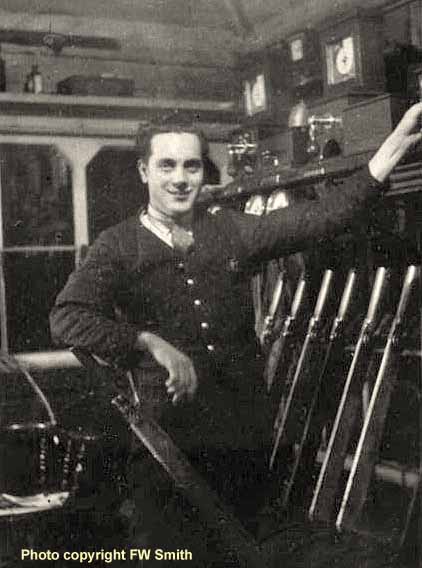 (Right) Farrer later moved to Menston Junction where I regularly visited him after working Saturday mornings at the Yorks Optical Company on Manningham Lane Bradford. I caught a trolley bus to Bradford Forster Square and got the 12.06pm train to Skipton via Ilkley alighting at Menston, where I walked down the line to the box.
(Right) Farrer later moved to Menston Junction where I regularly visited him after working Saturday mornings at the Yorks Optical Company on Manningham Lane Bradford. I caught a trolley bus to Bradford Forster Square and got the 12.06pm train to Skipton via Ilkley alighting at Menston, where I walked down the line to the box.
One of the trains dealt with was the 12.23pm from Bradford to Harrogate which ran as express passenger 4 bells on the block. On this day I pulled over the points and also the home and distant signal and as the train was approaching the box I reached to the bell to give the train entering section signal to Milnerwood Jnct box when I looked in horror at the block instrument I saw it was showing line blocked! I had forgotten to offer the train forward!
At this time section signals were not locked with the block instruments. Farrar said I hope he takes it as I offered it forward to Milnerwood. He did and I gave him train entering section at the same time. Farrer breathed a sigh of relief, and told me watch it in future...I certainly did! Picture taken in oil lit Menston Junction box without flash.
(Below Left) It was in 1952 that I got to know Farrer's mate at Menston Junction box, a chap called Len Goulding. From then on I visited the box every Saturday instead of every other. It was on a Saturday in November 1952 that I was working the box as usual when Len said he was going home to Otley on his motorbike to get changed. He told me that he was going to a dance straight after work and asked if I'd be alright as the next train was not due for 45 minutes? - 'I'll be back long before then,' he said.
Of course I said okay. This was about 5pm and it was pitch black outside and the box was lit by one oil lamp. Not long after Len had left I was settling down to read a Permanent Way alterations book for the following week - when TING! Guiseley box sent a call attention on the bell.
What was this? There were no passenger trains due.
I responded and got a 1-4 bell is line clear for an unfitted freight. Luckily, I knew the signalman at Guiseley and he knew I worked Menston Junction. He told me it was a cattle special for Otley, just one wagon.
I could manage this except that Milnerwood Junction box was closed at 2pm on Saturday afternoons and operations had been switched through from Otley to Burley Junction, therefore the train would have to go via Burley and reverse by running round the train.
Oh dear, this meant I would have to telephone Burley and advise the man on duty, Eddie Binns, who would not put up with an unqualified youth working a box next to his. I did my best to disguise my voice to sound like Len's. It worked! The Burley signalman said he would have to go out to put lamps in a couple of dollies 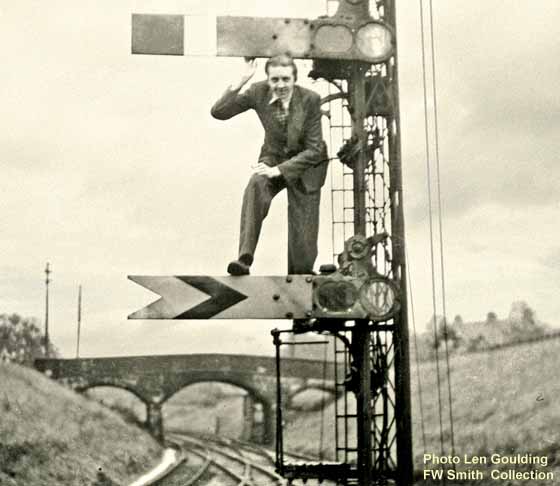 (ground signals). I thought I had got away with it and offered the train forward and pulled off. But the driver wanted the Otley line and approached with a series of pops on his whistle before coming to a stop at the junction signals. This meant a walk with a hand lamp to inform the driver that he would have to go via Burley and run round his train. What he thought of a youth informing him this, particularly one not in uniform, I do not know… but he accepted it and with a pop on the whistle off he went much to my relief.
(ground signals). I thought I had got away with it and offered the train forward and pulled off. But the driver wanted the Otley line and approached with a series of pops on his whistle before coming to a stop at the junction signals. This meant a walk with a hand lamp to inform the driver that he would have to go via Burley and run round his train. What he thought of a youth informing him this, particularly one not in uniform, I do not know… but he accepted it and with a pop on the whistle off he went much to my relief.
When Len returned all dressed up for his night out, he was glad that I had coped and not dropped him in it!
This is a shot of me posing on the up home signal with Menston Station distant; Menston Junction box can be seen beneath the arch of the bridge. The picture taken by the said Len Goulding 
(Below) Menston Junction box in 1952 with signalman Farrar Fern again. A concrete built Elson toilet at the bottom of the steps replaced the rusted metal one under the bridge. Farrar kept hens on top of the embankment opposite the box, and I received the odd egg from him now and again! 

(Above) The 1.10pm from Ilkley to Leeds passes Menston Junction behind ex-Midland 4-4-0 No 40444 on 2 May 1953. Despite its clean appearance, the loco had only two more months to go before withdrawal. The Otley line curves sharply to the right at the start of its 1 in 59 descent to Milnerwood Junction on the Otley & Ilkley Join line.
As mentioned earlier, during the years 1950 to 1957 I visited my pal Farrar Fern at Menston Junction for a session working the box. During one of these afternoon visits on a Bank Holiday Monday in 1952 things got somewhat hectic. The powers that be had organised an engine to be based at Menston Junction for banking trains up the considerable grades to Guiseley if required. The engine concerned turned out to be ex-LYR 2-4-2 T 50636, which was hardly the most powerful loco for the job. Another major problem was where did you put it? Only two places were possible without having to refuse trains. The first option was towards the starting signal to Burley clear of the junction, and the second towards Milnerwood clear of the junction. This had to be done many times to pass trains, involving a lot of shouting and waving of a duster as there were no signals for these moves.
By about 6pm things had got very busy. It began with a Bolton Abbey to Bradford train consisting of a Class 2P 4-4-0 loco with six coaches passed towards Guiseley which was sent out of section to Burley; this was followed by a Morecambe to Leeds train which was immediately offered and accepted. The train of ten coaches was hauled by an ex-LMS Compound, which came to a stand at the home signal. There was still no out of section from Guiseley for the Bolton Abbey train, and after a while the guard of this train arrived to say his train had failed and needed assistance. At last No 50636 was required and sent in with the guard to assist. As the time passed a further train arrived behind a K1 2-6-0 from Wetherby racecourse to Bradford and came to a stand at the home signal. After another wait the fireman of 50636 arrived at the box on foot to say that they could not move the failed train! The next move was to let the Compound hauled ex-Morecambe train in to assist with the fireman of 50636. Another long wait passed before the guard of the Morecambe train arrived at the box to say that they were still stuck! The fireman of the K1 was in the box at the time and said that we should have let him in before the Compound and he would have shifted them. Well, he now had his chance - and so off he went! There were now three trains and four engines in section and after another wait the Guiseley signalman rang to say that all trains had arrived and he was going to sort them out! Farrar breathed a sigh of relief and banking engines were never again sent to Menston Junction.
(Below) This photo shows the said 50636 passing Menston Junction with the 12.40 PM Ilkley to Bradford FS Saturday only train in 1952. Fireman John Milburn gives Farrar a grin! 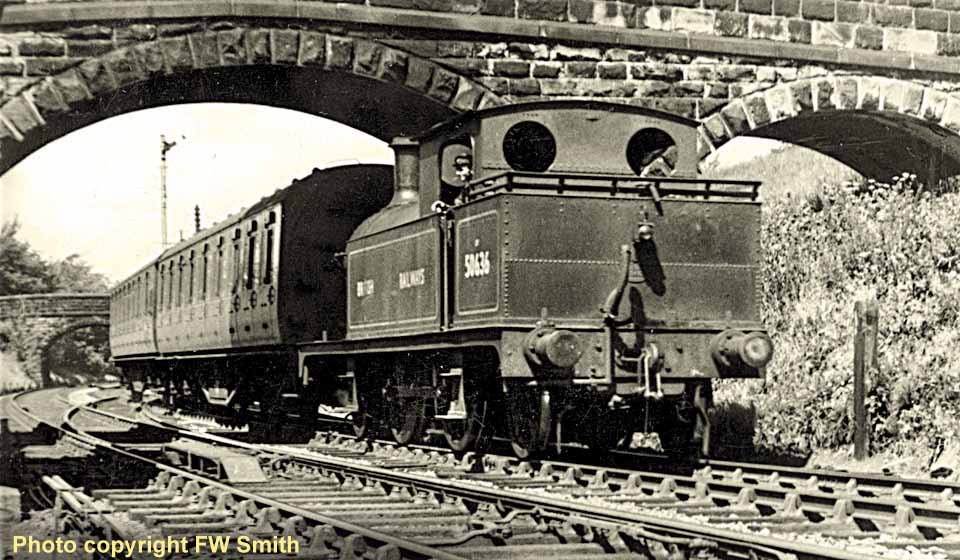
(Below) D49 'Hunt' Class 4-4-0 No 62773 The South Durham passes Milnerwood Junction distant signal on the curve from Menston Junction with a Bradford Forster Square-Newcastle excursion on Sunday 6 July 1952. On arrival at Harrogate this train will be attached to a portion from Leeds with haulage behind an A3 Pacific to Newcastle. 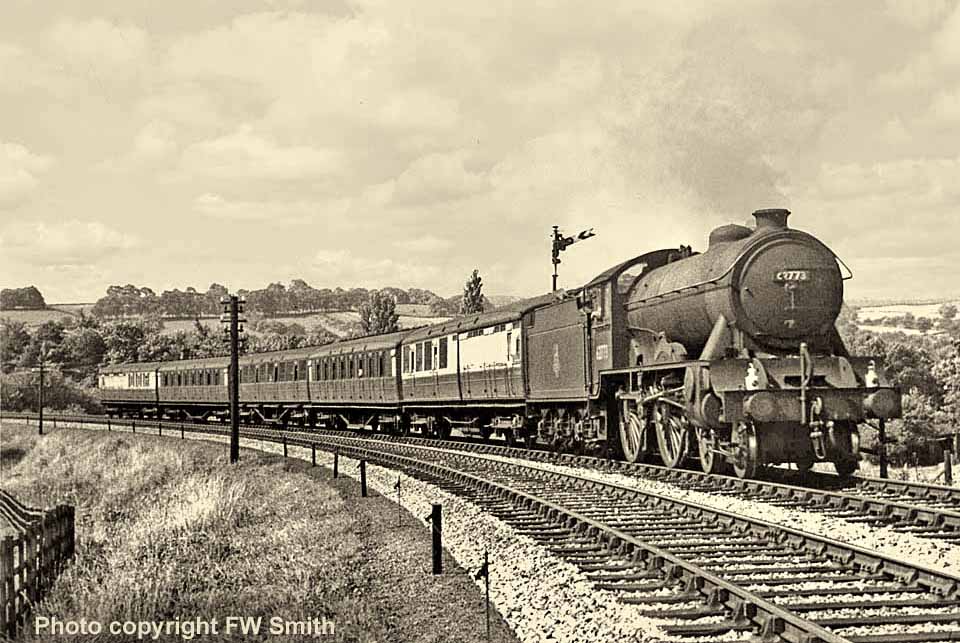
(Below) Fairburn Class 4 2-6-4T 42682 of 20E Manningham shed has just passed Menston Junction's distant signal on the climb from Burley with the Sunday 10.30am from Ilkley to Bradford train on 6 July 1952. 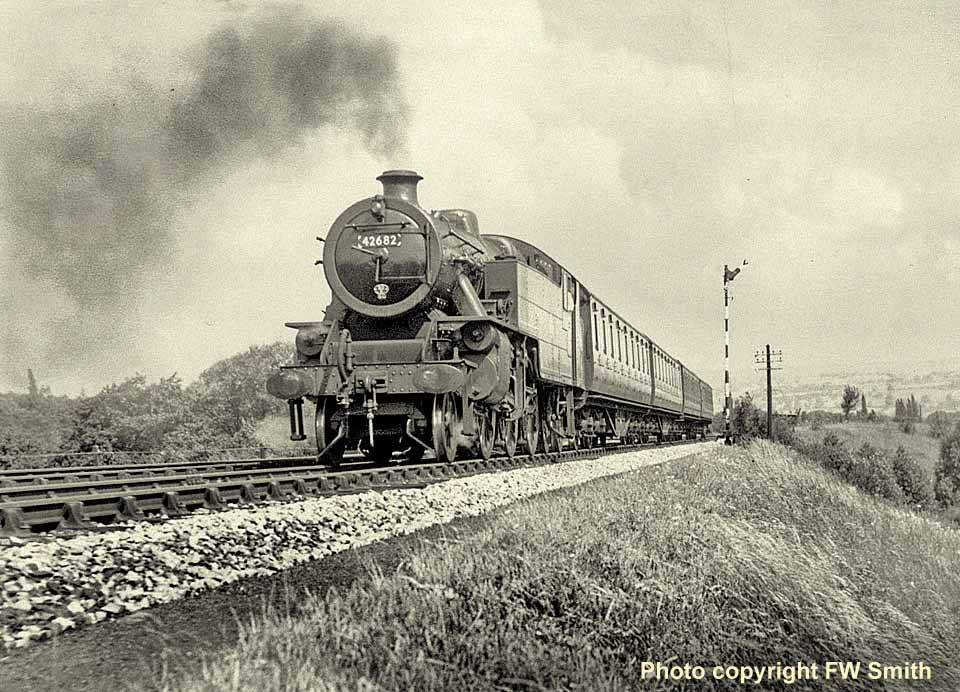
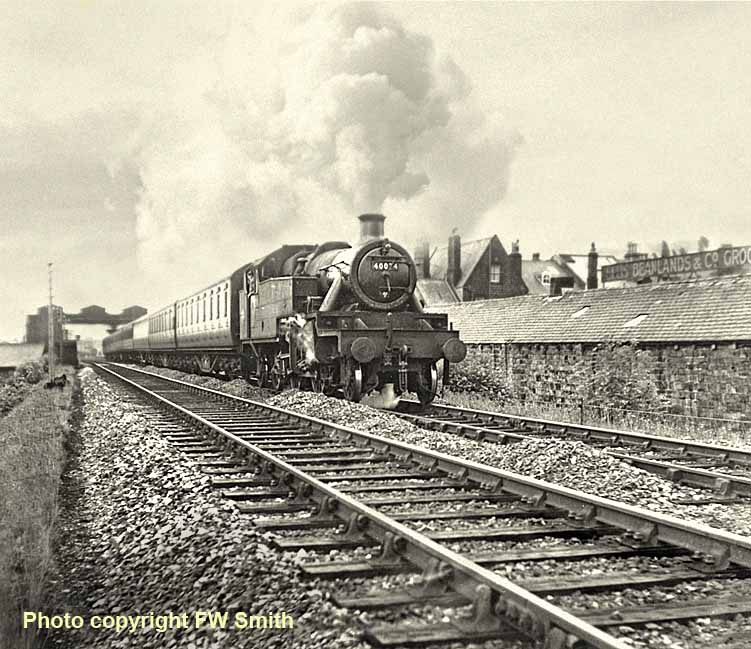 (Inset) Class 3 2-6-2T No 40074 leaves Ilkley with a Leeds to Bolton Abbey extra train on a Bank holiday Monday in 1952. The train consists of eight vehicles which will have made the 1 in 60 climb of Guiseley Bank from Apperley Bridge Junction a difficult task.
(Inset) Class 3 2-6-2T No 40074 leaves Ilkley with a Leeds to Bolton Abbey extra train on a Bank holiday Monday in 1952. The train consists of eight vehicles which will have made the 1 in 60 climb of Guiseley Bank from Apperley Bridge Junction a difficult task.
1947 was known as the year of the 'Big Snow'. The wintry conditions led to severe disruption to all land transport, starting at the end of February until the end of April, but as far as I can recall few blockages occurred as two Skipton Class 4F 0-6-0s coupled tender-to-tender ploughed the Skipton line several times each day. A very unusual engine was ex-Caledonian 0-6-0 No 17615 on snowplough duties from Skipton on 13 March; this was a 30D Ayr engine and Ilkley station took on a Scottish appearance as resident Caly 0-4-4T 15192 was in the station at the same time.
On Thursday 20 February 1947 my recordings of some Ilkley trains are as follows…the 7.50am from Skipton to Bradford departed Ilkley at 8.30am behind Class 4F 0-6-0 4276 of Skipton shed 20F. The 8.33am from Skipton to Leeds via Guiseley departed Ilkley at 9.00am behind Compound 4-4-0 1004 of Manningham shed 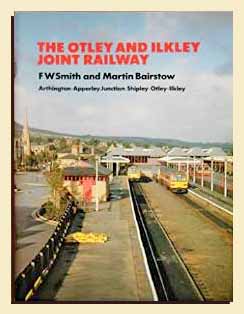 20E. Next recorded was the 12.06pm from Bradford to Skipton via Ilkley departing at 12.46 pm, this being hauled by 2-6-4T No 2548 of Accrington depot 24A. Next the 1.15pm to Leeds via Guiseley had Class 2P 4-4-0 No 414 20F in charge, then in the opposite direction the 1.07 pm from Leeds to Skipton via Ilkley departed Ilkley at 1.56 pm behind Compound 1056 of Hellifield shed 20G. The 4.20pm departure to Leeds via Guiseley was hauled by Class 2P 4-4-0 No 470 also of 20G. The 4.55pm from Skipton to Bradford via Ilkley departed at 5.28 pm behind 2-6-4T No 2438 of Rose Grove shed 24B, and the last noted that day was the 5.00 pm from Bradford, arriving Ilkley at 5.29pm hauled this day by Class 2P 4-4-0 No 567 of 20E shed. The next day the 1.15 pm to Leeds via Guiseley was headed by 2-4-2T No 10633 of 20E.
20E. Next recorded was the 12.06pm from Bradford to Skipton via Ilkley departing at 12.46 pm, this being hauled by 2-6-4T No 2548 of Accrington depot 24A. Next the 1.15pm to Leeds via Guiseley had Class 2P 4-4-0 No 414 20F in charge, then in the opposite direction the 1.07 pm from Leeds to Skipton via Ilkley departed Ilkley at 1.56 pm behind Compound 1056 of Hellifield shed 20G. The 4.20pm departure to Leeds via Guiseley was hauled by Class 2P 4-4-0 No 470 also of 20G. The 4.55pm from Skipton to Bradford via Ilkley departed at 5.28 pm behind 2-6-4T No 2438 of Rose Grove shed 24B, and the last noted that day was the 5.00 pm from Bradford, arriving Ilkley at 5.29pm hauled this day by Class 2P 4-4-0 No 567 of 20E shed. The next day the 1.15 pm to Leeds via Guiseley was headed by 2-4-2T No 10633 of 20E.
(Inset Right) Another excellent book from the Martin Bairstow stable is this one: 'The Otley & Ilkley Joint Railway', co-authored by FW (Bill) Smith...click HERE for details.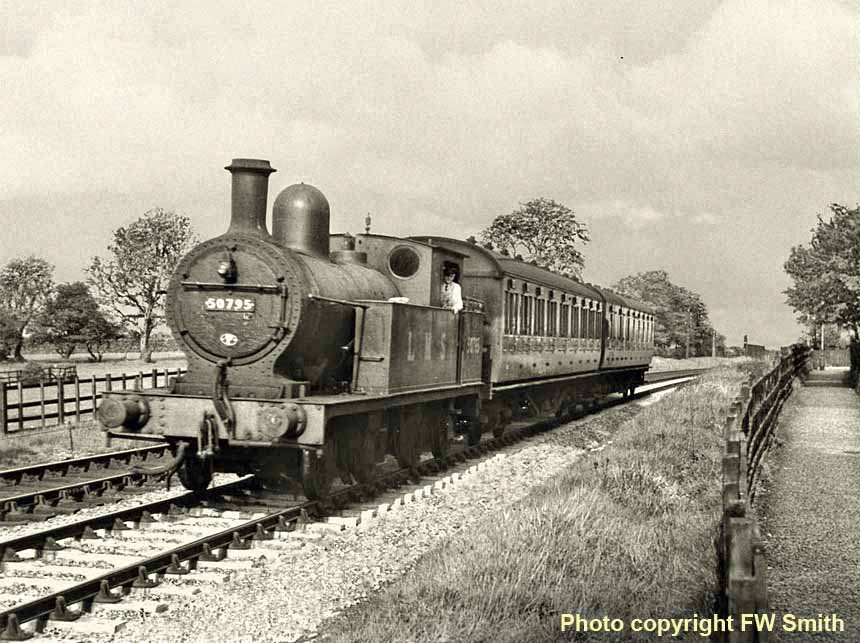
(Above-Below) Ex-L&Y 2-4-2 T No 50795 gets away from Ben Rhydding with the 4.30 Leeds to Ilkley service on 9 May 1953. The engine is still in LMS livery, and it was expected to be withdrawn on its next visit to Horwich Works but instead it was overhauled and returned in lined black. It then worked from Ilkley until 1958. (Below) Stanier 2-6-2T No 40117 departs Ben Rhydding with the 4.22 pm from Bradford to Ilkley on 21 April 1954. The driver is Jack Vallender of Ilkley shed. 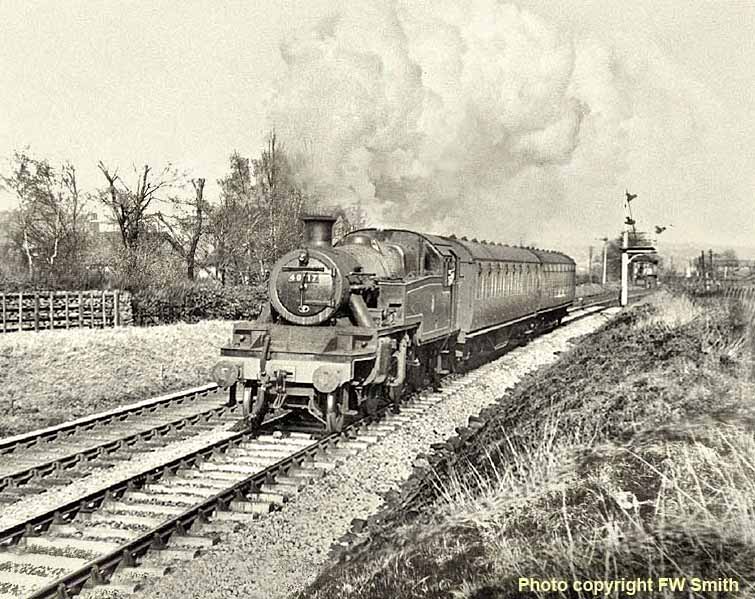

(Above-Below) Class J39 0-6-0 64706 passes Burley-in-Wharfedale with the afternoon Heysham to Tees yard tanker train on Bank Holiday Monday 2 August 1954. In the right foreground porter Arthur Laycock takes a barrow to pick up parcels deposited on the down platform. The tank house on the left is out of use and used as a store for the track gangs tools. Note also the Midland Railway Gallows down starting signal. (Below) On another day the Heysham to Haverton Hill ammonia tank train was photographed near Ben Rhydding hauled by B16 4-6-0 61474 and assisted by 8F 2-8-0 48505 21 April 1954. The 8F was detached at Burley and returned to Skipton.
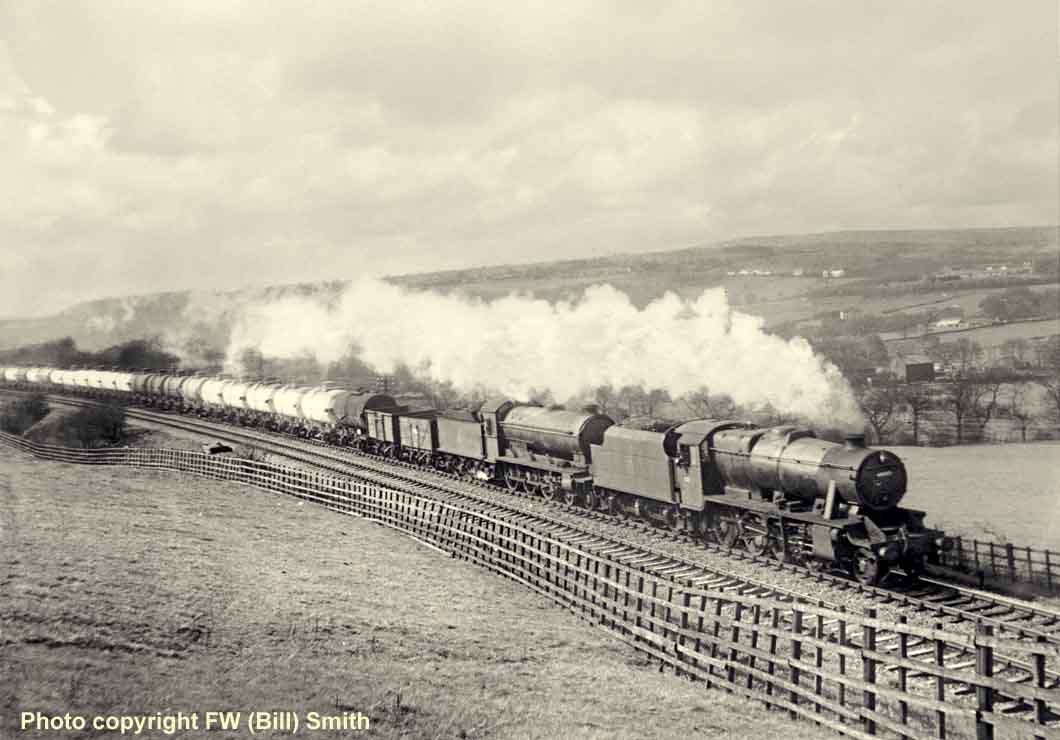
Another special date that springs to mind is 12 November 1947. During the early hours the Eastburn bridge between Keighley and Skipton collapsed under Manningham's Compound No 1004 and all traffic was diverted via Ilkley and Guiseley until bridge repairs were completed early in January 1948, coincidentally the same month the 'Big Four' railway companies were nationalised and British Railways was formed.
To assist the flow of traffic most of the signal boxes on the Ilkley line had to be open continuously. A special timetable was introduced with some Morecambe trains stopping at Ilkley; on one occasion, the 10am express from St Pancras to Glasgow was stopped at Ilkley at the request of a local resident on 23 November 1947. 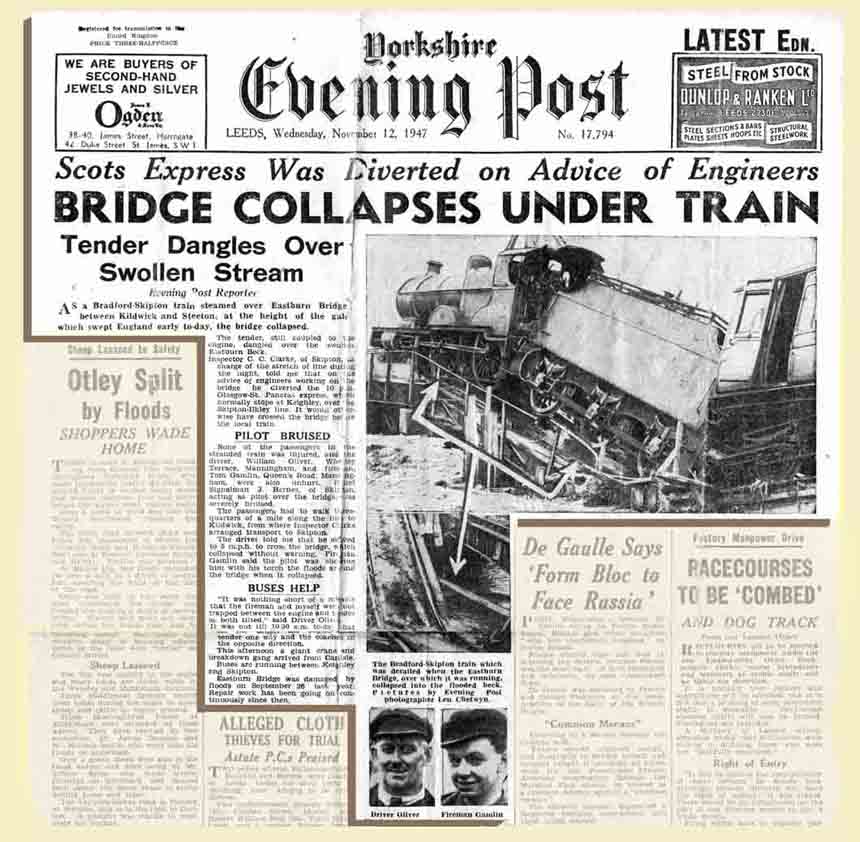
Needless to say the diversions were the 'Tops' for local enthusiasts and many hours were spent on the station or footbridge; LNER coal trains were still running as were the pick up goods trains which had to be fitted in as best they could. To assist this extra traffic a few LNER passenger trains were withdrawn to allow the Otley lines at Burley Junction to be used as lay-bys for goods trains. All throughout the night freight and parcels trains thundered across Ilkley's Brook Street bridge and residents of the houses bordering the Skipton line complained to the LMS company about the noise!
(Below) Ex-L&Y 2-4-2T No 10671 of Skipton shed (20F) at Ilkley platform 4 with a Skipton to Bradford train in 1947…note the horse box 
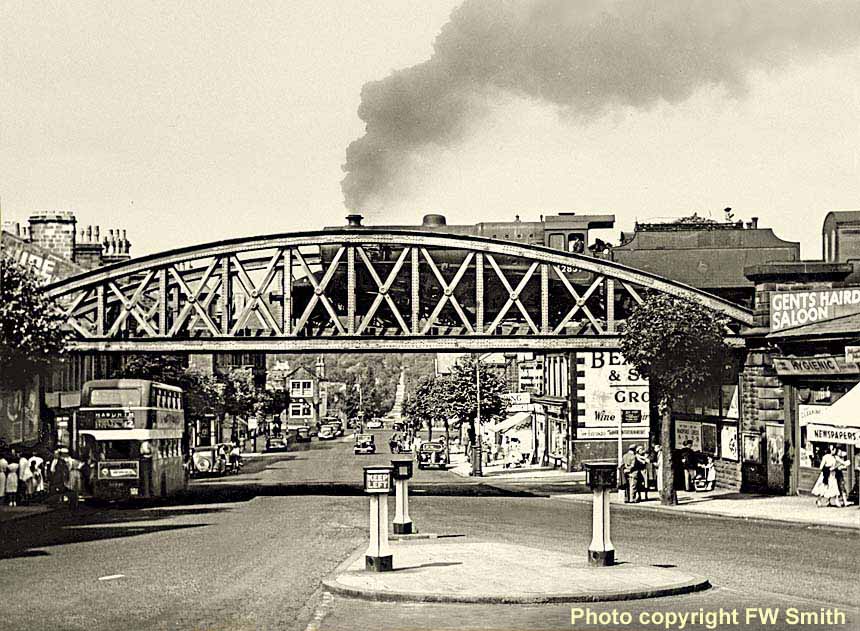
(Above-Below) Hughes Crab 2-6-0 No 42857 crosses Brook Street bridge with a return excursion to Lancashire during the summer of 1955. Following closure of the Ilkley-Skipton line the bridge was demolished in 1966 and the floral castings (roses) on the cross girders were sold on site for 10 shillings each! I have one of the roses from the bridge. (Below) 'Patriot' Class 6P5F 4-6-0 No 45505 The Royal Army Ordnance Corps crosses Brook Street Bridge with the 6.45pm return half day excursion from Whaley Bridge on 15 May 1955. The smoke had been arranged with the driver at Ilkley station prior to departure! 
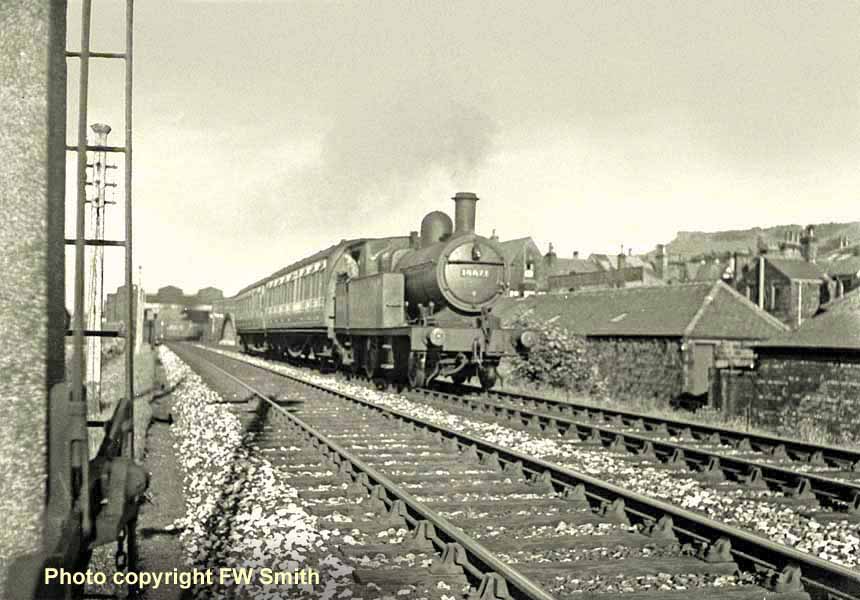
(Above-Below) Brook Street bridge is visible in the background as ex-LYR 2-4-2T No 10671 of Skipton shed (20F) heads a Leeds to Skipton via Ilkley train in the summer of 1947. Just visible on the horizon high up on Ilkley Moor are the famous 'Cow and Calf Rocks', so named because the rock formation consists of a large outcrop and a smaller boulder sitting close to it, like a cow and its calf. (Below) Fast-forward nineteen years and Ilkley Moor still offers spectacular views across Wharfedale, but big changes are about to take place for Ilkley residents following the withdrawal of local passenger rail services to Skipton.On Monday 3rd January 1966, buffer stops were erected at the Skipton end of platform 3 at Ilkley and the arm removed from the starting signal. The up line from Skipton was left clear with the signalling intact for the removal of track by rail.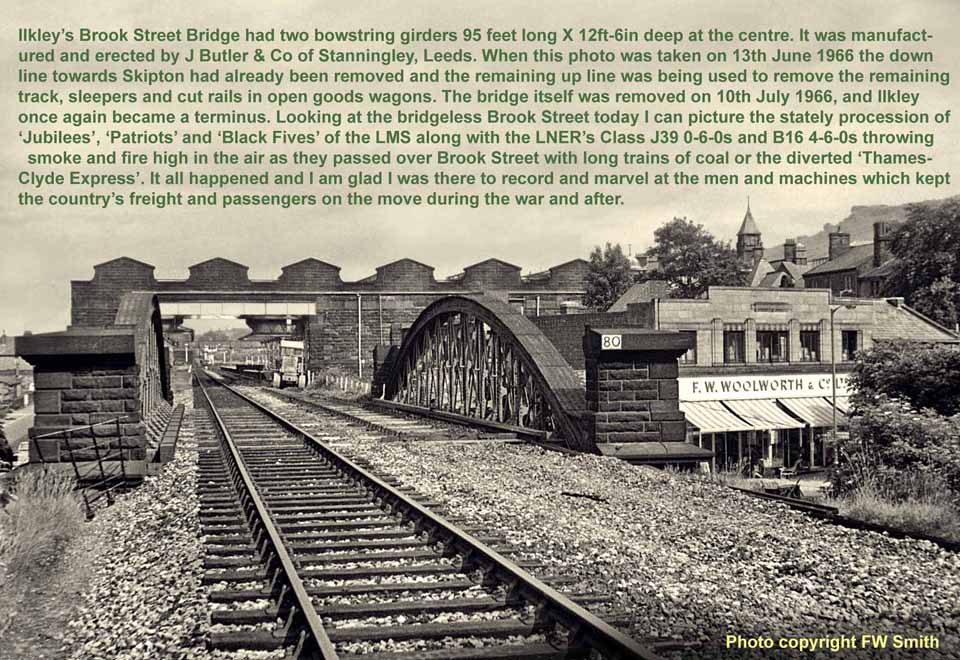
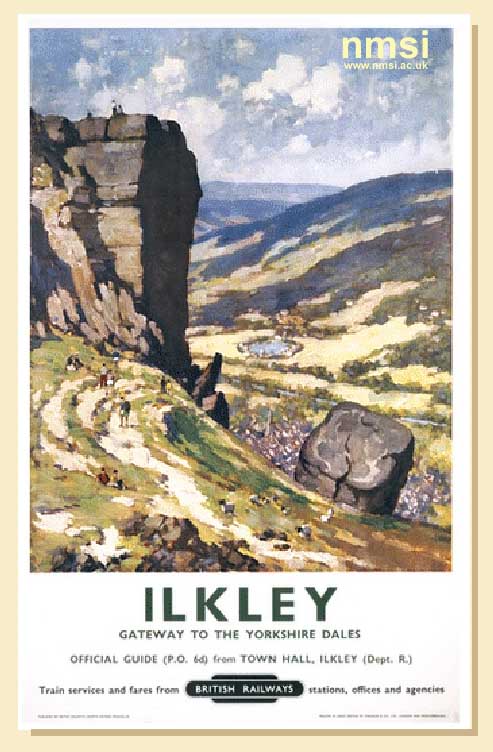 Getting back to the 1947 diversions, on 14 November my spotting pal Ken Wardell and I spent a few hours on Ilklèy station watching the diversions. It was an extremely cold day, and so in between trains we decided to take refuge in the gents toilet where a large stove was burning to keep the water pipes flowing. From inside our less than salubrious shelter we could hear the telltale 'clunk' of the weight bar on the down starting signal being pulled off, but we had to keep nipping out to note the position of the up home signal some distance away by the footbridge. The first train noted was the normal 12.06pm Bradford to Skipton via Ilkley due away at 12.46pm with Ivatt 2-6-2 T No 1206 of Hellifield (20G) in charge. Next a diverted Leeds to Morecambe produced a Compound No 931 and a parcels train on the up had a Class 5 No 4986, followed closely behind by a mixed freight hauled by Class 4F No 4405. An express on the down had 'Black 5' No 5260 and then 'Jubilee' 5604 Ceylon put in an appearance on a Morecambe to Leeds train. Next was a light engine 'Jubilee' No 5643 Rodney heading south followed by the up 'Thames-Clyde Express' behind No 6103 Royal Scots Fusilier of 20A Holbeck shed. The down 'Thames-Clyde' was hauled by another Holbeck 'Royal Scot', No 6109 Royal Engineer. A mixed freight on the down had a Hughes 'Crab' No 2928, and an up coal train had ex-LNWR 0-8-0 9087, while two down coal empties had Class 7F 0-8-0 No 9617 and a Class 8F 2-8-0 No 8129. The NE freights had to be fitted in and B16 4-6-0 No 1450 was noted passing through with coal empties on the up while J39 0-6-0 4818 was on the afternoon pick up goods from Starbeck to Ilkley and return. Meanwhile 0-4-4T G5 No 7319 was noted working the local passenger service via Otley and 2-4-2T No 10634 was employed on the LMS locals. Such was the position until 2 January 1948 when the bridge at Eastburn between Keighley and Skipton was rebuilt and things reverted back to normal.
Getting back to the 1947 diversions, on 14 November my spotting pal Ken Wardell and I spent a few hours on Ilklèy station watching the diversions. It was an extremely cold day, and so in between trains we decided to take refuge in the gents toilet where a large stove was burning to keep the water pipes flowing. From inside our less than salubrious shelter we could hear the telltale 'clunk' of the weight bar on the down starting signal being pulled off, but we had to keep nipping out to note the position of the up home signal some distance away by the footbridge. The first train noted was the normal 12.06pm Bradford to Skipton via Ilkley due away at 12.46pm with Ivatt 2-6-2 T No 1206 of Hellifield (20G) in charge. Next a diverted Leeds to Morecambe produced a Compound No 931 and a parcels train on the up had a Class 5 No 4986, followed closely behind by a mixed freight hauled by Class 4F No 4405. An express on the down had 'Black 5' No 5260 and then 'Jubilee' 5604 Ceylon put in an appearance on a Morecambe to Leeds train. Next was a light engine 'Jubilee' No 5643 Rodney heading south followed by the up 'Thames-Clyde Express' behind No 6103 Royal Scots Fusilier of 20A Holbeck shed. The down 'Thames-Clyde' was hauled by another Holbeck 'Royal Scot', No 6109 Royal Engineer. A mixed freight on the down had a Hughes 'Crab' No 2928, and an up coal train had ex-LNWR 0-8-0 9087, while two down coal empties had Class 7F 0-8-0 No 9617 and a Class 8F 2-8-0 No 8129. The NE freights had to be fitted in and B16 4-6-0 No 1450 was noted passing through with coal empties on the up while J39 0-6-0 4818 was on the afternoon pick up goods from Starbeck to Ilkley and return. Meanwhile 0-4-4T G5 No 7319 was noted working the local passenger service via Otley and 2-4-2T No 10634 was employed on the LMS locals. Such was the position until 2 January 1948 when the bridge at Eastburn between Keighley and Skipton was rebuilt and things reverted back to normal.
(Below) Stanier 'Black 5' 4-6-0 No 44813 was photographed passing through platform 4 at Ilkley with a southbound freight during another diversion on 21 June 1953.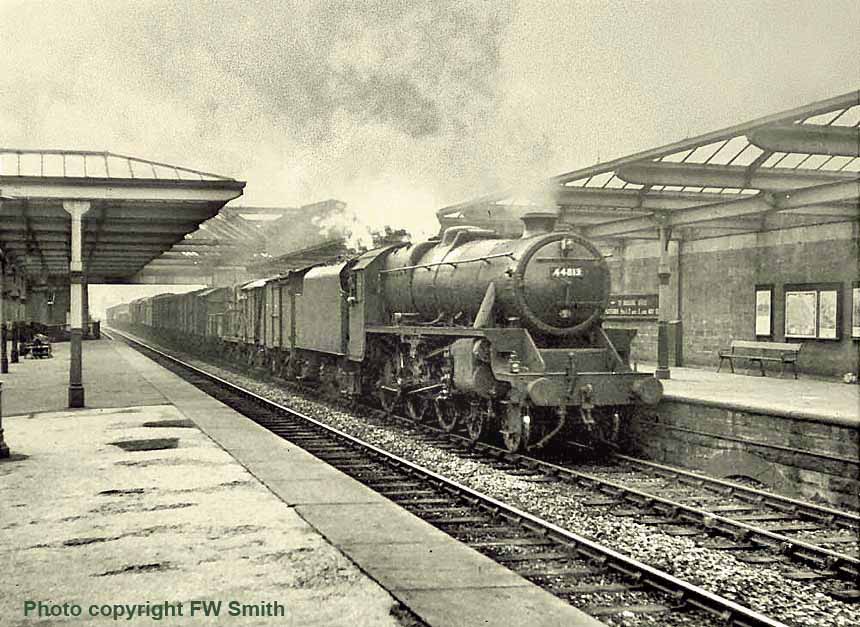
RAILWAYS THROUGH WHARFEDALE - 2
Starting Work
Having left Ilkley Grammar School in July 1947, I started work at the Yorks Optical Company on the corner of Queens Road and Manningham Lane, where I spent the next ten years constructing spectacle frames and polishing them. I travelled to work on the 7.15am from Skipton to Bradford, departing Ilkley at 7.40am and getting off at Manningham. I returned on the 5.50pm Bradford to Skipton via Ilkley which did not stop at Manningham, so I had to get the trolley bus into Bradford Forster Square. During the first year this was regularly worked by Class 2F 0-6-0 No 3078 of 20E Manningham shed; the train was always hauld by a freight engine as it worked a goods back from Skipton to Bradford Valley goods yard.
Over the years the regular locos were Class 3F 0-6-0s Nos 43742 and 43770, also Class 4F 0-6-0s Nos 44216 and 44400. These locos monopolised this train until 20 September 1955 when it was rostered to be worked by a big engine as a filling in turn between mainline duties, however after arrival at Skipton the locomotive was no longer involved in a return freight working; instead it was turned and then worked a train of four empty corridor coaches to Ilkley where it formed the 8.40pm departure to Leeds via Guiseley. The working of the 5.50pm by a big engine lasted until 23 March 1956 when the goods engine roster was reinstated.
During the seven months of big engines working the 5.50pm I looked forward to my journey home each evening. The first working on 20 September 1955 produced 'Jubilee' 4-6-0 45639 Raleigh which dwarfed its two coach train. The next day Class 4F 0-6-0 No 44216 returned and I thought the Jubilee must have been a one off. But the following day, 22 September 1955, Class B1 4-6-0 61288 was in charge. This was fantastic for the Wharfedale enthusiasts, and there was quite a gathering at Ilkley each evening as the locos blasted away to Skipton!
Other locos employed were 3/10/55 No 45572 Eire; 4/10/55 BR Standard 5 73066; 10/10/55 'Black 5' 45274; 11/10/55 BR Standard 5 73010; 13/10/55 'Black 5' 44849; 21/10/55 Jubilee 45731 Perseverance; 24/10/55 'Black 5' 44755; 25/10/55 BR Standard 5 73045; 28/10/55 'Black 5' 44754 and 31/10/55 another 'Black 5' No 44753.
The following day 1/11/55, I had got to know the Holbeck loco crew and they offered me a footplate ride on 'Jubilee' 45700 Amethyst - I did not turn it down! I remember the racket going through Esholt tunnel and the fire reflecting from the tunnel roof. I was told to get back in the train at Ben Rhydding to avoid being seen leaving the footplate at Ilkley. The following Friday 4/11/55 I did the same on 'Black 5' 44857 and asked when they would be on this turn again. In eight weeks time was the reply but I never saw them again.
Other locos employed were 'Hunt' classes 4-4-0s Nos 62745 The Hurworth and 62740 The Bedale; 'Jubilee' classes 45619 Nigeria, 45675 Hardy and 45568 Western Australia; 'Black 5' 44983 plus Class B1s Nos 61016 Inyala and 61115.
There were many more, mainly Class 5 4-6-0s, but it all ended on Friday 23 March 1956, and on the following Monday Class 4F 44216 was back in charge and the spotters vanished!

(Above-Below) Viewed from the footbridge spanning the eastern approach to Ilkley station, Holbeck's Ivatt Class 4 2-6-0 No 43117 arrives with the 1.40pm six coach train from Leeds to Skipton via Otley on a Sunday in July 1955. Visible on the right are the carriage sidings and goods yard now occupied by a supermarket. On the left is Ilkley signal box, which provides this view (below) of a Class 108 2-car set departing platform 1 on the 16.30 service to Bradford on 7 June 1983. 
Due to short sightedness, I had been unsuccessful when first applying for a job as a signalman in 1948, and so I invested in a pair of contact lenses and tried again in February 1958. This time I passed the medical with flying colours, not telling them about the lenses of course!
The only job available was for a Porter Signalman at Embsay Station, which required a 7.00am start for the early turn. This was possible by catching the 5.50am bus to Keighley and getting off at Steeton Top, then catching a bus to Skipton followed by a Skipton to Embsay bus which arrived there at 7.00am in good time to book any passengers for the first train at 7.06am.
These travel arrangement were okay for the first year or so until an empty DMU was put on from Ilkley to Skipton departing at 7.00am. The timing was of little use to me, 7am was the time I started my shift, but most drivers and guards wanted to be away about 6.45am to give them more time in Skipton. This suited me fine as they dropped me off at Embsay about 7.00am, but one particular guard refused to depart Ilkley before the booked time therefore I failed to arrive at Embsay in time to book the two regular passengers for the first train!
The Station Master Harry Turner was not a happy man!
The station was down a few shillings every day that week, which may not sound much by today's standards but Embsay only had five regular passengers each day, and my lateness meant the takings were reduced considerably!
I was booked off for dinner each day for one and a half hours, which meant I did not finish till 4.30pm and as the next train home was the 5.06pm to Bradford I didn't get home on my bike until about 5.40pm. I was due on the late turn at 10.00am which meant leaving Ilkley on the 8.50am bus to Skipton and getting off at the bus stop just beyond the railway bridge on the A6069 Otley Road into Skipton, then scrambling up the bank onto the railway line, walking through Haw Bank Tunnel and past Embsay Junction (below) arriving at Embsay Station at about 9.45am. My journey home on this turn necessitated taking the last train into Skipton at 6.40pm and then catching an empty train leaving Skipton about 7.15pm, arriving home about 8.00pm.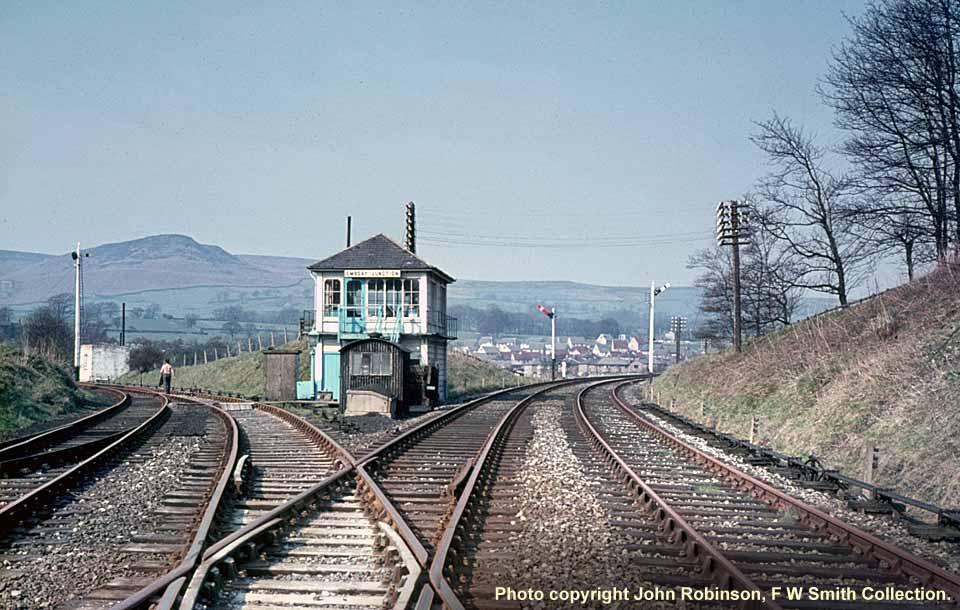
(Above) A general view of Embsay Junction showing the Grassington branch curving away to the left and the line to Ilkley directly ahead. The signal box was opened with the Grassington branch in 1902. Its hours of opening in later years was Monday to Friday 9.45am to 4.55pm, Saturdays 9.45am to 2.55pm; the box was closed on Sundays. When Embsay Junction was closed the block section was some 11 miles in length from Skipton Station North Junction to Ilkley. Prior to the Skipton Rock Company ceasing to use the railway for transporting stone in October 1968 the signalman at Embsay Junction travelled up with the train to operate Embsay Station box, this was after the passenger service had ceased in March 1965. The box was finally closed on 6 July 1969 and the branch was worked as a single line from Skipton to Grassington under one train only regulations. The photo was taken in the Summer of 1966 by John Robinson when the box was painted in the blue and white of the North Eastern Region.
(Above-Below) This signalling and track plan of Embsay Junction is one of two diagrams reproduced courtesy RD Pulleyn; a second diagram of Embsay station is featured further down the page. (Below) Jubilee 4-6-0 45571 South Africa of 24E Blackpool shed storms through Embsay with a Blackpool to York excursion on Whit Monday 22 May 1961. Following closure of the Skipton-Ilkley line in 1965, a group of volunteers set about the task of reopening the line in 1979. Today Embsay station forms the base of the Embsay & Bolton Abbey Steam Railway which runs a service on the 4-mile stretch of line to Bolton Abbey, with the long-term objective of extending the service a further two miles into Skipton station and the exciting prospect of a rail interchange with the Aire Valley Line. Click HERE to visit the Embsay and Bolton Abbey Railway's website.
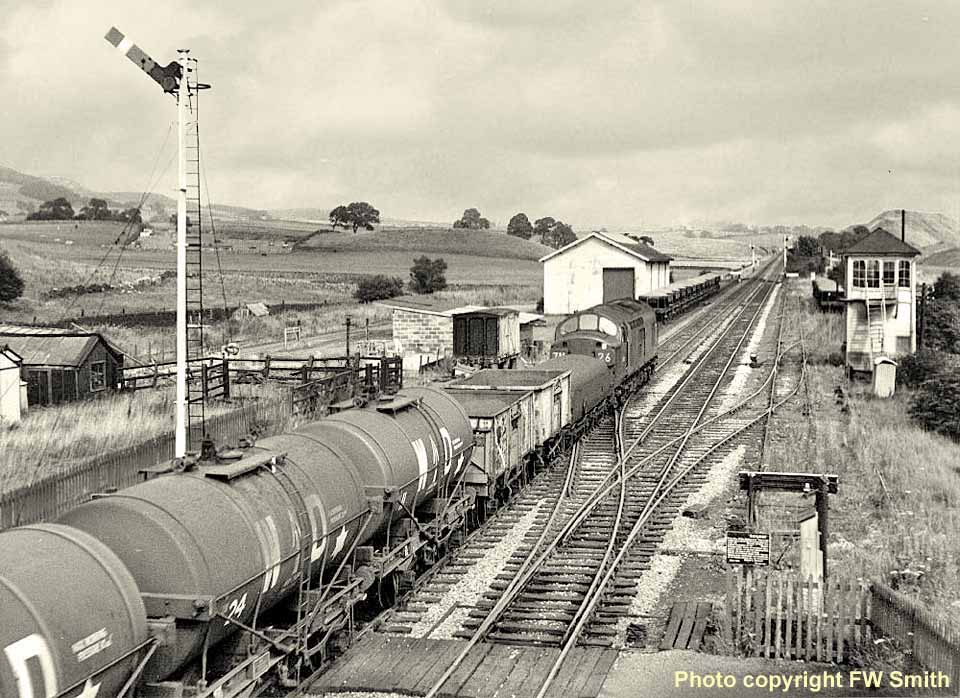
(Above) English Electric Type 3 Co-Co D6772, later TOPS Class 37 No 37072, passes Embsay with the 7N54 Heysham to Tees Yard tank train on 4 August 1964. Note the brake tender next to the locomotive. Loaded ballast hopper wagons are stabled on both sides of the main line awaiting departure on special trains to the London Midland Region.
During 1959, for economy reasons, the Skipton 64 trip pick-up goods from Skipton to Guiseley and return was withdrawn and the shunting duties were undertaken by the Starbeck crew on the ammonia and oil tank trains. This arrangement was treated with disgust by the Starbeck enginemen and guards who could never accept the fact that they had to perform such undesirable chores, hence if they were stopped by signals at Embsay and informed that some ballast wagons required picking up for consignment to Skipton, a heated argument sometimes ensued, but we usually won the day by threatening to prevent their train from proceeding unless the wagons were picked up.
On one occasion, 11 September 1959, the morning working from Skipton had to pick up a wagon of coal for Addingham which had been left in the up sidings from the previous day because no signalman had been available to open Addingham box.
A look of shocked disdain appeared on the face of the driver of J39 0-6-0 No 64855 who, as usual, did not want to do the job. Things were made worse when the driver was informed that he would have to put his train in the sidings to enable the 10.5am DMU from Skipton to Bradford to pass.
Eventually he grudgingly agreed and the train of oil tanks was placed in the siding alongside the goods shed. At this point, all would have been well had the driver not been so impatient to save time by picking up the wagon of coal in the back siding; the outlet points were set for the short dead end siding owing to the DMU being signalled on the main line. Entering this siding involved running over some double slip points which were covered by a thick layer of rust on the rail tops and probably hadn't been used since Victorian times; indeed some of the sleepers were little more than hollow shells.
When I saw the engine setting off into the dead end siding, there was nothing I could do to stop it. The inevitable happened when 64855 returned over the points leading to the back siding; there was an almighty bang as the track gave way, followed by a cloud of rust and escaping steam as the engine's safety valves lifted owing to the turbulence in the boiler. The red faced driver eventually came to the signal box to report his predicament and, as things transpired, rather than saving a few minutes of his time, he finished up being delayed until well into the afternoon before his engine could be rerailed by the tool vans which arrived from Skipton hauled by 8F 48126.
However, much to the relief of the Starbeck crews, as from 14 September 1959 the Starbeck turn reverted to a through train working again and the Stourton to Ilkley No 87 trip pick up was extended to Skipton and return to handle this additional work.
(Below) One of my jobs at Embsay was helping Station Master Turner with the station gardens. One morning I was cutting back the grass growing through the fence on the up platform (left foreground) and suddenly noticed something white. On further investigation this proved to be five freshly-laid hens' eggs. These were of course removed, and the following day there were three more! I couldn't believe my luck; this could go on for months I thought. The hens in question were kept in the next field, only this psticular hen must have been feeling unsociable and wanting to be alone. Anyway it kept both Mr Turner and myself well stocked with eggs for over a week until one morning I went to collect the eggs and found a pathetic little pile of chicken feathers. A fox had made a meal of our benefactor and we had to buy our eggs again.
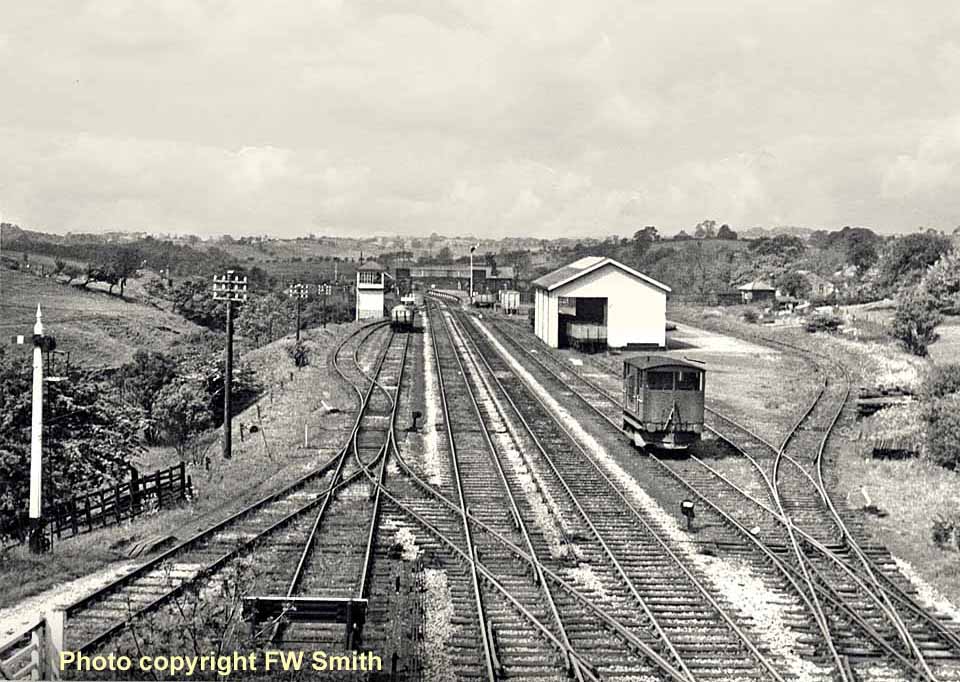
(Above) This shot looking towards Skipton was taken from the top of the down home signal during my lamping duties in the summer of 1959. The line on the left leads into the private siding of the Skipton Rock Company. Controlling the exit from the siding is the small Midland signal which was left in the clear position when the box was closed to allow loaded hopper wagons to be run into the loop line by gravity.
However in 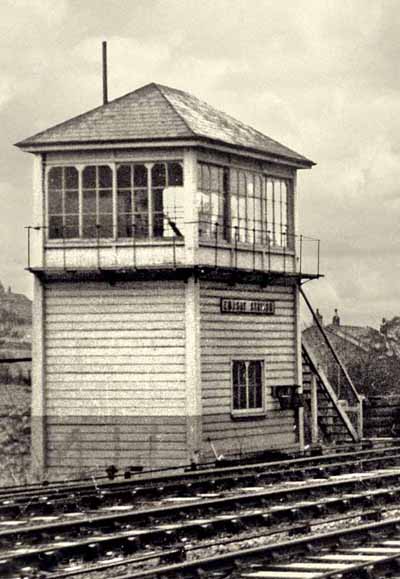 1957 this practice was decreed dangerous by the Railway Authorities and henceforth the signal was left in the danger position and the wagons were collected from the siding. Note the plough brake van used for spreading the ballast in the up siding on the right.
1957 this practice was decreed dangerous by the Railway Authorities and henceforth the signal was left in the danger position and the wagons were collected from the siding. Note the plough brake van used for spreading the ballast in the up siding on the right.
(Inset-Below) The existing box opened in July 1923 having replaced an earlier structure, and was closed by BR on 21 October 1968. It is still in existence and is operated by the Embsay and Bolton Abbey Railway. In BR days it was operated by a Porter Signalman and only open for shunting purposes. The porter signalman's other duties were booking passengers and charging for parcels, booking arrived parcels on delivery sheets, changing the signal lamps each week. Also lighting and extinguishing the station oil lamps in the winter months, and emptying the Elsan toilets in holes previously dug!
At the box the up starting signal number 4 was free and did not require a line clear release on the block instrument. The down starting signal number 12 was locked with the block instrument and required a line clear release from Embsay Junction box. This signal was also Embsay Junctions outer home signal and the arm would not clear until the levers in both boxes had been pulled over. A track circuit on the down line extended from the platform end by number 6 points to a short distance past the down starting signal 12. This track circuit was also indicated in Embsay Junction box and a special bell signal had to be sent from station box when this track circuit was occupied by a shunting movement. The Midland Rotary Block system was in use on the down line from Bolton Abbey box to Embsay Junction and a release treadle was situated after number 13 home signal. I have visited the box several times to the present day, and the same levers that I pulled all those years ago from 1958 are still there, although most not working the same things..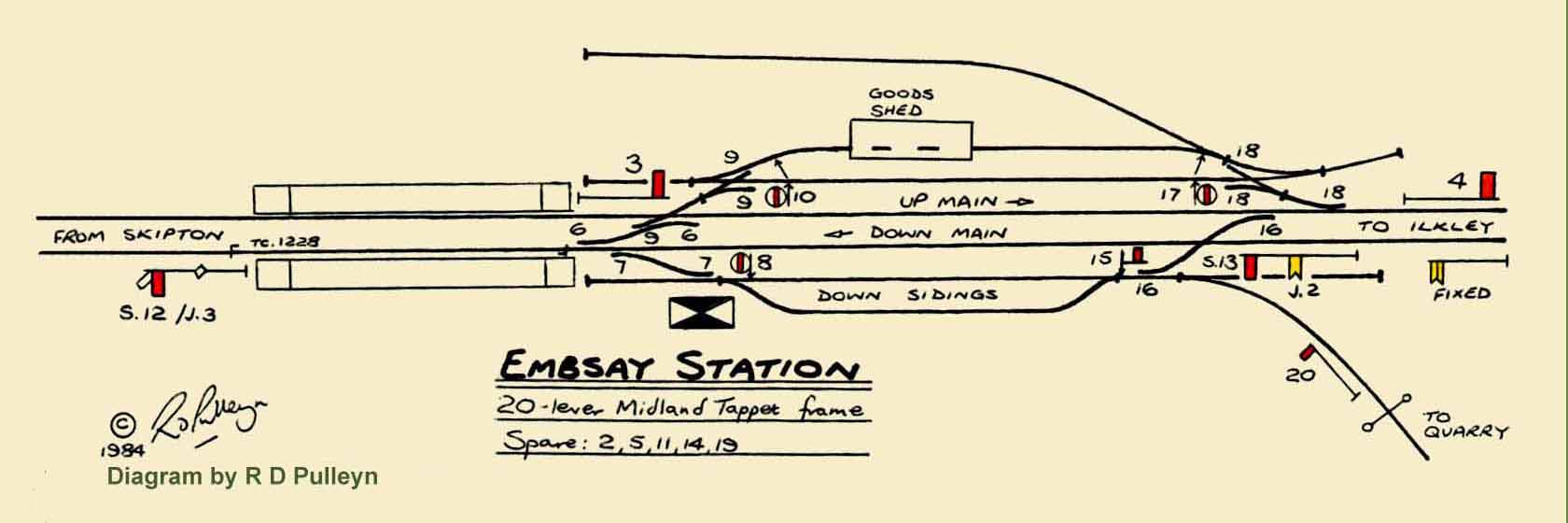
The year 1964 started with a bang! I was on the early turn at Embsay signal box on Friday 10 January and at about 11.20am I was polishing the brasses in the box, which was switched out, when my attention was distracted by the sharp cracking sound of splintering wood from the direction of the quarry siding.
I looked up in time to see the demolition of the substantial gate that was always kept shut across the Skipton Rock Company's quarry siding to prevent sheep from wandering onto the main line. A loaded 25 ton hopper wagon was the cause of the trouble; these hoppers were brought down to the gate pushed by a road tractor fitted with a large steel bumper bar; this was the only motive power used by the quarry for many years, however on this occasion the hopper had obviously escaped from the quarry employee!
Gathering speed, it crashed through the gate on the falling gradient towards the signal box vainly pursued by two quarry men. I immediately grabbed a shunting pole, which was always kept handy, and then rushed down the box steps in the hope of dropping the brake handle and pinning it down using the pole. But the hopper passed me doing 25 miles an hour and I quickly got out of its way!
It knew it could not escape as the points were set for the buffer stops at the end of the short head shunt, so I just held my breath and waited for the bang!
The impact sounded like a high explosive bomb and must have been heard all over the village. Station Master Turner came rushing out of the booking office and together we inspected the damage. Not only had the buffer stop been pushed back about a yard, breaking the bolts holding the connecting fish plates, the point rodding at the back of the buffers had also been damaged, and half the load of ballast had shot out covering everything within range. We were able to pull the hopper back with the pick up engine, and after an inspection by the Carriage & Wagon Dept it was allowed back in traffic. 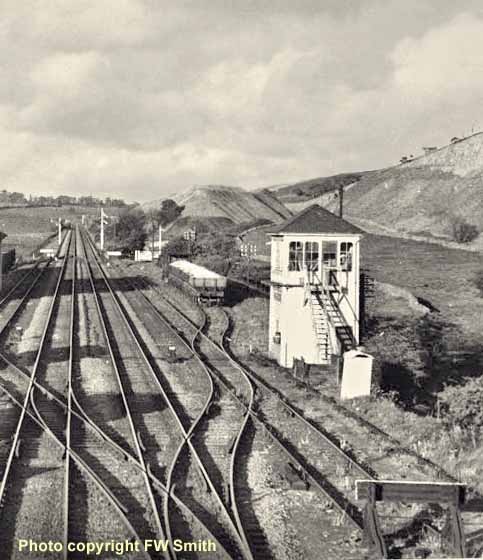 (Inset Right) This picture shows loaded hoppers in the loop and others at the gate, also the buffer stop in the right foreground into which the wagon crashed.
(Inset Right) This picture shows loaded hoppers in the loop and others at the gate, also the buffer stop in the right foreground into which the wagon crashed.
(Below) A view of the Skipton Rock Company's private siding where a loaded hopper wagon is waiting to be collected just beyond the gate. Up to ten hoppers would be assembled at the gate and these were pulled into the loop line before the empties could be put in. The empties usually arrived on the morning pick up departing Skipton at 10am, or on occasions they could arrive on special trains at any time of the day. The phone would ring and Skipton Station North Junction signalman would say - 'Train of hoppers on the way up for you.' Then it would be all systems go with Station Master Harry Turner directing operations as he did not trust the guards. The empties would be left on the main line while the engine would cross onto the down sidings to pull out any loaded hoppers from the Rock Company's siding and leave them in the loop. However if the loop was full, then the engine would pull them onto the down main and then propel them onto the up siding at the side of the goods shed. The empties would then be collected off the up main and pulled across onto the down main clear of number 6 points and then with a duster waved from the signal box steps the loco would reverse the empties through number 7 points and then through the hold up hand points into the quarry siding. This hand point (clearly visible in the right foreground) was always held over by Station Master Turner as he did not trust any guards to do the job as the hoppers were fly shunted over the points at high speed! The plough brake van would then be placed in the short dead end siding and the loco would be off back to Skipton.
The following is a selection of locos departing Embsay to various destinations in Lancashire with ballast trains: 8-1-59 42882 Crab 2-6-0 to Thornton Cleveleys; 18-2-59 92015 9 2-10-0 to Edge Hill; 27-2-59 42951 Stanier 2-6-0 to Poulton; 26-3-59 70044 Earl Haigh to Arkholme; 25-8-59 49674 7F 0-8-0 to Earby; 18-11-59 45706 Express Jubilee 4-6-0 to Todmorden; 2-3-60 92161 9 2-10-0 to Rishton; 17-6-60 48080 8F 2-8-0 to Adlington; 11-8-60 92016 9 2-10-0 to Moses Gate; 20-9-61 42765 Crab 2-6-0 to Radcliffe; 18-10-61 45585 Hyderabad to Earby; 16-2-62 45700 Amethyst to Salwick; 14-8-62 43999 4F 0-6-0 to Hornby; 22-11-62 44692 5 4-6-0 to Bamber Bridge; 21-3-63 90369 WD 2-8-0 to Blackrod; 8-3-63 Two trains 44149 4F 0-6-0 and 42721 Crab 2-6-0 both to Crosby Garret; 3-10-63 45597 Barbados to Daisyfield; 11-10-63 45611 Hong Kong to Skipton; 15-10-63 45025 5 4-6-0 to Earby and on 17-10-63 90428 WD 2-8-0 to Bamfurlong. Such was the variety of locos and destinations in those far off days!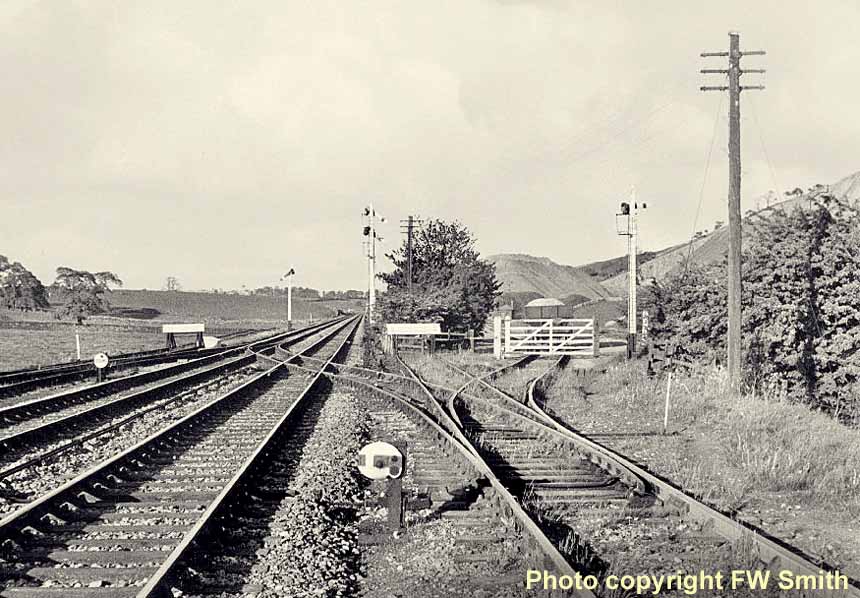
By 1964 there was a great reduction in the number of excursion trains at Embsay, but through freight traffic increased and on 23 January Jubilee 45739 Ulster stormed through with 46 short wheelbase vans from Skipton to Otley for storage. Four days later Class 5 No 45390 took another 51 vans to the same destination. On 6 February a special freight consisting of 61 empty mineral wagons from Teeside to Barrow-in-Furness was hauled by Type 3 diesel D6777. That same day I had opened the signal box for a special ballast train to Burnley. I watched the approaching plume of steam of a light engine and could see it was a BR Standard class loco, probably a 9F I thought, but I was wrong; it was a begrime Britannia No 70003 John Bunyan. The driver was complaining about the coal - a mixture of slack and briquettes, which was made from cement and coal dust. If it did not provide much steam but it certainly produced plenty of smoke!
On 17 February 1964, the damp and misty conditions caused extensive slipping of Ardsley's WD 90644 as it attempted to lift a load of fifty empty 16 ton mineral wagons from Skipton to Otley for storage. On 27 April 1964 Embsay goods depot closed along with those at Bolton Abbey, Burley-in-Wharfedale and Arthington. Quarry traffic at Embsay was not affected.
The August Bank Holiday Monday of 1964 must have been the first time ever that no excursion trains were booked to pass through Embsay, but the 9.50am from Bradford to Skipton due at Embsay at 10.39 steamed in with Ivatt 2-6-2T 41251 hauling 3 non-corridor coaches. It turned out that a derailment had occurred at Bradford, and the station pilot had been substituted. Where they got the three non corridor coaches from I don't know as most had been scrapped by this time. With the imminent closure of Embsay I had applied for a vacancy for a signalman at Burley Junction Box, and on 31 December I was notified that the job was mine. Saturday 9 January 1965 was to be my last day at Embsay, and on the Monday I started training at Burley box. 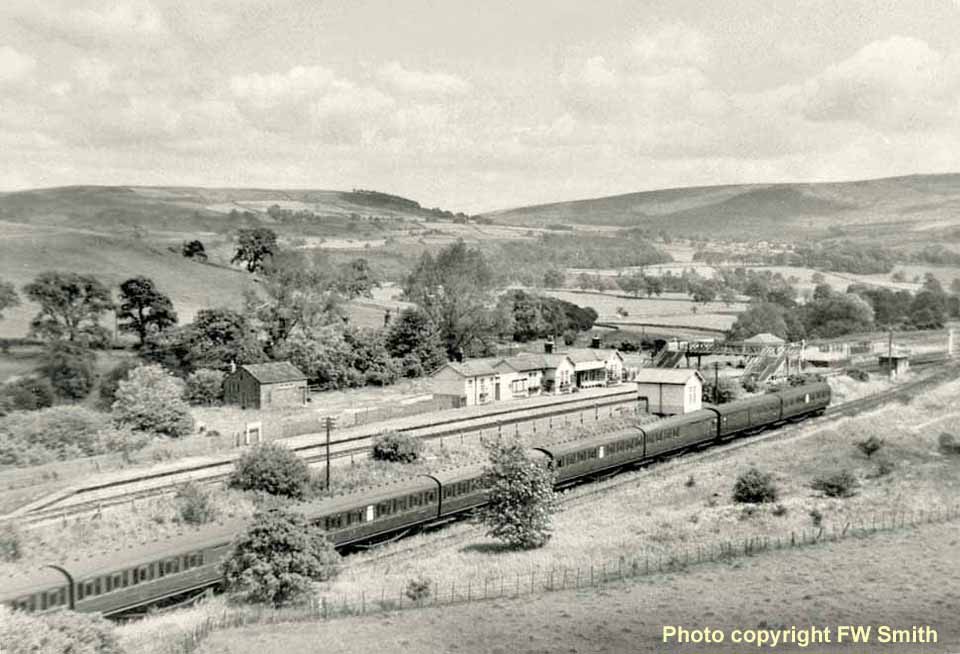
(Above) This view of Bolton Abbey station was taken one Sunday in July 1962 against a backdrop of typically picturesque Yorkshire Dales countryside. The stored coaches in the foreground are Gresley ex-LNER articulated two-coach sets and were used for excursion trains, but by this time their days were 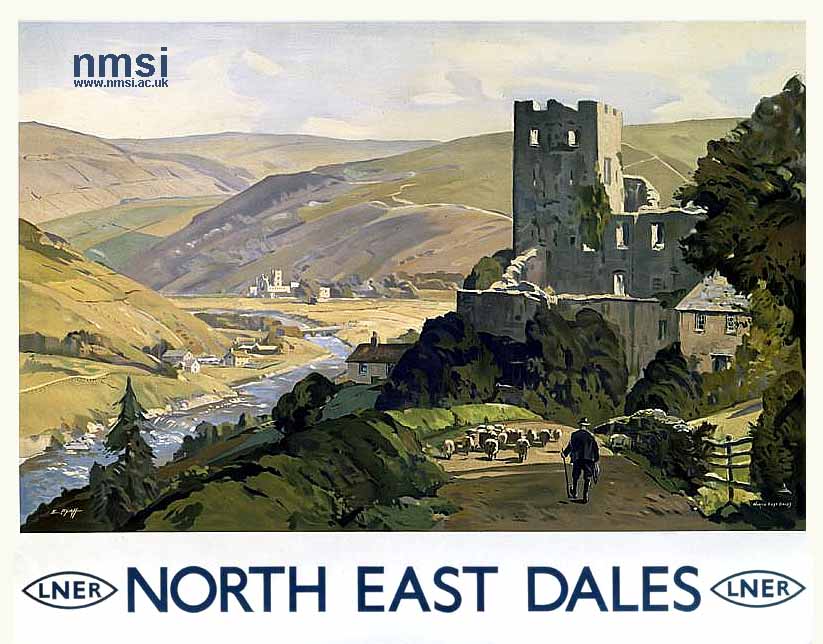 numbered. The brick building on the left behind the station was used by the army as an ablution block during their short occupation in 1940. The sidings on which the coaches are standing originally continued into Hambleton quarry which closed in 1921.
numbered. The brick building on the left behind the station was used by the army as an ablution block during their short occupation in 1940. The sidings on which the coaches are standing originally continued into Hambleton quarry which closed in 1921.
(Left-Right) The stunning images from the NMSI Collection Online show the quality of poster art that adorned station platforms in bygone days. This LNER poster (left) was painted by Edwin Byatt and shows a farmer herding a flock of sheep towards a castle 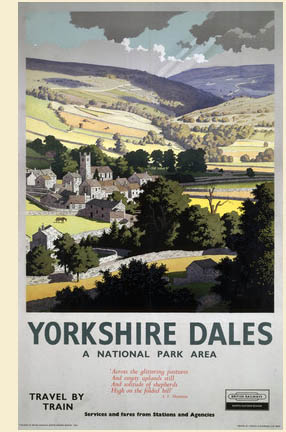 with a river valley and abbey below. This could be Bolton Castle in Wensleydale, but it is more likely to be Barden Towers in Wharfedale with the ruins of Bolton Abbey in the distance, albeit the artist appears to have dallied with the laws of gravity and painted the River Wharfe flowing upstream! Still the painting does convey something of the wonderful character of the Yorkshire Dales, an area of outstanding beauty which is still reachable today by train on the Embsay & Bolton Abbey Steam Railway, an ideal stopping off point for both Heritage Railway enthusiasts and lovers of the countryside. Click HERE for more details.
with a river valley and abbey below. This could be Bolton Castle in Wensleydale, but it is more likely to be Barden Towers in Wharfedale with the ruins of Bolton Abbey in the distance, albeit the artist appears to have dallied with the laws of gravity and painted the River Wharfe flowing upstream! Still the painting does convey something of the wonderful character of the Yorkshire Dales, an area of outstanding beauty which is still reachable today by train on the Embsay & Bolton Abbey Steam Railway, an ideal stopping off point for both Heritage Railway enthusiasts and lovers of the countryside. Click HERE for more details.
(Below) Bolton Abbey station was host to Royal trains on many occasions commencing with King George V both as Prince of Wales and King when visiting the Duke of Devonshire at Bolton Hall. Visits of King George VI during the war caused the building of a special air raid shelter which was sunk into the embankment by the goods yard on the up side. This was provided with telephone communication but was never used. Here Junior Porter Alan Tillotson examines King George VI's air aid shelter in 1960. 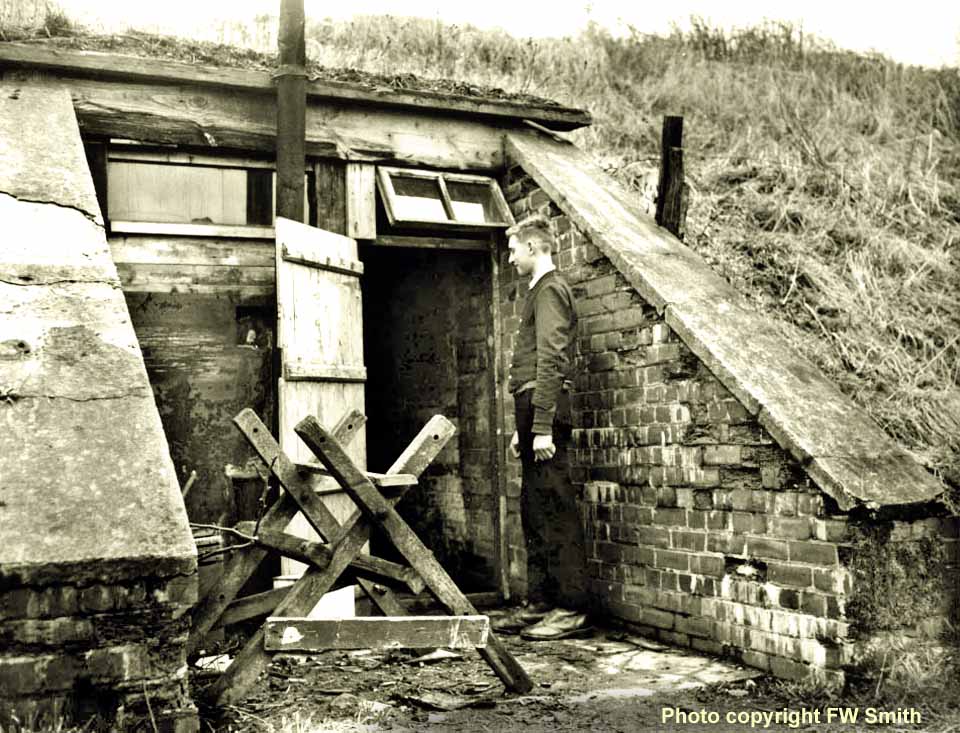
During 1940 and early 1941 changes came to the station when the army moved in, and the whole goods yard and station area was turned into an ammunition dump. A brick ablutions block was built and a cookhouse and Nissen huts erected. The whole station area was surrounded by barbed wire entanglements and guard positions. A guard house and check point was set up half way up the approach drive. The officers were accommodated in a number of camping coaches situated in the old quarry sidings behind the down platform, whilst the soldiers were housed in Nissen huts built on ground to the rear of the up platform. The station was of course closed to ordinary passenger traffic during this period, and coal and other goods were transferred to Addingham. The goods shed was camouflaged and used for storing small arms ammunition. Artillery shells were unloaded from rail wagons in the two back sidings and stored on the ground under tarpaulins. All this activity ceased sometime in 1941 when the army moved out and the station reopened to passenger and goods traffic. Following this the goods shed took on a new use as a biscuit storage and delivery centre with tins of biscuits arriving in rail vans to be unloaded and stored. Delivery was by road vehicles bearing the legend Biscuit Delivery Pool painted in large white letters on their sides. During this period the goods shed door was partly demolished by a railway van being loose shunted with a bit to much vigour by the engine crew. The door was normally left open when shunting was in progress but on this occasion it had been closed by the biscuit workers owing to the windy conditions; this had not been noticed by the guard or the junior porter who was helping with the shunting.
The signalbox at Bolton Abbey was situated at the Ilkley end of the up platform. It had a 20 lever frame of some age having long brass description plates on the sides of the levers. A short stretch of Midland Rotary Block on the down line was between Embsay Junction and Embsay Station and finished at Bolton Abbey, and the down starting signal No 3 at Bolton Abbey was locked with the block instrument. There were no track circuits. Nos 4 and 15 levers were unusual in that they worked points and the ground disc signals as well. Their levers were painted half red top and half black bottom, and the signalman had to be careful not to replace the lever thinking it worked the ground signal only. The two crossovers were provided for running round excursion trains of which there were large numbers on Bank Holidays. There were no disc signals for these crossovers and a duster waved from side to side had to suffice. The up distant signal was motor operated and about a mile from the box having been moved back during the war owing to the drivers of the LNER with coal empties from Lancashire saying that they had insufficient braking distance to stop at the home signal.
When Hambledon Quarry was open a wooden baton inscribed 'Hambledon Quarry - Fire the Shot' was kept in the box on a bracket over the window. When blasting was going to start a quarry employee would be sent to the box to obtain the baton, without which the blasting could not start. If a train had been accepted the baton would not be handed over because once the baton had left the box no train could be accepted in either direction until it was returned. This arrangement ended when the quarry was closed, but the baton remained in the box through to just before closure of the box when it vanished. I know I should have had it, but some one was quicker of the mark!
About 1941 the box was reduced to only opening for the pick up goods to shunt the yard, and to shorten the block section when required. This enabled the two signalman's positions to be abolished and be replaced by one porter signalman. The man occupying this post had to attend all the office work and the accounts with the result that the position was upgraded to Leading Porter Signalman, which meant 1/- or 5p extra each week!
The man who occupied this post was Fred Scott and he remained at Bolton Abbey until closure in 1965. In later BR days although the box was busy during Bank holiday periods, sometimes it would remain closed for weeks at a time in winter as very little goods traffic remained. Summer opening times were for the pick up goods on weekdays and from 10.10am to 7.50 m on Sundays. The Sunday opening times were to cross over the DMUs from Leeds and Bradford via number 14 crossover to await return. The goods yard closed in April 1964, and later that year all points except No 14 crossover were spiked out of use. The rails in the sidings were cut into short lengths and the box was open for the last time on 14 October 1964 to load the scrap rails into rail wagons.
I was on duty on this Sunday from 8.00am to 4.10pm and the train of open goods wagons arrived behind Ivatt 4 2-6-0 43051 of 55FManningham shed. The relief engine men and guard arrived on a light engine 2-6-4 T 42072 also 55F. I put in my diary all sidings now lifted, only the Camping coach remains on a short length of rail. The box was taken out of use on Thursday 12 November 1964 and all signals removed; this caused a block failure and I had to open Embsay Station box at 5.10pm till 8.30pm when all was in order.
(Below) This photo of the box was taken on Sunday 6th September 1964, the last day it was open for passenger trains. The platform once continued in front of the box, hence the rotting boards below platform level. The livery at this time was blue and white of the North Eastern Region. The camping coach can be seen in the background. 
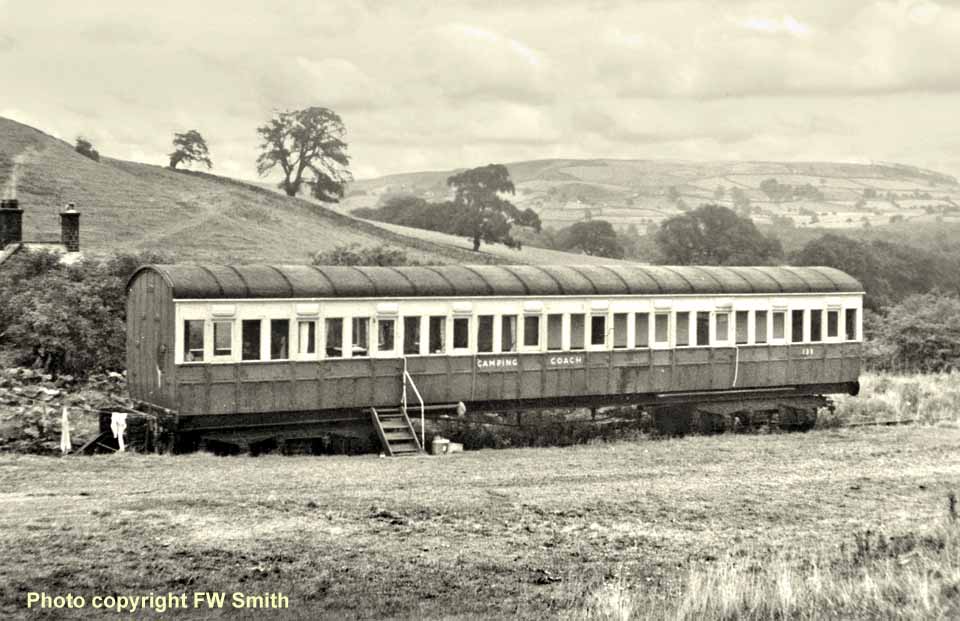
(Above) A camping coach was sited at Bolton Abbey from the mid 1930s until closure. With the exception of the war years until the mid-1950s it was a converted MR converted bogie passenger vehicle. After Bolton Abbey became part of the North Eastern Region an ex-Great Eastern coach was substituted and this lasted until closure in 1965 whereupon the coach body and contents were sold for the princely sum of one pound! It was subsequently set on fire and the bogies cut up for scrap. This photo of the camping coach (No 133) was taken in 1964.
(Below) On Sunday 19 June 1960, a Derby-built Class 108 2-car set departs Bolton Abbey for Leeds. All the DMUs turned back at Bolton Abbey on Summer Sundays. The signalman on duty is yours truly. The rotting boards at the base of the signalbox indicate where the platform had been cut back during the early 1950s. The wooden goods shed was also demolished about the same time. The small signal on the right controlled the exit from the two carriage sidings which ran behind the down platform and formally extended into the now-disused Hambleton quarry. The photo was taken by Peter Sunderland. 
(Inset) Addingham signal box had a 16 lever frame of which three were spare. About 1950 the staff at Addingham was made up of Porter Austin Burdock, Porter Signalman Horace Dingle and Station Master Jack Newman. Eventually the Porter Signalman's position was withdrawn and the box which was only open as required for the pick up goods to shunt the yard, was worked by the Station Master until about 1963 and from then on the box was worked by the Ilkley Porter Signalman who travelled from Ilkley by passenger train when the box was required to be open, but had to travel back on the bus as their was no train available.
After the Station Master had been withdrawn, the station was put in charge of the Embsay Station Master, Harry Turner, who also had Bolton Abbey station under his control, however due to the sparse train service between these stations a Lambretta moter cycle was provided by BR for Mr Turner to make his  journeys to and from Addingham. This did not suit Mr Turner, who spent hours on end practising to ride it in the goods yard at Embsay without stalling the engine!
journeys to and from Addingham. This did not suit Mr Turner, who spent hours on end practising to ride it in the goods yard at Embsay without stalling the engine!
During its final years only one Porter, Austin Burdock, remained at Addingham and after 4.30pm the station was unstaffed. The gas lights were lit by the porter before leaving and they were extinguished by the guard of an empty train which left Skipton at 7.00pm.
After closure the box was sold for a minimal charge and soon demolished. The station buildings remained until January 1970 when demolition began and the whole area is now occupied by new roads and housing. Here Class 3 2-6-2T 40112 arrives from Ilkley with a Skipton train.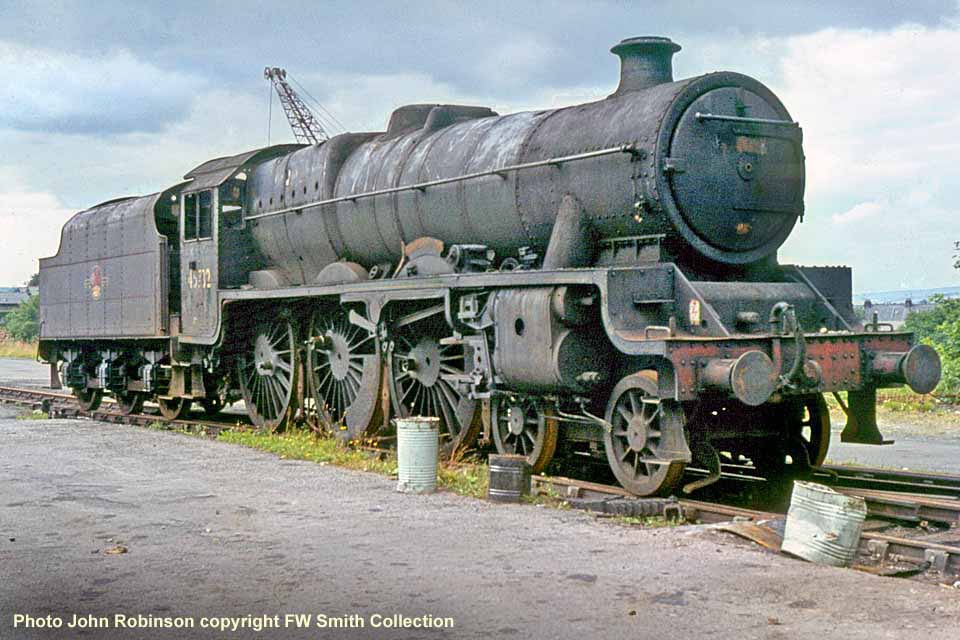
On 25 July 1964 an unusual freight passed Embsay station where I was Porter Signalman. This consisted of Class 8F 2-8-0 No 48509 hauling withdrawn WD 2-8-0 90159 from Skipton to Otley for breaking up in the goods yard by the local scrap firm Butlers Ltd, which purchased three locos for scrapping, the other two being Class B1 4-6-0 61080 and 'Jubilee' 4-6-0 No 45732 Sanspareil…all were cut up within a month of arrival. Note the number plate and shedplate still in place on the B1's smokebox door! The photos were taken by John Robinson.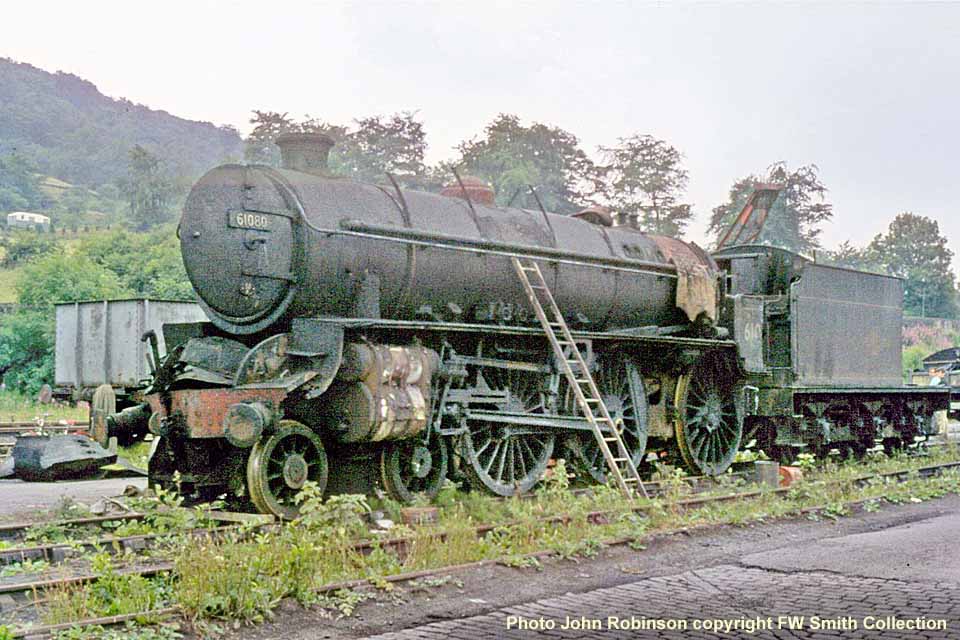
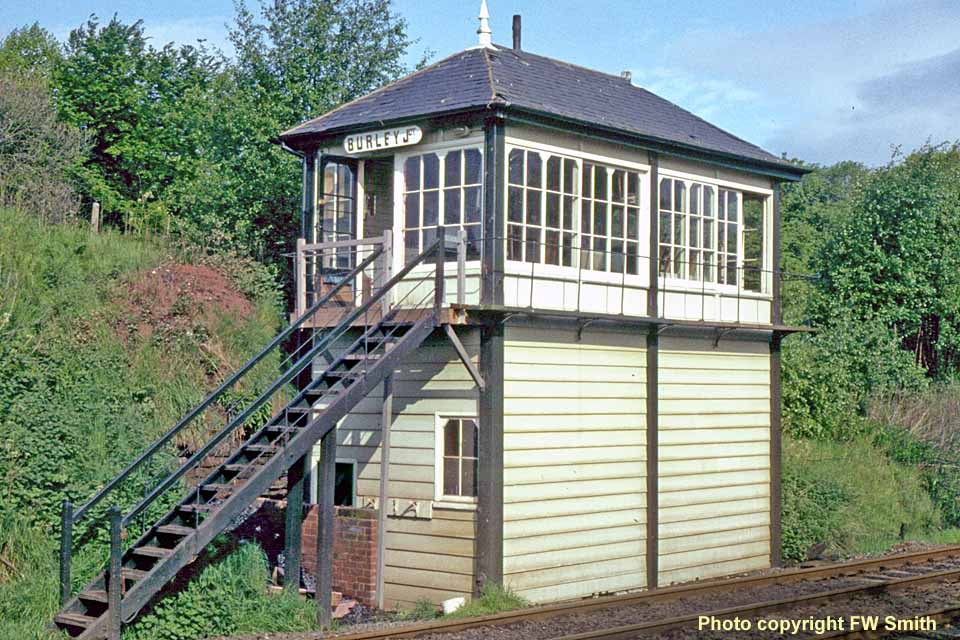
(Above-Below) With the imminent closure of Embsay station to passengers in March 1965, I applied for a vacancy at Burley Junction box and started training there on Monday 11 January 1965, taking over the following Monday 18 January on the late turn. The signalman on Burley's early turn at this time had to close the box at 10.40am by switching out to Guiseley box and then walking the ¾ mile to Milnerwood Junction box and opening it to let the Guiseley-Otley pick up goods pass. After getting the train out of section from Otley, the Milnerwood Jnct box would then be closed again and I would walk back to Burley to get a train home. Burley box was reopened by the late turn man at 12.10pm and the pick up goods was then authorised to propel its train to Burley Junction and then reverse engine-first back to Guiseley. (Below) A view of Burley railway station from the down platform in March 1965.
Monday 17 January 1966, Late Turn. On receiving train entering section from Guiseley for the 3-24 from Leeds to Ilkley I noticed eight sheep walking up the main line from the station towards the box. I rushed out of the box and managed to divert them onto the waste land adjoining the sidings and called out the P Way gang. This reminded me of the time some years before when one Saturday morning I was sat in the booking office at Embsay and heard what sounded like many footsteps approaching on the platform. I thought there'd be many bookings for the 9-10 am to Leeds, but on opening the door I found myself looking at a platform full of sheep!
I was straight onto the phone to Skipton station North Junction box to caution the Leeds train. As the sheep had come up the line from the Skipton end, I managed to get in front of them and turn them back towards Embsay Junction. About half way towards the junction the first of the flock turned down the embankment on the up side and the rest followed it one by one through a gap in the fence back into the field. I patched the gap up as best I could and then got the P Way gang to do a proper job..
My last day at Embsay was Saturday 9 January 1965. The move meant promotion from Porter Signalman to Signalman and a rise in pay from £11-10/6 to £12-10s a week. I started training as Signalman at Burley Junction on Monday 11 January 1965, arriving there on the 6.58 train from Ben Rhydding and returning on the 1.15pm from Burley. My tutor was my pal Farrar Fern who I had worked the same box with as a lad! I also had to train at Milnerwood Junction as it would be part of my job at Burley. On Friday 16 January the district signalmans' inspector, Roland Caws, came to pass me out on both boxes - 'You will take charge on Monday 18 January late turn,' he said.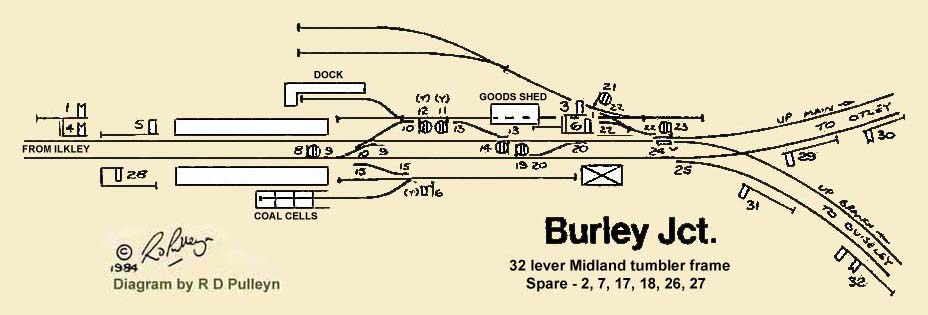
Late turn was 12.30pm to 7.40pm, and as there was no convenient train home, it meant a walk down to the main road to catch a bus. By Saturday 23 I had completed a week of late turns with no untoward happenings, but around about 5.30pm Driver Edgar Fox had brought a two-car diesel from Bradford into Ilkley, and whilst shunting it into the middle road carriage siding he inconveniently demolished the buffer stops! This then required Manningham's Ivatt 2-6-0 43051 to take the diesel back there for repairs.
The following week I was on the early turn which involved a push bike ride of about three miles. Unfortunately it was January and there had been a scattering of snow and a heavy frost. The box was due to open at 5.55am and so I had to leave home at about 5.25am. I made it okay on the first day but a lot of problems awaited; the interior was like an ice box as the Romese stove was cleaned out on Saturday nights and had to be lit on Mondays. However this was not even half of the troubles as the facing points for the Otley line were frozen on the facing point lock. Now Farrar had given me a tip about this; I gathered some cotton waste and a can of paraffin and then spread the same on the point locking mechanism. I lit a match and what a beautiful fire! Returning to the box I gave it a minute and back went the lever. Great! Now I had to get a fire going in the stove which was not easy…lighting coke with the paraffin sometimes caused minor explosions and filled the box with smoke. I usually kept my overcoat on till about 10am...
Those were the the days!  Shortly after taking over at Burley box I got orders that after closing the box at 7.40pm I was to take over at Burley station booking office until the last train at 10.00pm. This was from Monday to Friday as there was a shortage of staff. I did this on regular occasios as it was overtime, and I got on the last train after putting out the last gas lamp leaving any alighting passengers in the dark! I never got any complaints from the management.
Shortly after taking over at Burley box I got orders that after closing the box at 7.40pm I was to take over at Burley station booking office until the last train at 10.00pm. This was from Monday to Friday as there was a shortage of staff. I did this on regular occasios as it was overtime, and I got on the last train after putting out the last gas lamp leaving any alighting passengers in the dark! I never got any complaints from the management.
On 10 March 1965, Class B1 61275 worked an enginers saloon from Skipton to Leeds via Otley, no doubt giving them a last look at the Burley to Arthington line.
On Tuesday and Wednesday the 16th and 17th March 1965 I was at Milnerwood Jct box from 8.30am to 3.50pm then taking over at Burley late turn till 7.40pm. This was for overhauling the interlocking at Milnerwood in spite of the passenger service being withdrawn the following Saturday, and freight the following July.
Needless to say little overhauling took part and the pocket chess set always carried by one of the locking fitters was much in evidence!
(Insert-Below) Burley porter, Jim Emmot, poses for the camera in Burley booking office in 1949; I did my evening overtime there on occasions after closing the box at 7.30pm. (Below) Signalman Maurice Patrickson takes out the signal lamps at Burley Junction while I look after the box in 1950.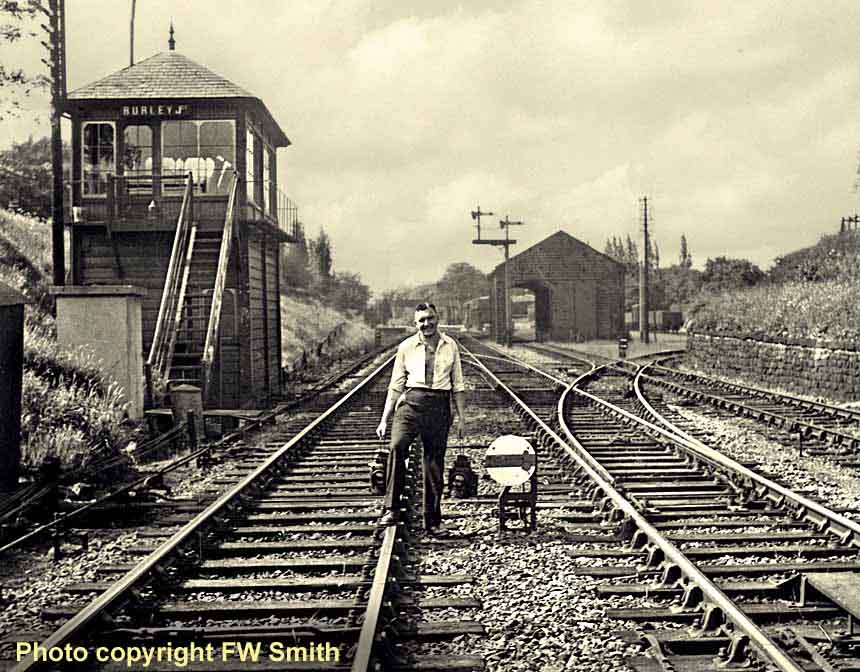
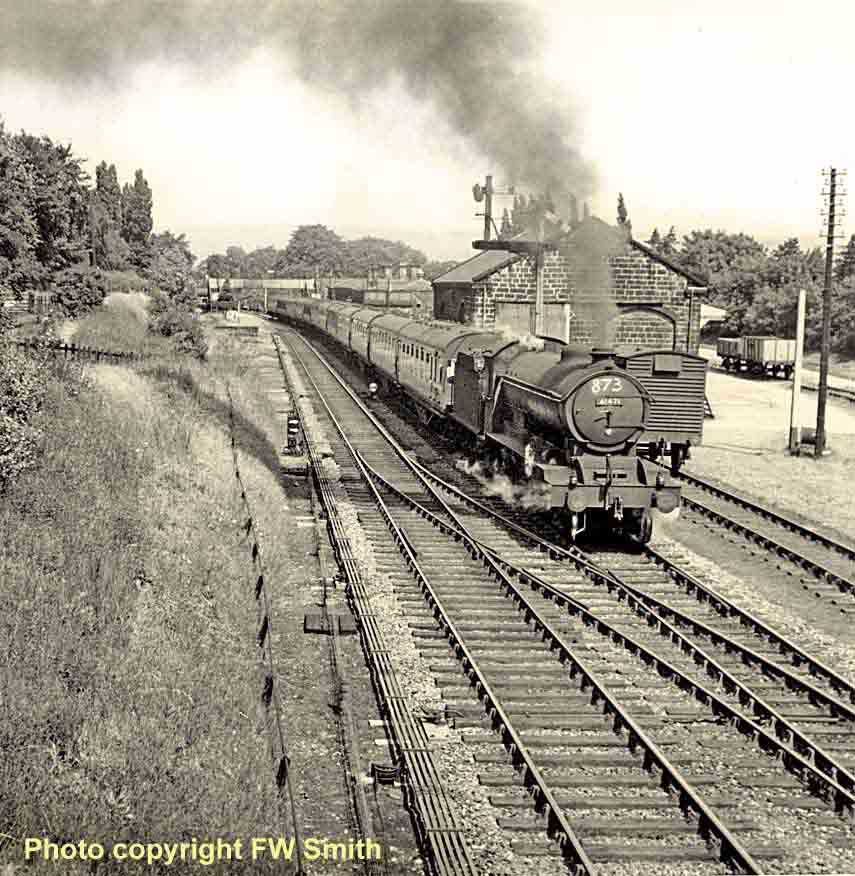
(Above-Below) This shot from Burley Junction box shows Class B16/1 4-6-0 No 61471 departing Burley station with a 12 coach excursion from Ilkley to Redcar on Sunday 6 July 1952. (Below) I recall working Burley box on 27 April 1965 when the 7M26 Tees yard to Heysham Moss tank train passed me and I noticed smoke coming from one of the tanks axle boxes. The circumstances required 7 on the bell to Ilkley which was 'Stop and Examine Train'; this was done and tank wagon detached. The locomotive involved was Type 3 diesel D6774 later class 37. This photo (below) from Burley Junction box and shows the tank train taking the Otley line on 19 March 1965; on this occasion haulage is provided by Type 3 diesel D6762. Note the brake tender next to the locomotive. 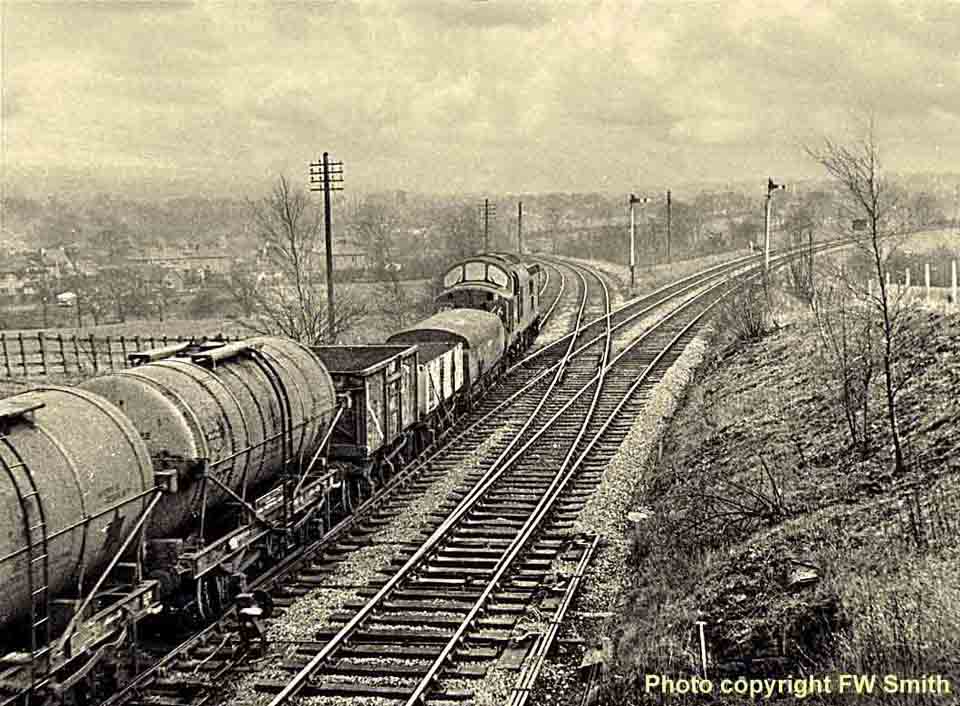
During my time at Burley box, ballast trains were sent out to drop ballast anywhere on the branch and the ganger in charge had to be told how long he could remain working in the section before going forward to Ilkley. Needless to say this did not always work out as promised and many times passenger trains were delayed. On 11 August 1965, one of these trains turned up behind 'Jubilee' loco 45658 Keyes to drop ballast between Burley and Ilkley, however this would have caused delays for the 13.16 from Leeds and the 13.51 from Bradford, and so I decided to shunt the ballast down the Otley branch. The last day of passenger services on the Otley branch was Saturday 20 March 1965 but everything was still in working order; the 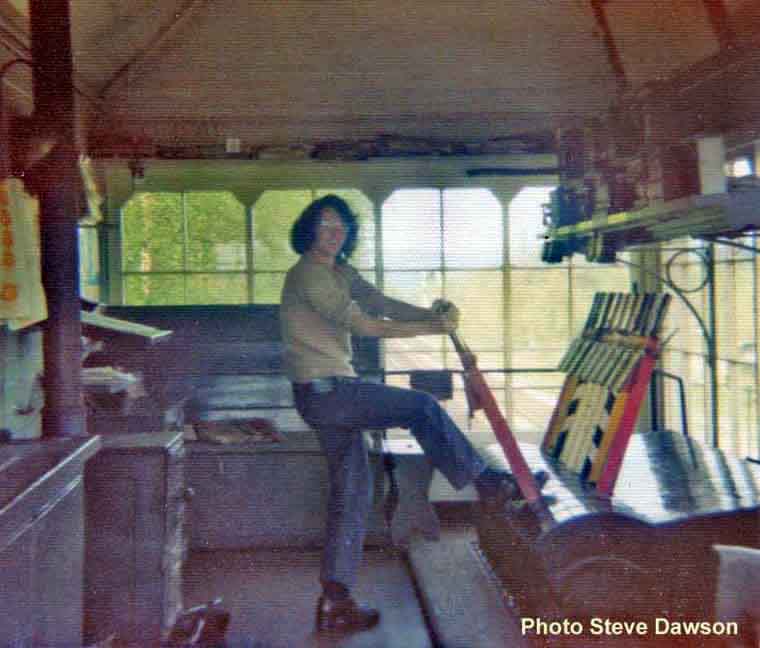 driver of 45658 did not object and so I got him out of the way. This was the last time the branch was occupied by a normal train prior to the demolition trains.
driver of 45658 did not object and so I got him out of the way. This was the last time the branch was occupied by a normal train prior to the demolition trains.
(Inset-Below) I wouldn't muscle in on Bill's page in the normal way, but I've received an interesting email from retired signalman, Steve Dawson, who writes - 'I worked as a signalman at Burley Junction in the mid 1970s. My opposite number was none other than Bill Smith! His 'Railways through Wharfedale' page brings back many happy memories. I have a picture of the interior of the box if you are interested?' Yes we are…Steve's old photo shows him operating the frame at Burley Junction. He's pulling the down Main Home signal. Notice the black and white signalman chevron levers which operated the detonator placers outside the box. They definitely made a 'bang' when a train cracked them whilst operating low visibility double block procedures! Steve only used them once on a very foggy November day. (Below) It's amazing how Mother Nature quickly recovers ground after the wrecking crew have done its worst! Comparisons can be made between Bill's 1950's shot of Burley station and Steve's rural scene in the spring of 1975 or 1976.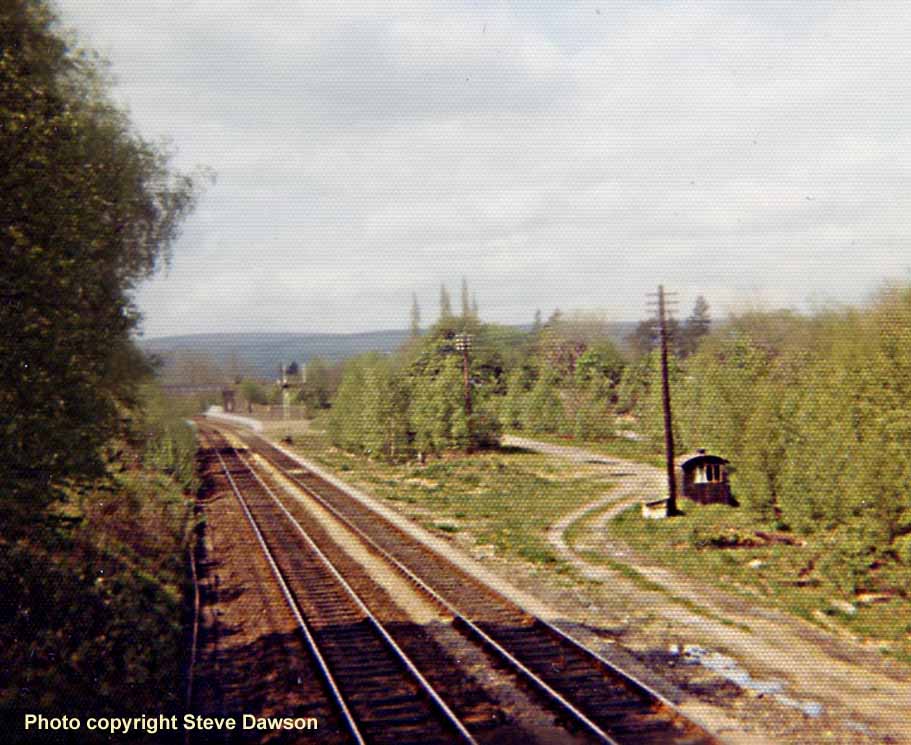
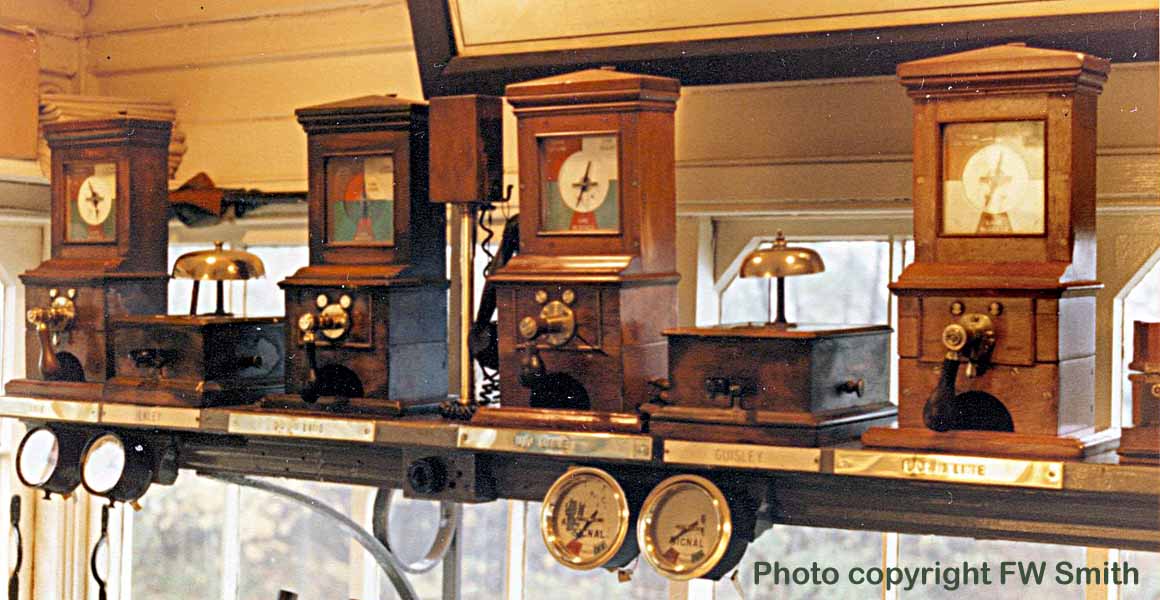
(Above-Below) Interior of Burley box on 24 April 1985. The block instruments and bells are Midland. The levers from the left are: 1 - Up main home; 2 - Up main distant; 3 - Up main detonators; 4, 5 and 6 Spare; 7 - Down main detonators; 8 - Down main distant; 9 - Down main starting; 10 - Down main home.The boxes at either side are Ilkley and Guiseley. The white stripe on Nos levers 1 and 9 denote that they control entry into the forward section; these are locked by the block instruments and require a line clear to be released. Note the LMS ambulance box still in use.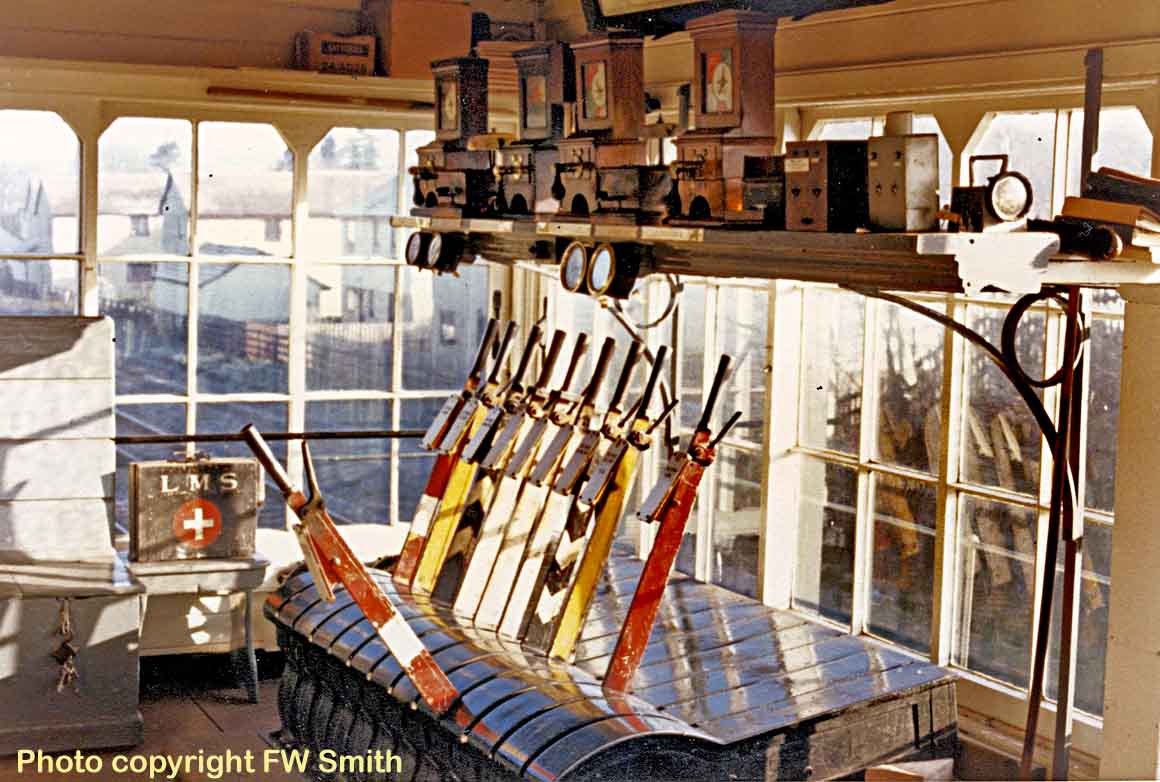
Notes from my diary...
Sunday 2 May 1965 provided a diversion via Ilkley of two trains only owing to trackwork; these comprised a Carlisle to Cricklewood parcels, an Ilkley passenger 6.40am (3 M08) and a Leeds to Morecambe passenger 9.20am (1M43). On Tuesday 11 May a light engine BR Standard Class 2 2-6-0 78022 passed me at Burley box from Leeds to Skipton. This loco was later purchased from Barry scrapyard by the Worth Valley Railway and moved by road to Haworth in June 1975. The loss of freight traffic resulted in lots of redundant wagons and on 5 May, fifty vans on the Tees to Heysham tank train for storage at Ilkley passed me behind EE Type 3 diesel D6777 which only had a couple of tanks included.
Saturday 30 April 1966, Class 8F 48104 arrived at Burley with 40 high goods wagons for removing sleepers and cut rails from the Otley branch, however on setting back with the wagons from the up Otley onto the up main line a faulty wagon door spring demolished No 23 dolly! The wagon spring was eventually knocked off with big hammer by the train crew. On Friday 6 May the box had to be opened early at 6.00am owing to a message to Control by a farmer at Pool that he could not get his sheep across the line at the farm crossing owing to the wagons left on it. This resulted in Ivatt 4MT 2-6-0 43051 being sent from Manningham to move them!
Notes from my diary continued...
Thursday 14th July 1966. Contractors finished lifting Burley to Arthington branch today. Last engine off the branch was class 5 44983 of 55A Holbeck shed. The weed killing train also ran today hauled by diesel D7576.
Friday 15th July 1966. All sidings at Burley disconnected today, last engine out class 5 45219 of Royston shed 55B.
Sunday 24 July 1966. Menston Junction box closed today and all signals removed. The lever frame at Burley box also reduced from 32 to 10 levers.
Sunday 11th December 1966. On duty for taking out crossover and points into dock, steam crane in use hauled by D26 of Holbeck shed.
From 1st December until 24th December a special parcels train from Leeds to Ilkley was run consisting of a oco and one or two bogie parcel vans. The locos on this were as follows: Type 4 diesels D18 ,19, 24, 120, 177, 180. D1528, 1782, 1879, 1899. Type2, D5211, 5254, 7577, 7596, 7610 .Only three steam locos were involved Ivatt 4 2-6-0 43130 and class 4 2-6-4T 42152 & 42622 . Photos Burley box on 24th April 1985.
(Below) View from the Down platform at Burley on 6 March 1965 shows the Up side tank house, water colomn and goods shed.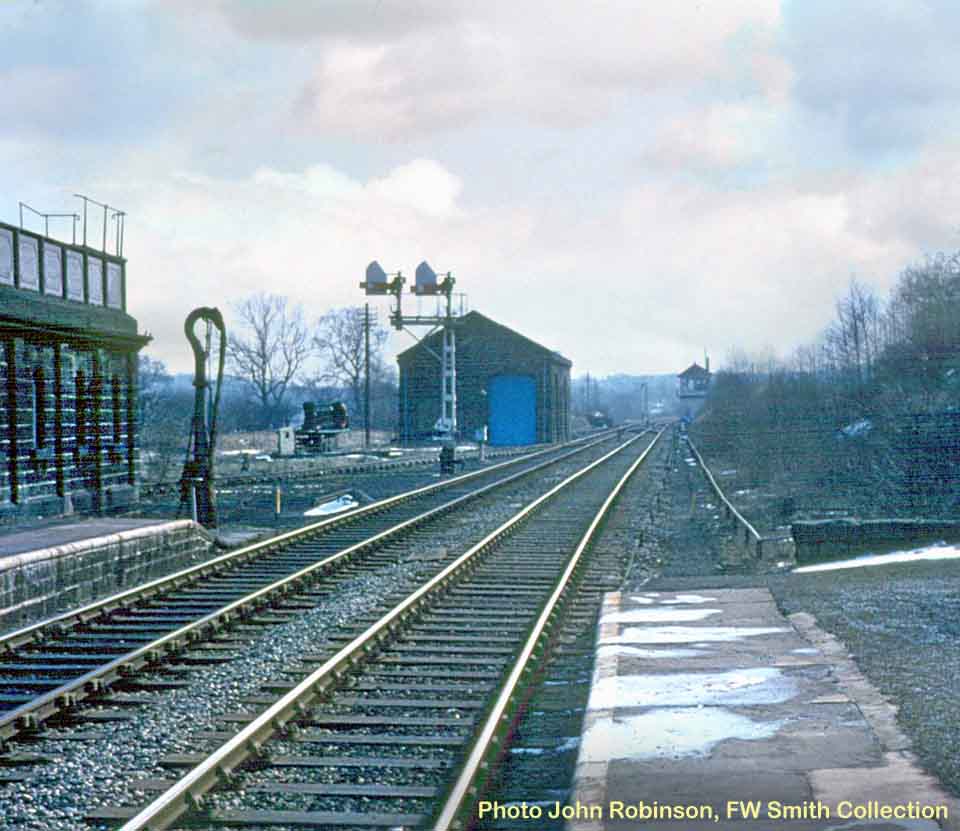
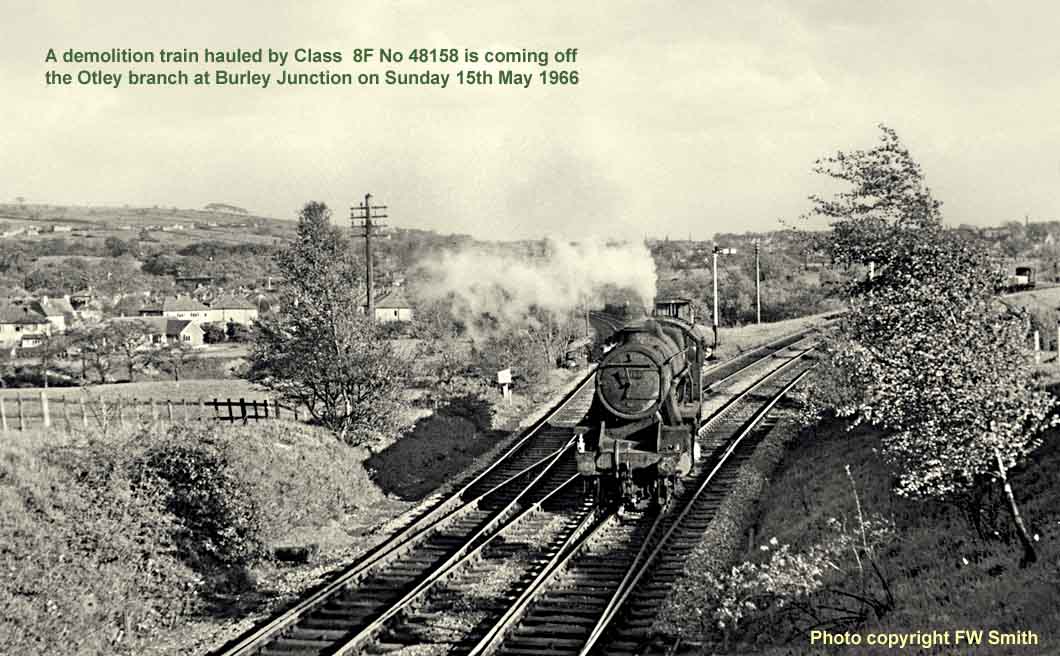
(Above-Below) A demolition train hauled by Class 8F No 48158 is coming off the Otley branch at Burley Junction on Sunday 15th May 1966. (Below) Earlier days...Class 3 2-6-2T 40149 of 20E Manningham shed passes Burley box with the 12-30pm Ilkley to Bradford train on Sunday 6th July 1952. 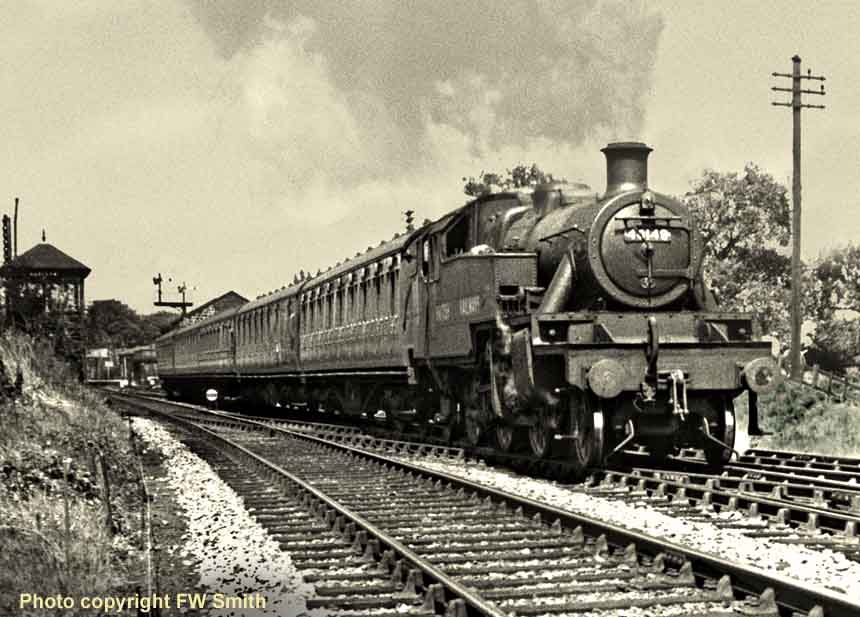
More notes from my diary...Wednesday 2nd February 1966, 2-6-4T 42138 sent to Ilkley to collect failed DMU back to Manningham. Porter Ken Bland off sick and I worked at Burley booking office after switching out the signalbox from 7-30pm to 10-00pm. On 3rd February, Contractors TW Ward Co started work cutting up sidings at Ilkley. Coal traffic still retained at Ilkley and BR Standard 2-6-0 77013 took 7 loaded coal to Ilkley on 86 trip. On Wednesday 16 February, a special of two empty coaches was run from Manningham to Ilkley hauled by 42138 for a TV commercial advert for Black & Greens Tea! On Monday 28 February, a 40 hour week commenced on British Railways. No new rosters had yet been worked out for the box so we were to be given two hours overtime! On Wednesday 30th March, overhauling interlocking at Burley Junction box. Six men and three bosses to perform this task!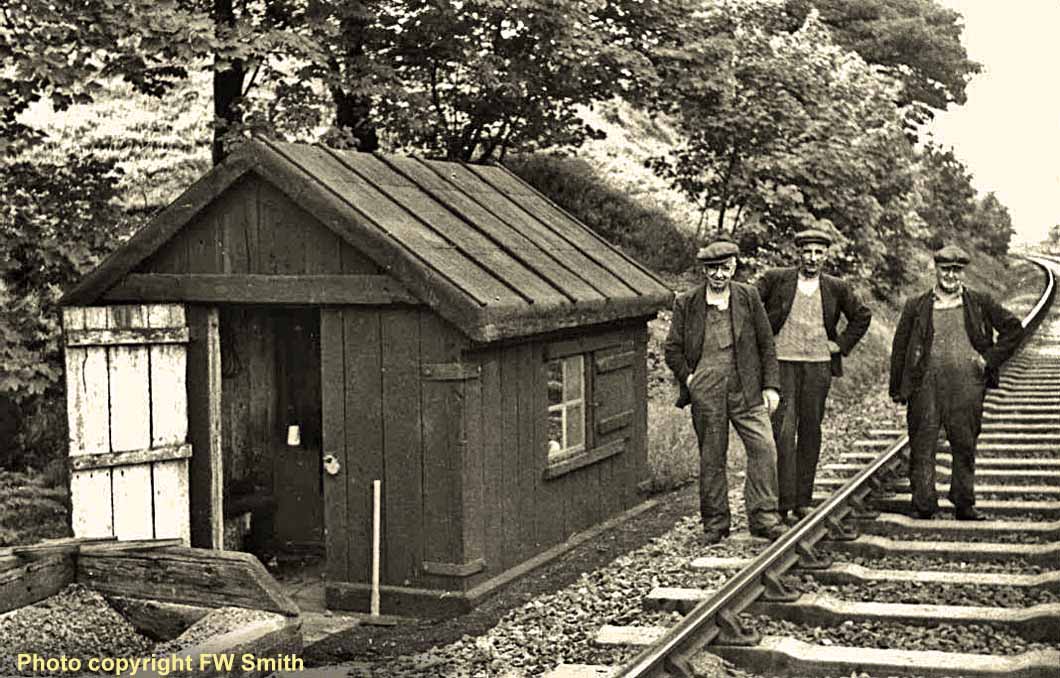
(Above) In the days before high visibility vests, the Burley permanent way gang pose alongside their cabin near Ben Rhydding in the summer of 1954. They are left to right Harold Lewis ,Herbert Whitton and Harry Betts. Note the concrete sleepers which were put down in 1950.
(Above) This is the view of Milnerwood Junction at the foot of climb to Menston Junction on the left with the line to Burley Junction and Ilkley straight ahead; the Midland box had a second hand McKenzie & Holland 16 lever 6 inch pitch frame installed in July 1910. A closing switch enabled the box to be switched out in the Burley direction. The box declined after the withdrawal of the Bradford to Harrogate service in 1957 with only two pick up freights each way using the curve from Menston Junction. A Sunday service from Bradford Forster Square to Harrogate and Knaresborough using DMUs in the Summer of 1960 was a one off and not repeated. This required the box to be open from 10am to 10pm. 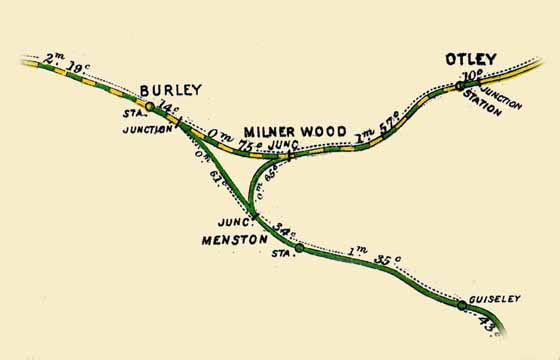 By 1964 there was only one freight daily from Guiseley to Otley and this was authorised to propel its train back to Burley Junction leaving no booked traffic on the up line to Menston Junction, thus saving on overtime for the signalmen at Guiseley and Burley who ended their early turns at Menston Jnct and Milnerwood Jnct respectively.
By 1964 there was only one freight daily from Guiseley to Otley and this was authorised to propel its train back to Burley Junction leaving no booked traffic on the up line to Menston Junction, thus saving on overtime for the signalmen at Guiseley and Burley who ended their early turns at Menston Jnct and Milnerwood Jnct respectively.
Milnerwood box was then only open from 11.20am to 1.20pm. The last trip from Guiseley to Otley ran on 24 June 1965 and the box was officially closed from 5 July 1965 but was used to work the points for the demolition trains early in 1966. 
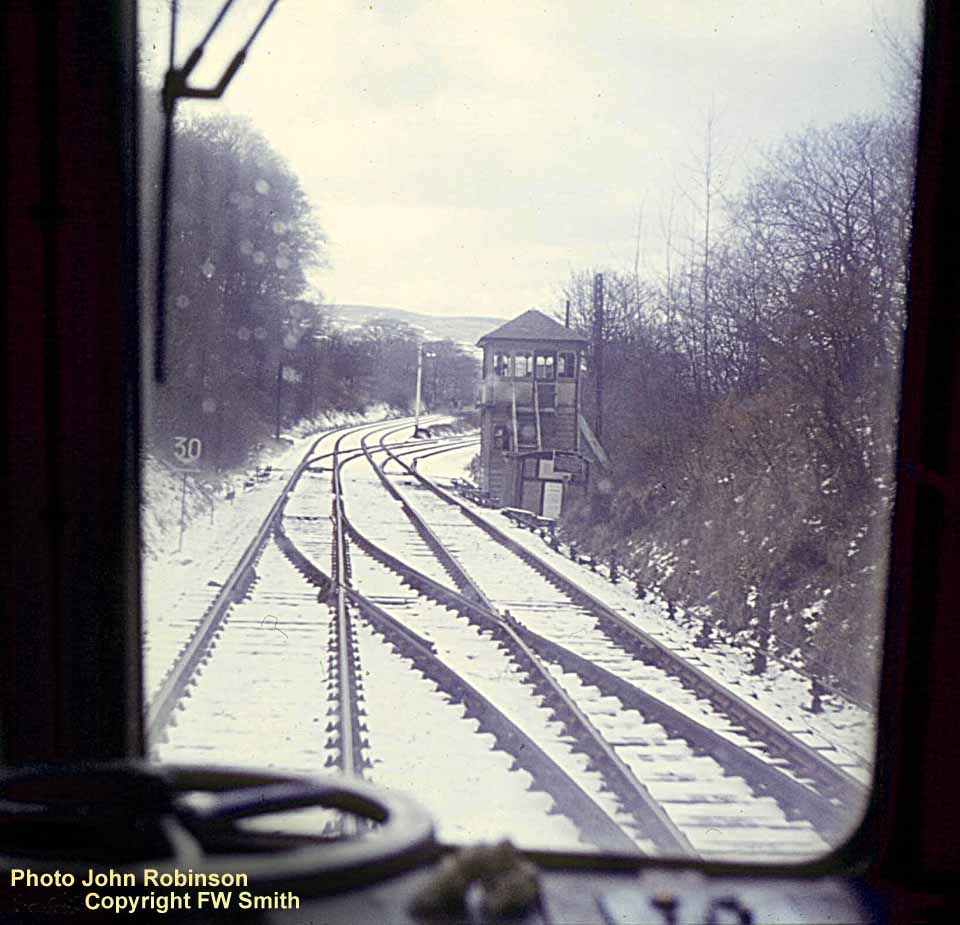
(Above-Inset-Below) Saturday 20 March 1965 was the last day of passenger services on both the Leeds-Ilkley route via Otley and between Ilkley and Skipton. I had a last trip on the 4.00pm Ilkley to Leeds via Otley, returning on the 5.28pm Leeds to Ilkley via Otley then changed on to the 5.50pm Bradford to Skipton via Ilkley (last train) and returned on the 7.05pm from Skipton to Ilkley (last train). These two photos from a Leeds-Ilkley via Otley DMU were taken by John Robinson on the last day; the first one {above} shows the 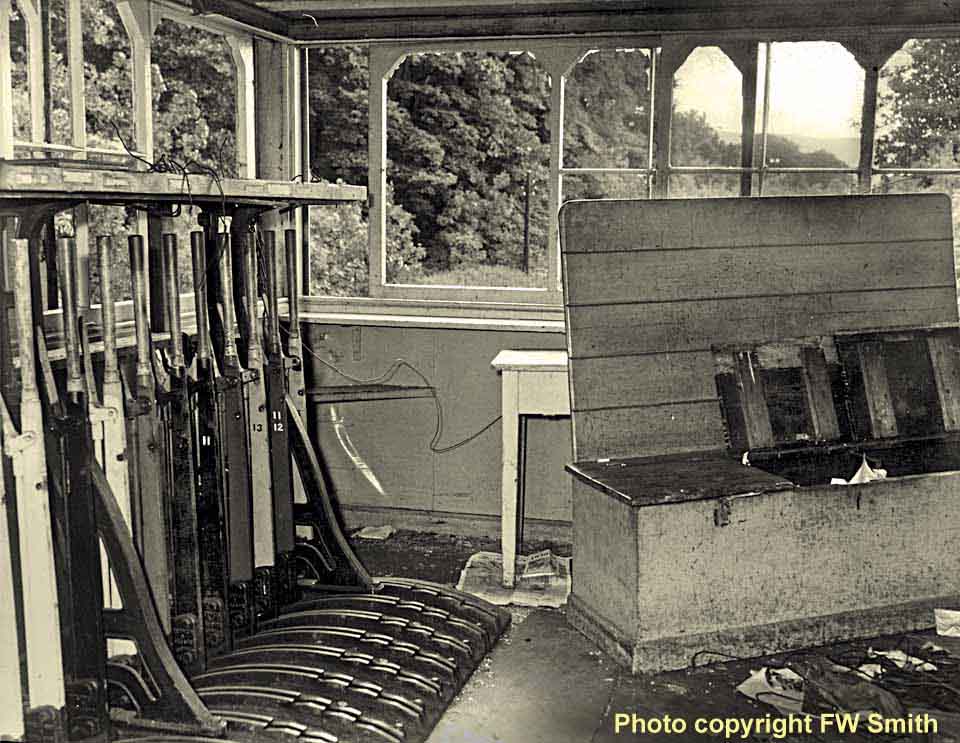 relatively sheltered woodland location of Milnerwood Junction still covered in snow. The DMU is about to take the divergence to the right for the climb to Burley Junction, which, at a higher elevation and surrounded by open fields, enjoys more daylight hours of sunlight and only a stubborn patch remains in the shot (below).
relatively sheltered woodland location of Milnerwood Junction still covered in snow. The DMU is about to take the divergence to the right for the climb to Burley Junction, which, at a higher elevation and surrounded by open fields, enjoys more daylight hours of sunlight and only a stubborn patch remains in the shot (below).
Following withdrawal of local passenger services on 20 March, the Burley Junction box roster was changed on Monday 22nd to 7.30am-2.30pm and 12.30pm-7.30pm. On being relieved at 12.30pm the early turn man walked to Milnerwood Junction and opened up for the 79 trip pick up goods from Guiseley to Otley, and when the 'train out of section' was received from Otley the box was closed, and the pick up goods was authorised to propel back to Burley Junction where it crossed over and ran forward to Guiseley. This was to avoid signalmens' overtime! (Inset right) This is the interior of Milnerwood Junction box following closure and the vandals are doing their worst... 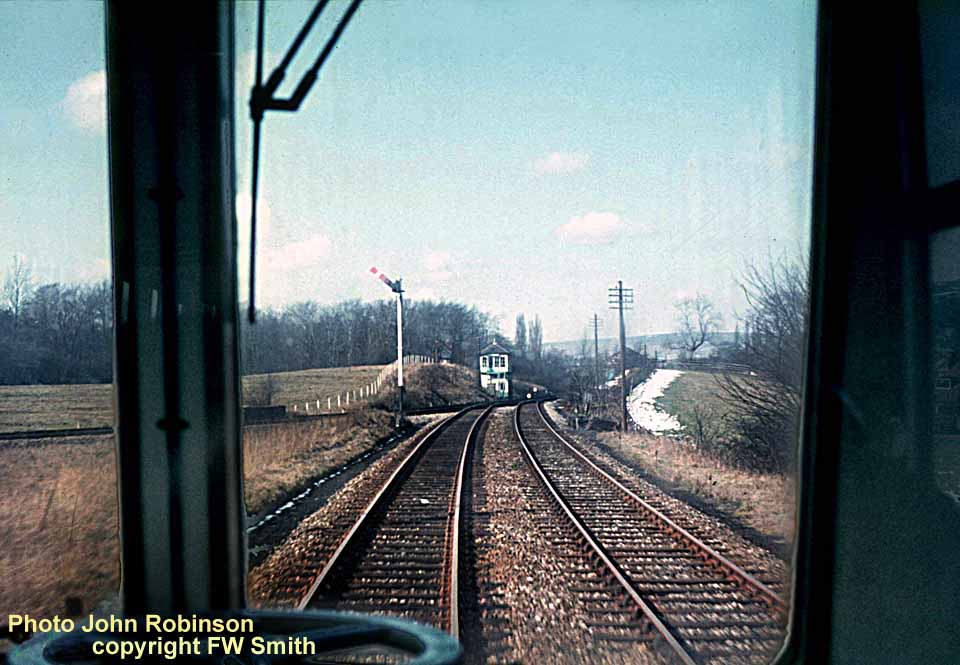
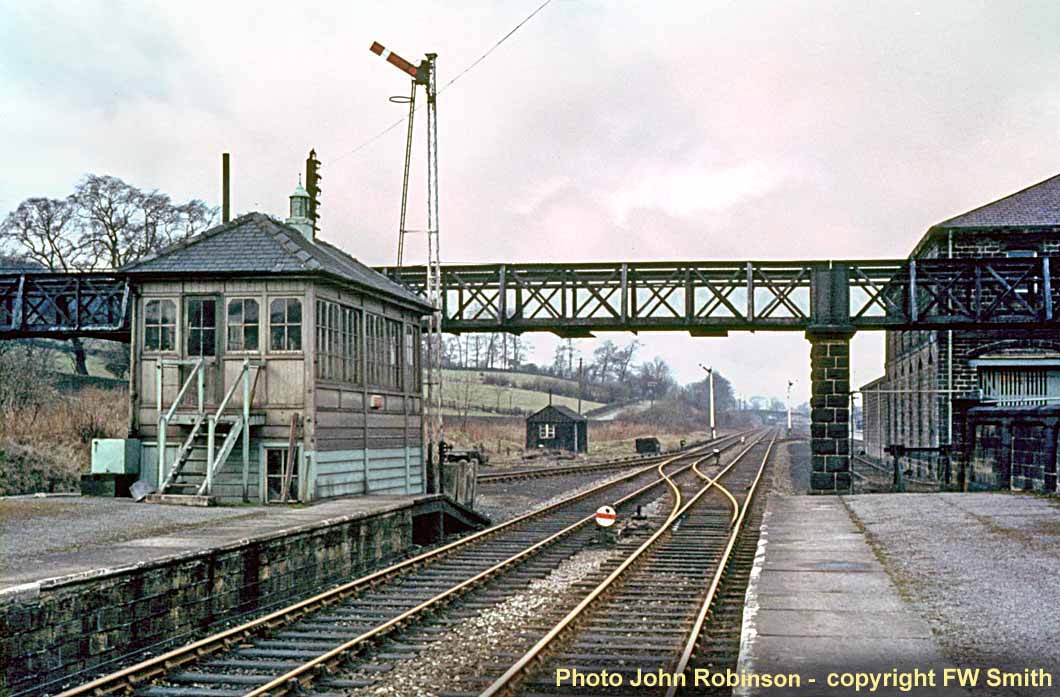
(Above-Below) Three photos of Otley railway station were taken by John Robinson on 1 June 1965 showing the the line heading to Milnerwood Junction (above) and Arthington Junction (below).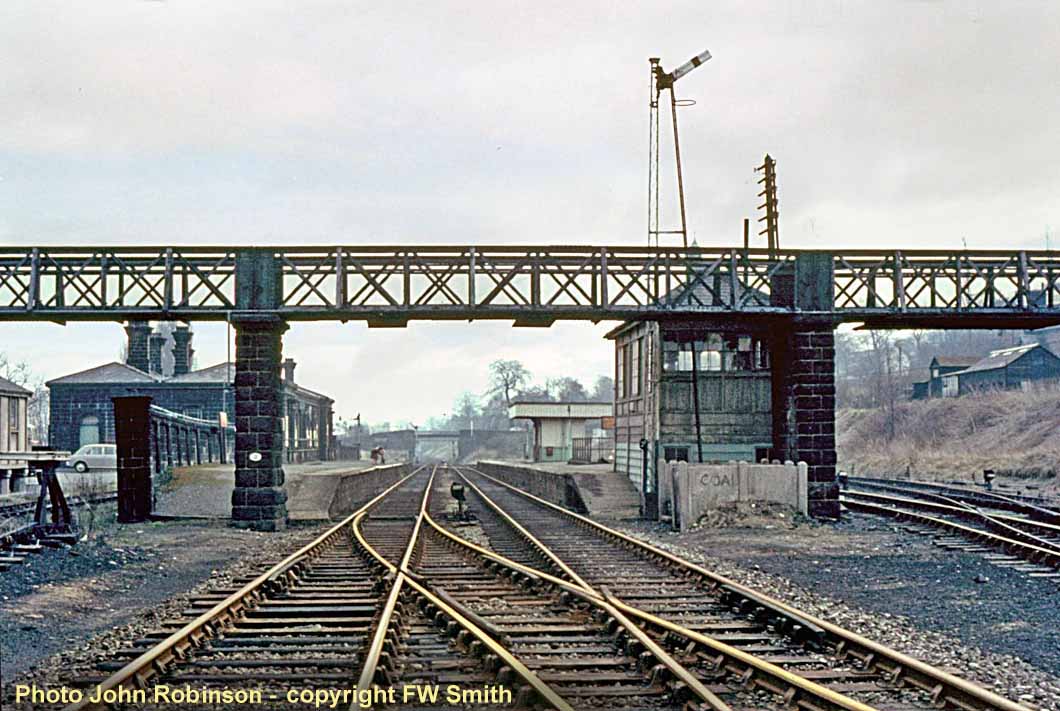
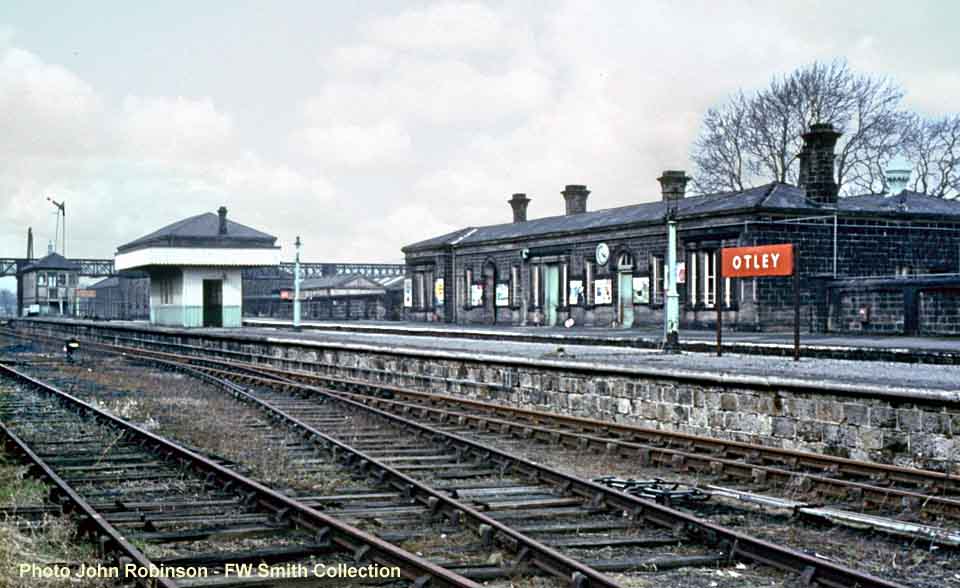
DIARY 1967.
New Year's Day Sunday. First part of trackwork at Menston Junction removed. Sunday 8th January second section of trackwork removed now all plain line. In the early hours of Monday 23rd January Menston Junction signalbox was burnt to the ground by platelayers! On Sunday 19th February Ben Rhydding box followed suite this time being fired by contractors. This left Ilkley, Burley, Guiseley and Esholt Junction boxes on the branch. Two trip workings were running at this time (P11 trip from Stourton and P94 trip from Bradford Valley) albeit only one would run on most days, and on some days neither ran. As an example on Monday 20th February P11 had 'Peak' class D84 Royal Corps of Transport and the following day 'Black 5' 44943 ran, whereas neither ran on the 22nd. On Thursday 23rd D5253; 24th 44949 and P94 had D5255. On 9 March 1967 P11 trip turned up behind 'Jubilee' 45593 Kolhapur of 55A Holbeck shed with one wagon of coal for Ilkley and brought one empty back! On Monday 13th April I noted that I was to received a 9 shilling increase in pay bringing my wage up to £13-8 shillings a week.
1 May 1967 saw the cancellation of the two trip workings - P11 ex-Leeds and P94 ex-Bradford - and a new P80 trip was introduced from Bradford to Guiseley, Menston and Ilklèy, but nothing from Leeds. On 25 May a cat excavator started clearing a path from the Burley goods yard on to the Otley branch for lorries to remove ballast. On 7 August Ilkley goods yard closed to all traffic and on 9 August P80 trip with D5255 was the last goods train to shunt Ilkley yard picking up three empty coal wagons and departing at 2-54 pm for Guiseley. Monday 4 September 1967 saw the last steam locomotive to use the Ilkley branch when Class 8F 2-8-0 48070 came to Ilkley to pick up a disabled DMU and departed with it at 11-10 am for Neville Hill.
(Below) On 25 May 1967 a cat excavator was photographed clearing a path at Burley Junction for lorries to remove ballast from the abandoned Otley branch.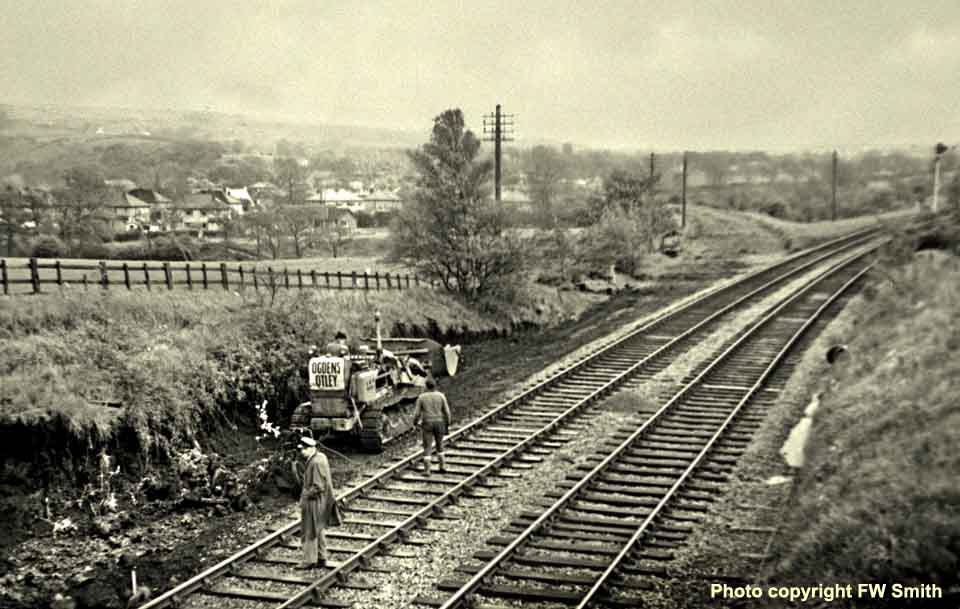
DIARY 1968
The year 1968 saw a further attempt to close the Ilkley branch and the withdrawal of Bradford to Keighley trains on the Aire Valley line. The proposed closure date was to be Monday 5 May 1969 and written objections were invited to be sent to the TUCC at York by 29 November 1968. The objections slowly built up and by the last date at the end of November they totalled 2,541. On Monday 7 October Conducter Guards were introduced on Bradford-Leeds -Ilkley trains and all booking offices closed with staff being retained only at Ilkley and Guiseley. Another change occurred on 24 May 1968 when the last pick up P36 trip (with D5177 in charge) ran from Menston to Ilkley just to run round its empty coal wagons. From Monday 27 May it was athorised to set back from Menston on the down line using the bell code 3-3-2 shunting into forward section. 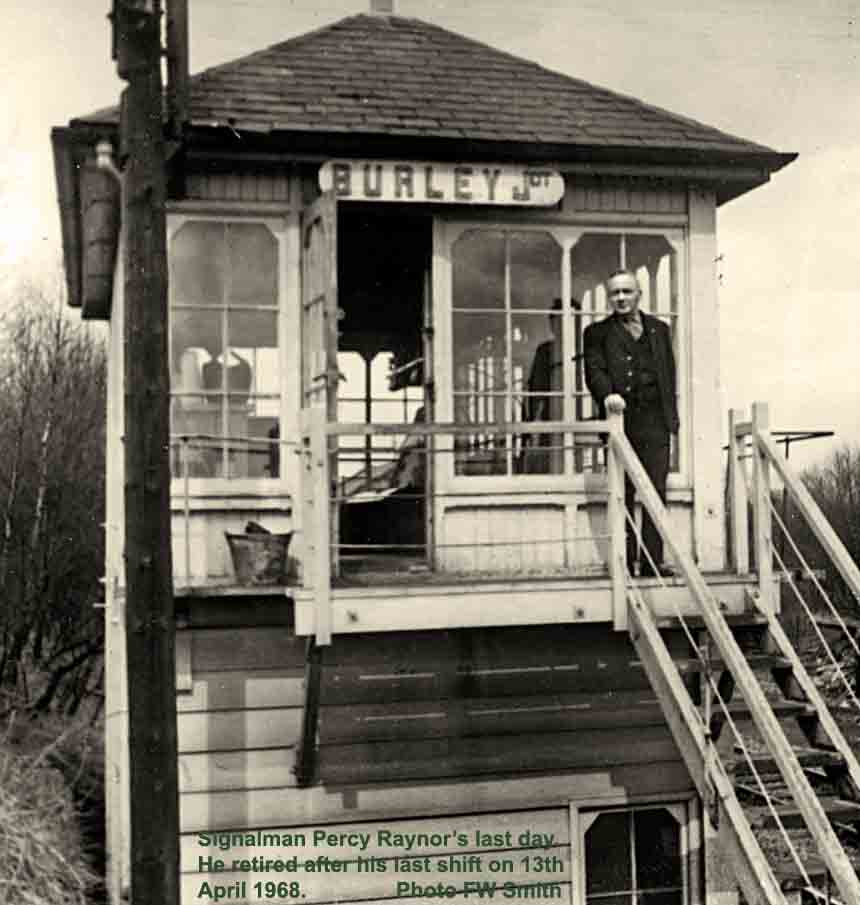
MY LAST BOX - 1985-1994
My last move was to a vacancy at Ilkley Junction box on Monday 30 September 1985. I worked almost ten years at this box until Saturday 11 June 1994 when I was made redundant following electrification of the Ilkley line and signalling was taken over by Leeds Power box. Ilkley Junction box was demolished on Sunday 19 June 1994.
Often people ask me where is the junction at Ilkley? This came about after 1888 with the construction of the line to Skipton, then the junction between the Midland, and the Otley & Ilklèy Joint line - the branch being the ¼ mile to the buffer stops in No 1 platform. The box I worked in from 1985 to 1994 was no less than the fifth at Ilkley having been opened on 20 July 1913. Owing to the restricted site it overhung the up main line. Consequently the 44 lever frame was positioned at the back of the box giving the signalman an uninterrupted view of the track layout in front.
The box worked free block until the early 1970s when the starting signals 17 and 26 became locked with the block instruments and required a line clear release. The facing point locking bars No 2, 8 and 25 were of the Midland economical locking pattern being worked by the same lever as the points. Passenger trains arriving in platform 1 would back out onto the independent siding or the up main line. In the latter case the coaches would be left clear of No 5 points, the engine then returning to platform 1 to reverse via the down main line and No 37 crossover and back onto its coaches. Although this manoeuvre was made many times a day, there was no signal for the reversing movement from platform 1. Instead a waved duster was used during daylight hours and a hand lamp waved from side to side sufficed at night. Engines terminating in platform 3 would back out via No 2 crossover, again leaving the coaches clear of No 5 points, before returning to platform 3 and then running via the down main to No 37 crossover. Once again no signal was provided from No 3 platform for this move, and the duster or hand lamp had to be used. In this case the signalman had to be careful that the junction facing points No 25 were set correctly for the move as a waved duster provided no locking! More than one signalman was caught out by this with No 25 points being run through causing a lot of damage due to them being locked. Goods trains terminating always ran into platform 1 and backed out along the independent siding to run round via No 21 points.
On Bank Holiday Mondays during and after the Second World War, Ilkley box was so busy that a traffic regulator was sent from Leeds to assist the signalman who did not appreciate the intrusion. Opening hours were 4-00am to 11-00pm, the middle 3 hours being covered by the Ilkley porter signalman. During the war the late turn could be extended well into the next morning while waiting for the return workings of the empty coal and coke trains. By August 1961 the opening hours were 5-00am to 11-20pm. The box could not be switched out and had to be manned for all trains.

(Above-Below) On Wednesday 19 May 1965 Brush Type 4 D1766 of 55A Holbeck shed arrived at Ilkley station at 7.25am with six corridor coaches to take part in the making of the film 'Life At The Top' starring Jean  Simmons, Lawrence Harvey, Honor Blackman, Michael Craig, Jean Simmons and Donald Wolfitt. The film was based on John Braine's novel 'Life at the Top', a sequel to his earlier 'Room at the Top' released as a film in 1959 in which Joe Lampton (Lawrence Harvey) escapes his working-class roots by seducing and marrying the beautiful daughter of a wealthy mill owner in the fictitious town of Warnley. In the sequal he has landed himself a plum job with his wealthy father-in-law, enjoying all the trappings of an executive lifestyle, complete with luxurious suburban house and white Jag…in all, a gritty and deeply cynical view of Britain's class system. During filming the train occupied platform 3, departing and reversing into the platform countless times; it didn't depart back to Leeds until 6.45pm, yet the station scene occupied little more than five minutes in the film! Click HERE to visit the Wikipedia's page...
Simmons, Lawrence Harvey, Honor Blackman, Michael Craig, Jean Simmons and Donald Wolfitt. The film was based on John Braine's novel 'Life at the Top', a sequel to his earlier 'Room at the Top' released as a film in 1959 in which Joe Lampton (Lawrence Harvey) escapes his working-class roots by seducing and marrying the beautiful daughter of a wealthy mill owner in the fictitious town of Warnley. In the sequal he has landed himself a plum job with his wealthy father-in-law, enjoying all the trappings of an executive lifestyle, complete with luxurious suburban house and white Jag…in all, a gritty and deeply cynical view of Britain's class system. During filming the train occupied platform 3, departing and reversing into the platform countless times; it didn't depart back to Leeds until 6.45pm, yet the station scene occupied little more than five minutes in the film! Click HERE to visit the Wikipedia's page...
More notes from my diary...
On Tuesday 19 April 1966 Class 8F 48443 arrived at Ilkley at 2-50pm with the first demolition train for the Ilkley - Embsay line. At 3-50 pm No 48443 propelled 43 high goods wagons and 3 brake vans on the up line across Brook Street Bridge; it was the first train to cross the bridge since 15 November when D346 ran from Leeds to Grassington. On this day 19 April the down line at least as far as Addingham had the rails cut into 30 ft lengths for loading. On 20 April No 48443 had to leave the loaded wagons in No 2 platform at Ilkley at 9-30pm owing to shortedge of water and return to Holbeck shed. On Thursday 21 April Class 8F 48276 on P11 trip removed the loaded wagons from No 2 on the return trip and departed Ilkley at 11-15am. In the afternoon Class 8F 48104 worked 40 more empties to the work site and took the loaded out at the Embsay end. Then on Friday 22 April, having taken more empties in the morning to the site, No 48104 returned at 7-05pm with 45 loaded and put them in my sidings at Burley; it then returned light to Ilkley to position empties at site before returning light engine to Holbeck.
On Saturday 18th June Class 8F 48352 was the last engine to cross Brook Street Bridge. Track lifting on the Ilkley to Embsay section was completed the next day.
Following withdrawal of traffic on the Skipton line on 3 January 1966, a buffer stop was placed at the Skipton end of platform 3 and the down starting signal No 26 removed. Once the demolition trains had finished ripping out the up line, the distant and outer home signals Nos 12 and 13 were removed. Platform 4 track remained in place but was rarely used. The down distant signal at Ben Rhydding No 30 became fixed at caution, No 31 had been removed some years previously. From 17 November 1969 following closure of the goods yard all points and relevant signals to the coal drops, independent siding, goods shed and the down sidings were taken out of use pending removal. The next to go was the Carriage siding between platforms 1 and 2, which was disconnected on 11 March 1976.
Other alterations in the 1970s included fitting bolt locks worked by separate blue levers to facing points Nos 8 and 25 in place of the old Midland economy locking bars. The economic facing point lock on No 2 points survived into the 1980s. Sunday 25 September 1983 saw a complete transformation, all semaphore signals were removed along with the lever frame. In its place came a small One Control Switch panel and diagram. This occupied a small area at the Ben Rhydding end of the box and controlled two electric Clamp locked crossovers and colour light signals. Only platforms 1 and 2 were retained but for the first time it became possible to run direct into platform 2 via a new facing crossover. The fixed distant at Ben Rhydding was replaced by a colour light capable of showing green when the home signal shows yellow.
Opening hours in 1991 until closure were 6-00am until 11-50pm on weekdays and 8-20am until 10-20pm on Sundays. In 1975 a public address system was installed to announce train delays etc to Ilkley and Ben Rhydding stations.
The end came in the early hours of Sunday 12 June 1994. I worked my last shift on Saturday 11 June being relieved by my partner at Ilkley, Les Jones, who was also redundant that day. The last act was performed by my namesake relief signalman Jeff Smith! The end for the box came on Sunday 19 June at 9-25am when it was demolished by a JCB.
(Below) On 4 October 1965 a DMU derailment occurred at Ilkley owing to the signalman trying to speed things up. A DMU was being brought out of the middle siding between No 1 and 2 platforms to be shunted back into No 2 platform for a departure for Bradford. Another DMU was waiting to depart from platform 1, and in an effort not to delay this some nifty lever work was performed. As the first DMU was rolling back over No 6 points into platform 2 the signalman was heaving No 8 points up for the train in platform 1, followed as usual by No 6 points. Unfortunately the rear bogie of the DMU had not yet passed over them and was diverted into the middle siding, subsequently derailing and damaging the track. Alas the signalman's slick move to save a small amount of time resulted in rather a lot of extra time The Holbeck steam crane had to be sent for and the local heavy gang earned their keep for once! Photo shows crane with Ilkley Station Master Jim Spooner, Signal Inspector Jack Newman in trilby, and Ilkley porter signalman George Thirkell inspecting the damage.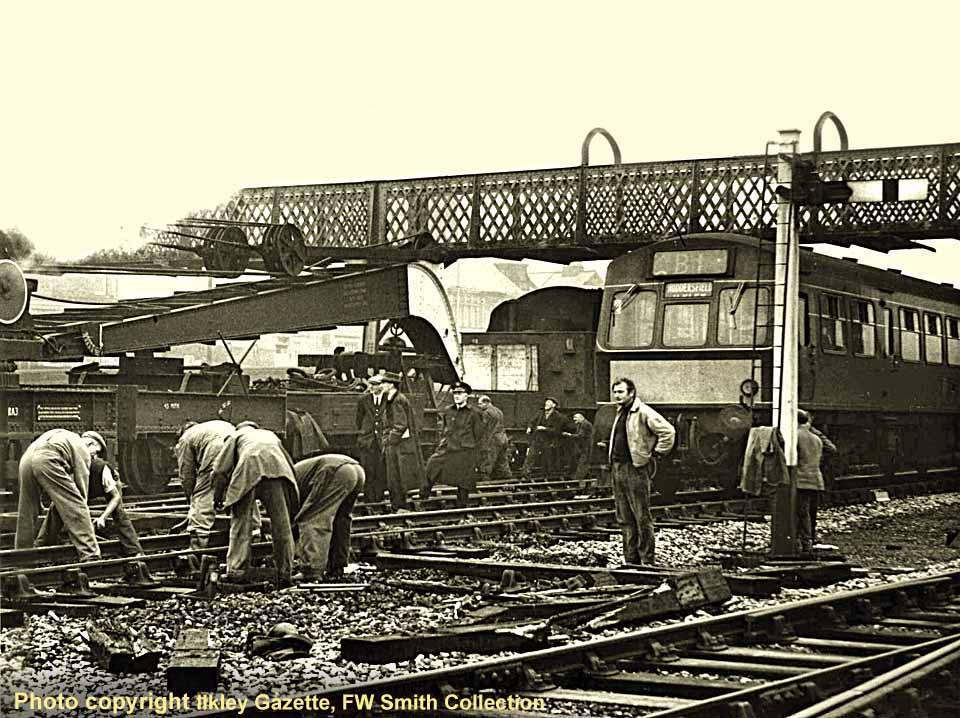
Regarding the derailment at Ilkley (above) I have since looked in my diary for Monday 4 October 1965 and found the train being shunted into No 2 platform was to be the 8-20am to Bradford, and the train waiting to leave platform 1 was the 8-10am to Leeds. The steam crane was hauled by Class 8F 48376 and platforms 3 and 4 were used until repairs were completed. I was on late turn at Burley Junction that day, and incredibly 86 trip pick up goods brake van was derailed at Ilkley trapping the engine Class 4MT 2-6-0 43135 in the goods yard. Tool vans from Manningham passed me at 6-45pm hauled by another Class 4MT 2-6-0 43016, a Manningham engine 55. The movement of No 6 points under the train that morning could not have happened if they had been track circuted, but the only track circuited section at Ilkley in those days was the one between the approaches to the outer home signal No 13 and up to the inner home signal No 14.
What I would call an oddity occured in the early 1950s when signalman Chatterton (Chat) was on duty at Ilkley box and the Geordie Class G5 0-4-4Twas running round its train on the independent siding via No 21 points and waiting to come back past No 20 ground signal which had a yellow arm. The driver whistled for Chat to wave him past, but he should have known that a yellow arm meant he could pass it in the direction that it did not apply, which was the direction he wanted. Chat could be awkward when he wanted…and this was one such time! Whistling went on for over half an hour whilst Chat sat reading a paper! The noise eventually roused the station foreman who was wondering where the 4-00pm train to Leeds via Otley was. He walked down to the G5 and told the driver off and he finished up leaving 15 minutes late. Two awkward buggers, but Chat was right!
Push-Pull working began at Ilkley on 23 February 1942 when G5 0-4-4T 1695 replaced G50-4-4T 1884 as the resident Ilkley engine. Most Ilkley to Arthington trains were then push-pull worked except when 1695 was unavailable. On 9 December 1942 an accident occurred at Ilkley resulting in the death of Tom Thornton, a passenger shunter who had worked at Ilkley station since 1910. On occasions Tom would take one or two of us 'rail crazy' boys on the footplate of the engine as it backed out and ran round its coaches. We were saddened by his death and I remember knocking on the office door of Mr Rae the Station Master to give him some money which the lads had collected for some flowers. The accident happened during the black out when Mr Thornton was shunting empty coaches into the middle siding between platforms 1 and 2 at about 8-50 pm. He appears to have stepped off the footplate of the engine straight into the path of the 8-44pm push-pull arrival from Arthington, which was a few minutes late and being propelled by G5 1695. Neither the driver Oddy Walker, nor the guard John Fox who was with him in the driving compartment, saw anything but both heard a noise for which they could not account...
(Above) A view of Ilkley signalbox during track layout alterations on 25 September 1983. Platforms 3 and 4 were dispensed with along with the lever frame. The work also included new colour light signals, motor operated points and an OCS switch panel was installed..
(Below) Class 47 47455 in platform 1 at Ilkley with the Royal train on the occasion of the visit of Prince Charles on 19 November 1986. No 47455 (previously D1575) was withdrawn in March 1990.
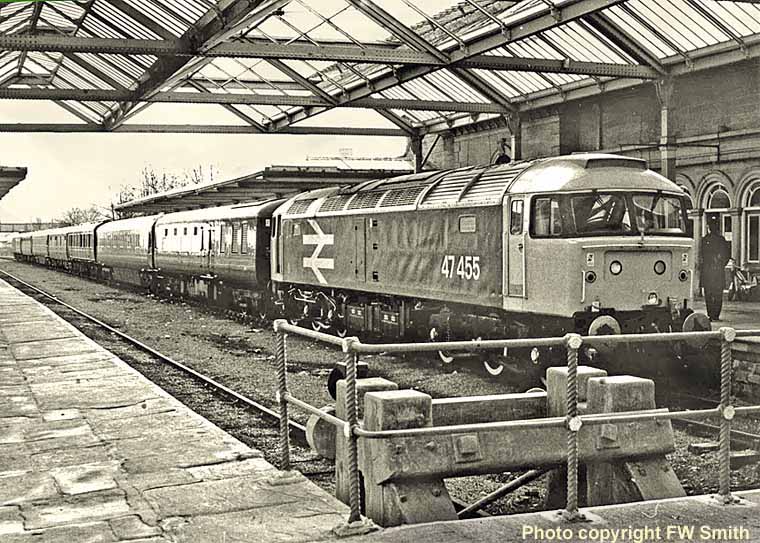
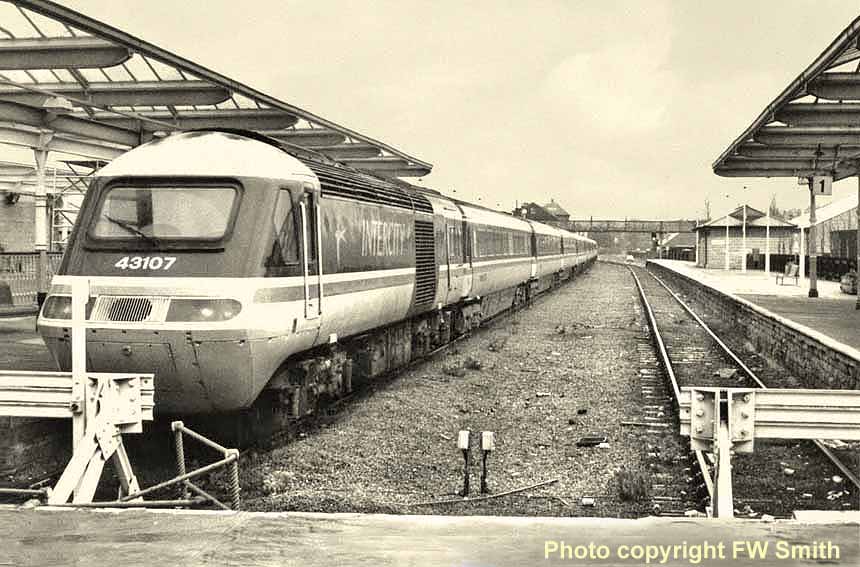
(Above) HST 43107 and 43042 at Ilkley on 21 January 1989. It had worked a special from London St Pancras and, as yet, is the only visit of an HST to Ilkley.
(Below) Fittingly we end the page where we started with Bill's final photograph taken at Skipton showing Class 4F 0-6-0 No 3999, Class 1F 0-6-0T No 1751 and Class 2P 4-4-0 No 359 stored temporarily out of use in a siding near Skipton station in 1946; No 1751 probably never worked again as it was withdrawn in July that same year...
Polite notice: All text and photographs are protected by copyright and reproduction is prohibited without the prior consent of the © owners. If you wish to discuss using the contents of this page the email address is below. Please note - this is not a 'clickable' mail-to link via Outlook Express. You will have to email manually.
dheycollection@ntlworld.com
Featuring
FAMAGUSTA and KALAVASOS
The city of Famagusta has some of the finest examples of mediaeval architecture in the eastern Mediterranean, considered equal to that of the old cities of Carcassone and Ragusa (Dubrovnik). During
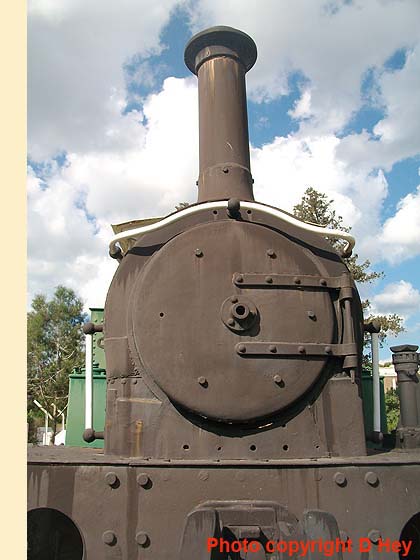 the 1960s and 1970s Famagusta became one of the most desirable destinations in Cyprus, but the conflict in 1974 completely destroyed the town's booming tourist industry. Thankfully visitors are again making their way back to see the historical buildings, Venetian city walls, Othello's Tower, ruined buildings, mosques and museums. Cyprus is a veritable outdoor museum, and in Famagusta you'll find plenty of historical interest, including some obscure artefacts for rail enthusiasts. Click here for a link to Hugh Ballantyne's excellent page on the Cyprus Government Railway.
the 1960s and 1970s Famagusta became one of the most desirable destinations in Cyprus, but the conflict in 1974 completely destroyed the town's booming tourist industry. Thankfully visitors are again making their way back to see the historical buildings, Venetian city walls, Othello's Tower, ruined buildings, mosques and museums. Cyprus is a veritable outdoor museum, and in Famagusta you'll find plenty of historical interest, including some obscure artefacts for rail enthusiasts. Click here for a link to Hugh Ballantyne's excellent page on the Cyprus Government Railway.(Above insets-Below) The Cyprus Government Railway (CGR) 2' 6" gauge railway line ran from Famagusta to Nicosia and beyond to Morphou, but due to fierce competition from road haulage the route closed to all traffic in 1951. The last loco to haul a train from Nicosia on 31st December 1951 is now mounted on a plinth outside the former Famagusta station on
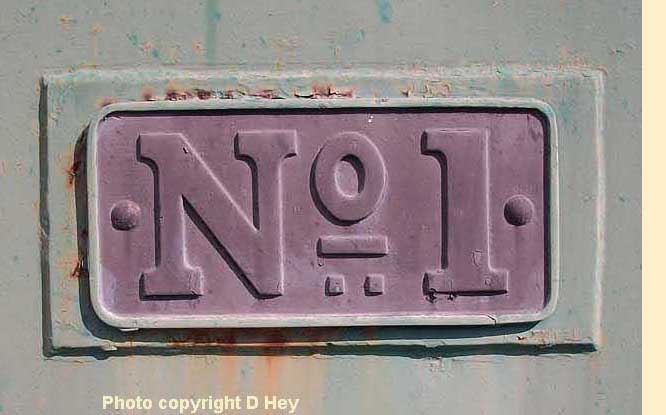 Polat Pasha Boulevard. The Hunslet 0-6-0T No 1 (built 1904) received a comprehensive cosmetic overhaul under the direction of Colonel Barry Turner of 48 Command Workshops REME in 1972. In these photos taken January 2010 the loco looks in remarkable condition for its age - 106 years-old! Alas, the same can't be said for the geezer in the silly hat, body warmer, scarfe and gloves who took the photos....the sun may have beeen shining but it was a cold day for all that...although nothing like as cold as the sub-zero temperatures left behind in England!
Polat Pasha Boulevard. The Hunslet 0-6-0T No 1 (built 1904) received a comprehensive cosmetic overhaul under the direction of Colonel Barry Turner of 48 Command Workshops REME in 1972. In these photos taken January 2010 the loco looks in remarkable condition for its age - 106 years-old! Alas, the same can't be said for the geezer in the silly hat, body warmer, scarfe and gloves who took the photos....the sun may have beeen shining but it was a cold day for all that...although nothing like as cold as the sub-zero temperatures left behind in England!
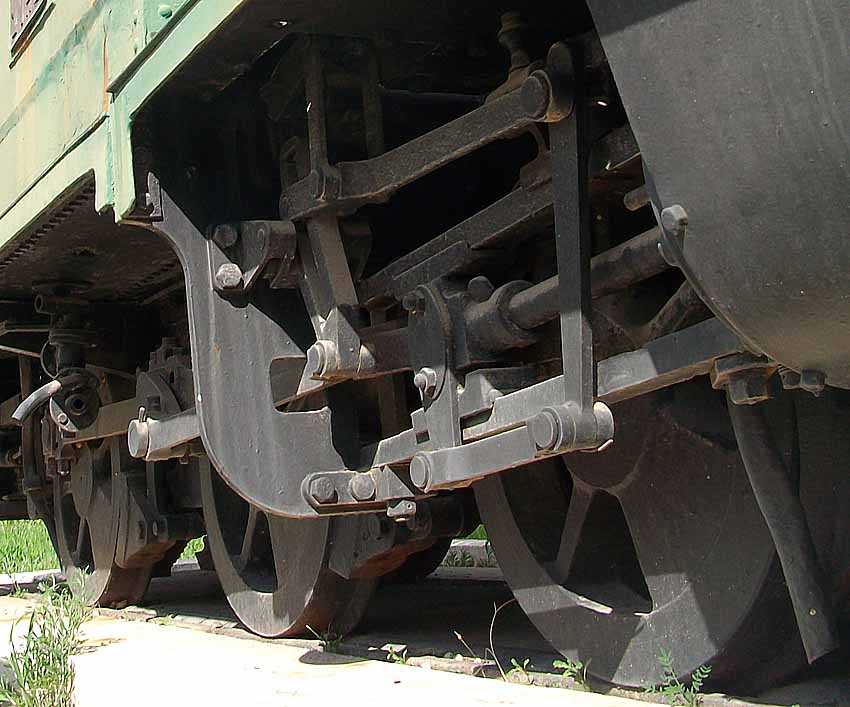

(Above-Below) The Famagusta station building remains intact, and is now used as a Land Registry Office. My thanks to Roger Griffiths for a correction on this page; I had wrongly described the building featured
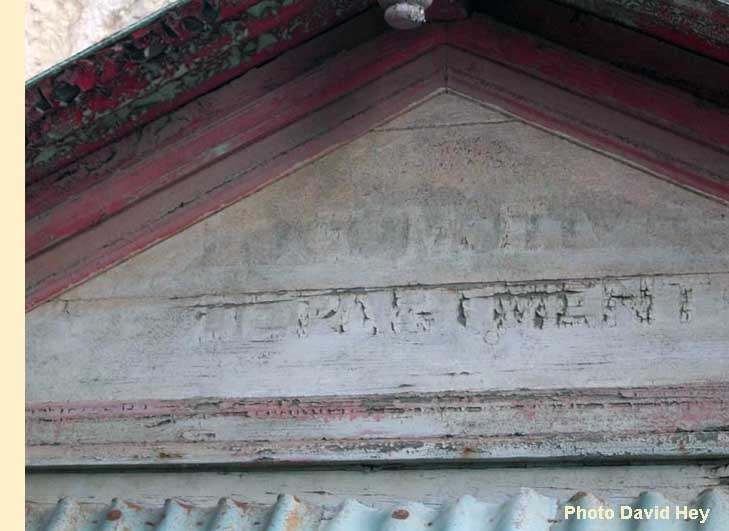 below as the former 3 road engine shed; it is in fact the former locomotive workshops - the engine shed was further down the yard and does not exist today. Roger recommends an excellent book by Hugh Ballantyne - Cyprus Narrow Gauge (Middleton Press), which contains 1951 pictures of the CGR at Famagusta. The railway workshop and yard can be found behind the station building, albeit empty and disused - yet the general layout clearly reveals its railway origins and British colonial influence, as does the flaking paintwork of the sign above the door - 'Locomotive Department' - photo taken January 2010 - more than sixty years since the shed closed! Click here to visit Cypnet page on the CGR.
below as the former 3 road engine shed; it is in fact the former locomotive workshops - the engine shed was further down the yard and does not exist today. Roger recommends an excellent book by Hugh Ballantyne - Cyprus Narrow Gauge (Middleton Press), which contains 1951 pictures of the CGR at Famagusta. The railway workshop and yard can be found behind the station building, albeit empty and disused - yet the general layout clearly reveals its railway origins and British colonial influence, as does the flaking paintwork of the sign above the door - 'Locomotive Department' - photo taken January 2010 - more than sixty years since the shed closed! Click here to visit Cypnet page on the CGR.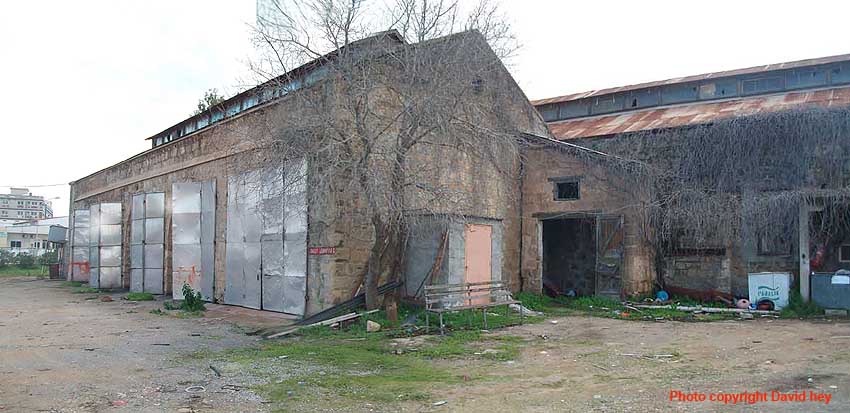
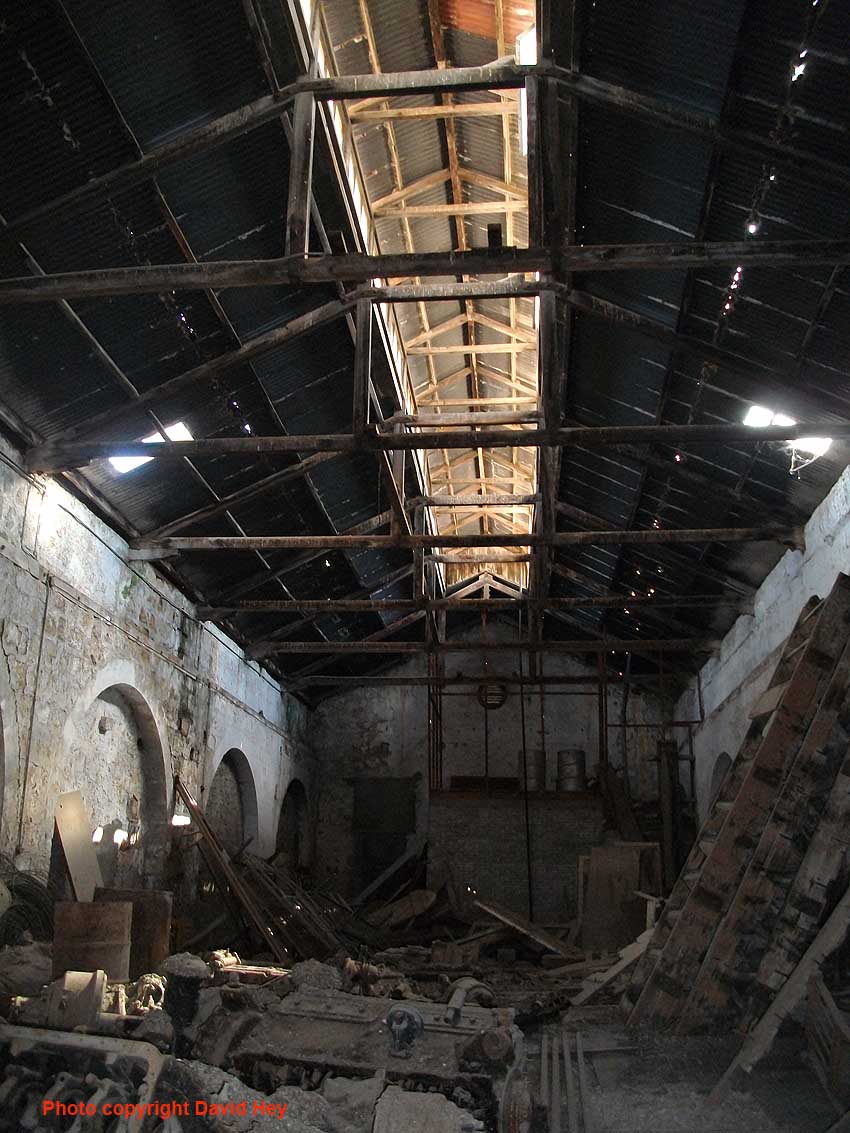
(Above-Below) Access to the workshops is restricted, of course, but when viewed through the windows and cracks in the doors, the interior is remarkably crammed full of miscellaneous bits and pieces from bygone days, though not necessarily railway relics - the local Highways Department has occupied the site for many years. Click here for a link to James Waite's illustrated page on the CGR. The line was also used by the Cyprus Mines Corporation to transport copper and chrome ore and asbestos to the docks at Famagusta.
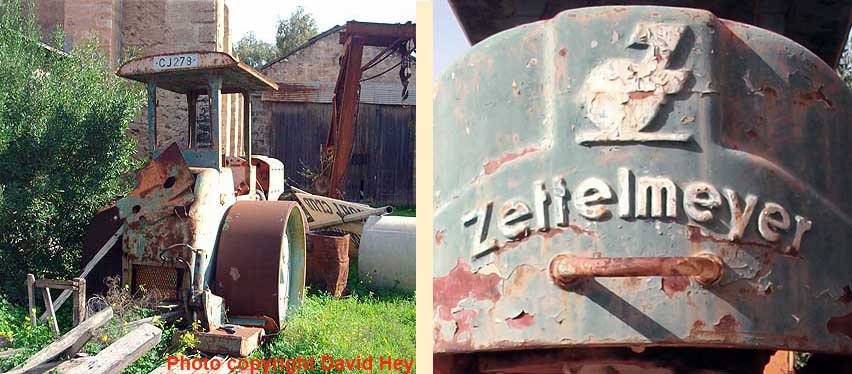
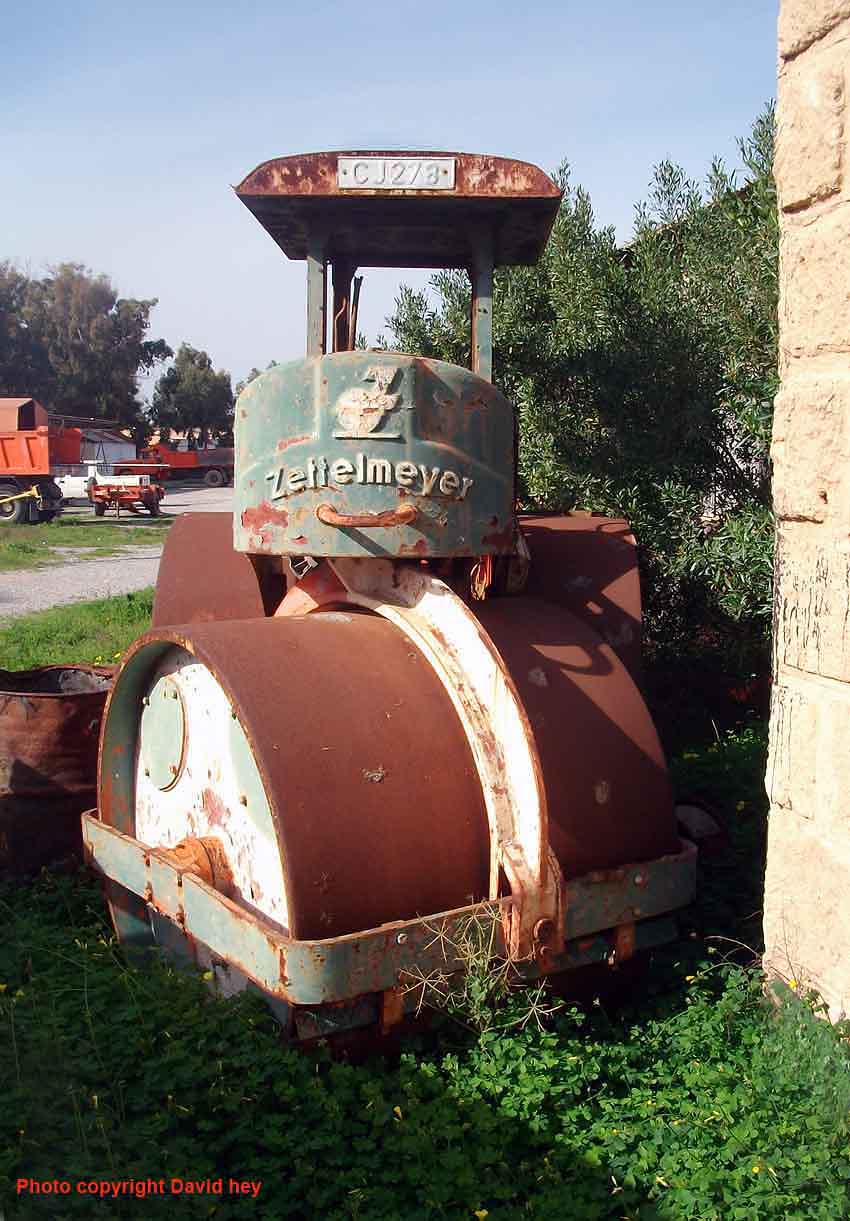
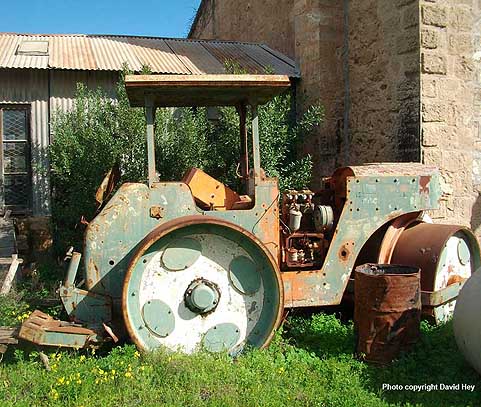

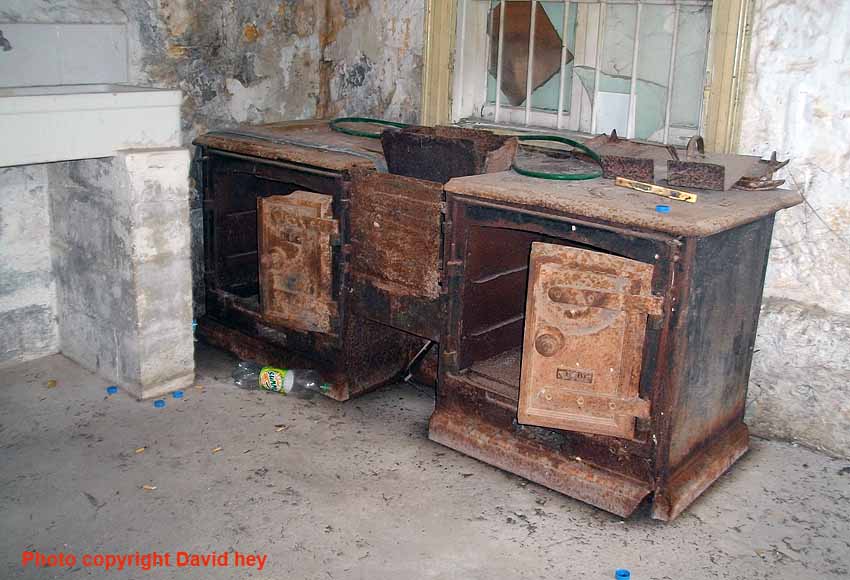
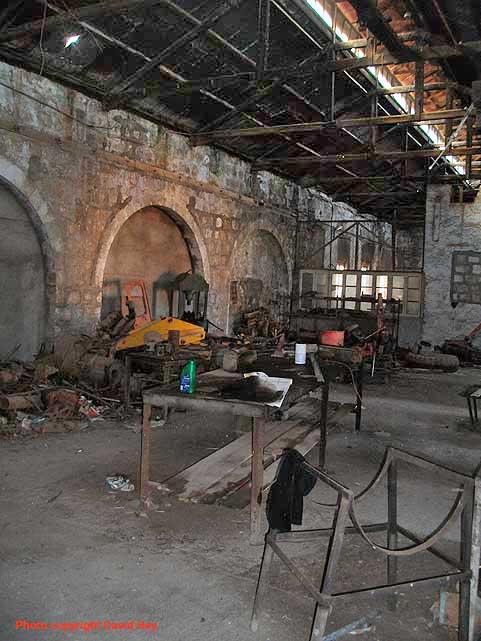
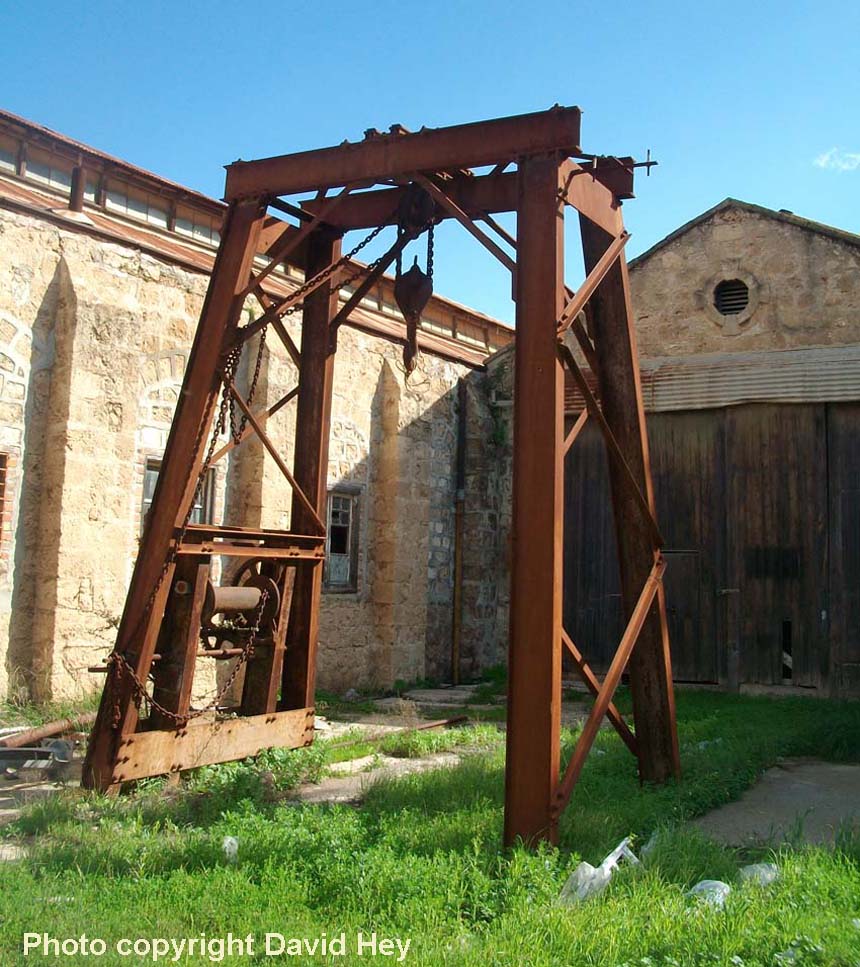
(Above-Below) The workshops retain many architectural features from steam days - a traditional stone-built standard railway building with large side windows, pitched roof with a gable at each end and roof vent running its full length to assist in the escape of smoke and fumes. Some of the rusting relics scattered about the place are easily identifiable, such as the old shed water tank - I think! The tower is situated within the perimeter of the Fire Department premises (behind the old station) and has a GWR'sh look to it! The structure remains in one piece as does the frame of the gantry hoist and the Cowans & Sheldon hand crane, all surprisingly in a good state of preservation. The rear of the workshops building can be seen in the right background.
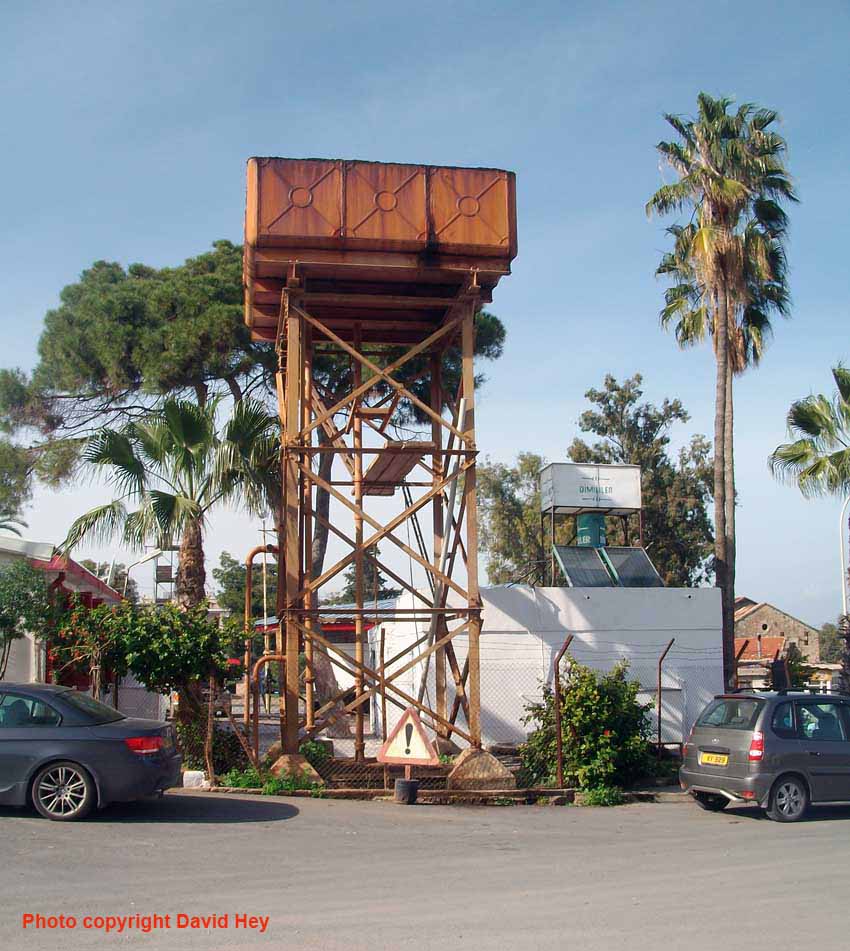
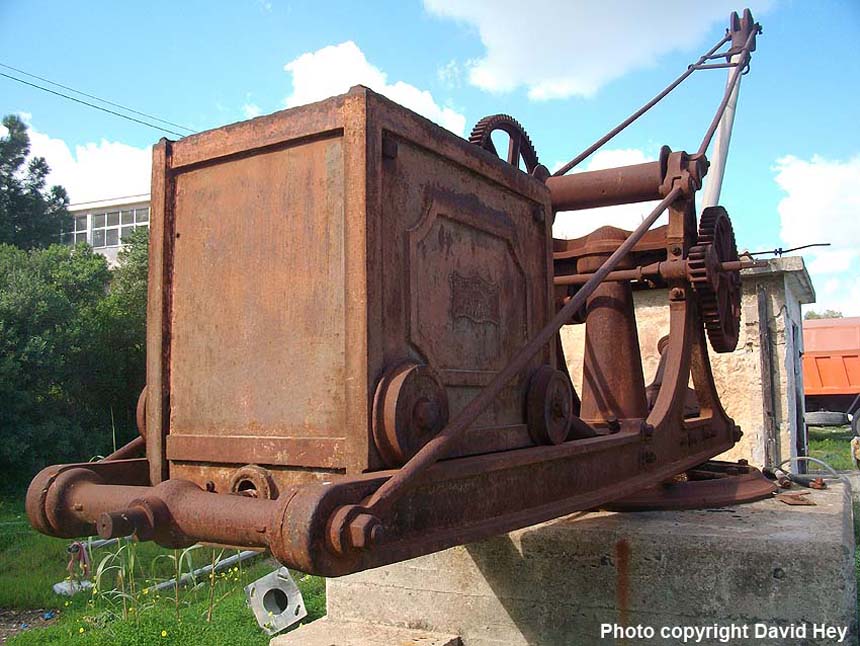
(Above-Below) The Carlisle firm of Cowans & Sheldon was founded in 1846 by John Cowans and Edward Sheldon, both ex-apprentices of the great railway pioneer George Stephenson. The firm's Woodbank Ironworks south of Upperby, became one of the most important railway and marine engineering companies in the world, manufacturing of a wide range of cranes, from railway breakdown cranes to dockside and floating cranes for marine applications. In June 1961 they merged with Clyde Crane & Booth, and in August 1968 the firm merged with Clarke Chapman & Co. Ltd. as part of its Crane & Bridge Division.
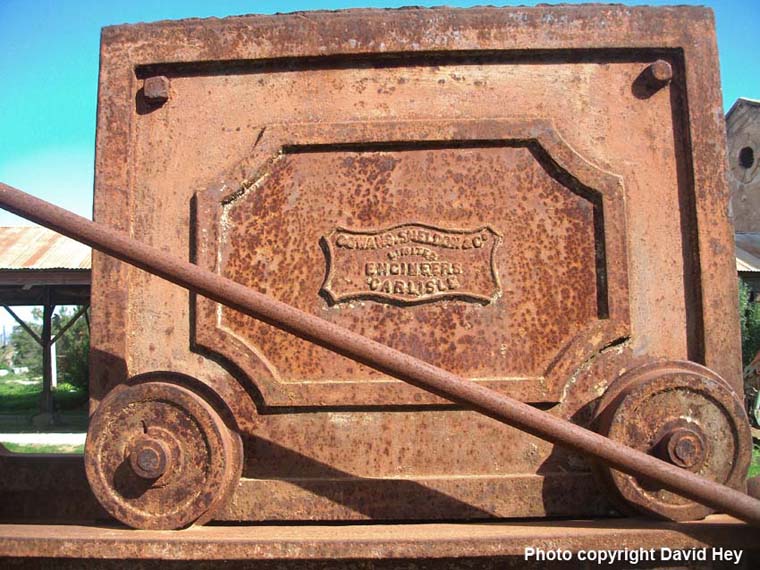

(Above) Staying on the subject of Cowans & Sheldon, the vacuum operated turntables built by thr company found their way to many BR loco depots, including Kings Cross, Camden, Crewe, Carnforth and Haymarket (Edinburgh). The vacuum was derived from the steam locomotive's ejector, however some turntables were fitted with huge tanks to enable dead locos to be turned, or locomotives not equipped with vacuum braking system. They were technically known as articulated tables, being hinged across the centre so as to distribute the weight of the loco between the two sets of carrying wheels and the centre bearing. The turntable installed at Fort William now resides at Kidderminster on the Severn Valley Railway. Click here for link to ER Morten's shot of Fort William shed.
Narrow Gauge at Kalavasos

(Above-Inset-Below) Kalavasos is a picturesque tourist village on the west bank of the Vasilikos River, located south-west of the city of Larnaca, 40 kilometres from the capital city of Nicosia and about 20 kilometres from the town of Limassol. In the centre of the village plaza is the Archaeological Museum, in which you can find archaeological finds unearthed during recent excavations. There are many archaeological places of interest, including the famous mining area of Kalavasos, once consisting of five mines for the excavation of copper-bearing ores. These mines were known as 'Platies', 'Petra', 'Mavri Sykia',
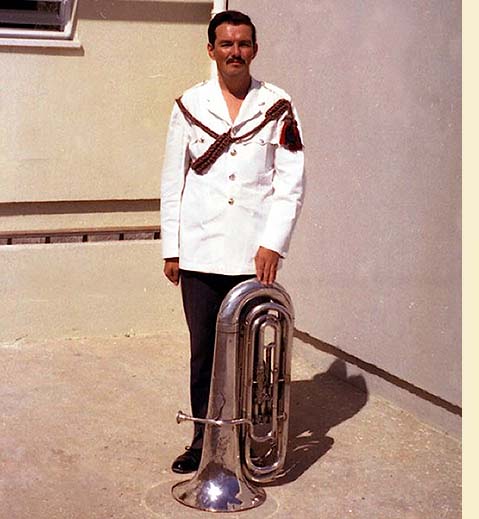 'Lantaria', and 'Mavridia', all of them belonging to the Greek Mining Company (GMC). The piles of rust and other mining leftovers provide proof that there was mining activity during ancient times attributed to the Phoenicians and later on to the Romans. The ore from the Kalavasos mines was transferred via railway to the harbour of Vasiliko. Rail Cameraman, Roy Lambeth took these shots with a Practica Super TL 35mm camera of Plymouth Diesel No 3 shunting the copper mine yard a few weeks before closure in 1976. More of Roy's Cyprus photos can be found here on the delightful 'Narrow Gauge Heaven' website. (Left) A brief word from Roy Lambeth, who went to RAF Akrotiri on 1st May 1975 on a 6 month tour to help close 103 MU....'I recall travelling in uniform (No 1 Best Blue) and leaving RAF Brize Norton aboard a Britannia at 05.00hrs with snow on ground and freezing cold, arriving at RAF Akrotiri in 86 degree heat, 100 per cent humidity and no wind. On arrival, I was informed that 103MU had already closed and had my tour extended to 30 months...the best holiday I ever had! But I had to find something to do during off-duty periods, so I joined Volunteer Brass Band as barman - then learned to play an instrument. Later on I joined the saddle club to ride horses and keep fit - but finished up running bar and getting fat! I joined NEAFCA (Near East Air Force Cruising Association - also known as the Muddle East Air Farce!) to sail and keep fit, but then became social secretary and guess what - I ran the bar!' Check out Roy's 'Rail Cameraman' pages 61-63...
'Lantaria', and 'Mavridia', all of them belonging to the Greek Mining Company (GMC). The piles of rust and other mining leftovers provide proof that there was mining activity during ancient times attributed to the Phoenicians and later on to the Romans. The ore from the Kalavasos mines was transferred via railway to the harbour of Vasiliko. Rail Cameraman, Roy Lambeth took these shots with a Practica Super TL 35mm camera of Plymouth Diesel No 3 shunting the copper mine yard a few weeks before closure in 1976. More of Roy's Cyprus photos can be found here on the delightful 'Narrow Gauge Heaven' website. (Left) A brief word from Roy Lambeth, who went to RAF Akrotiri on 1st May 1975 on a 6 month tour to help close 103 MU....'I recall travelling in uniform (No 1 Best Blue) and leaving RAF Brize Norton aboard a Britannia at 05.00hrs with snow on ground and freezing cold, arriving at RAF Akrotiri in 86 degree heat, 100 per cent humidity and no wind. On arrival, I was informed that 103MU had already closed and had my tour extended to 30 months...the best holiday I ever had! But I had to find something to do during off-duty periods, so I joined Volunteer Brass Band as barman - then learned to play an instrument. Later on I joined the saddle club to ride horses and keep fit - but finished up running bar and getting fat! I joined NEAFCA (Near East Air Force Cruising Association - also known as the Muddle East Air Farce!) to sail and keep fit, but then became social secretary and guess what - I ran the bar!' Check out Roy's 'Rail Cameraman' pages 61-63...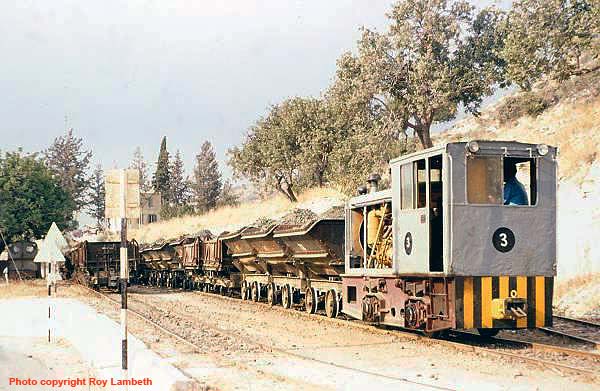
(Below) Found in a field near Frenerous on the road between Paralimni and old town Famagusta - a prime candidate for restoration...even the key is still in the ignition!
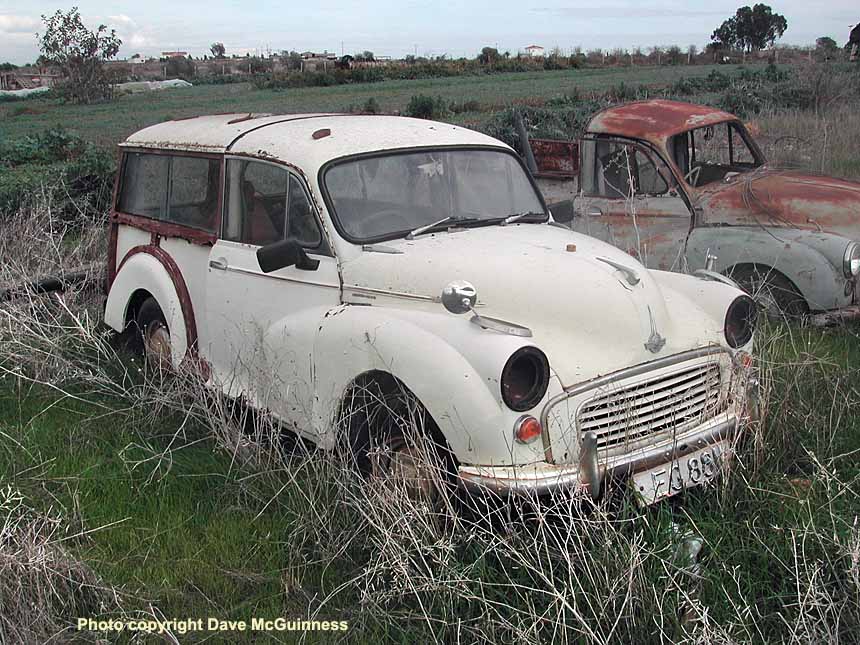
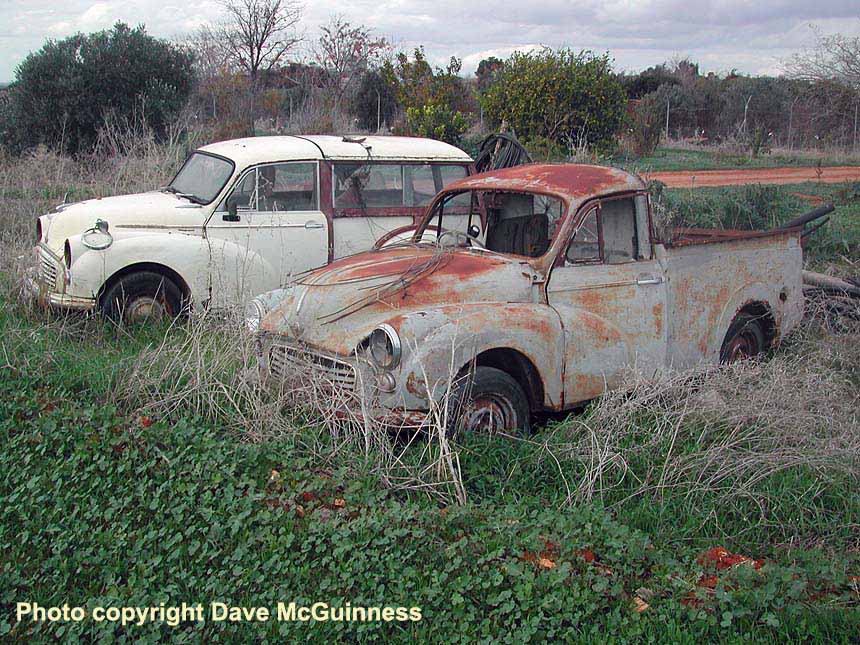

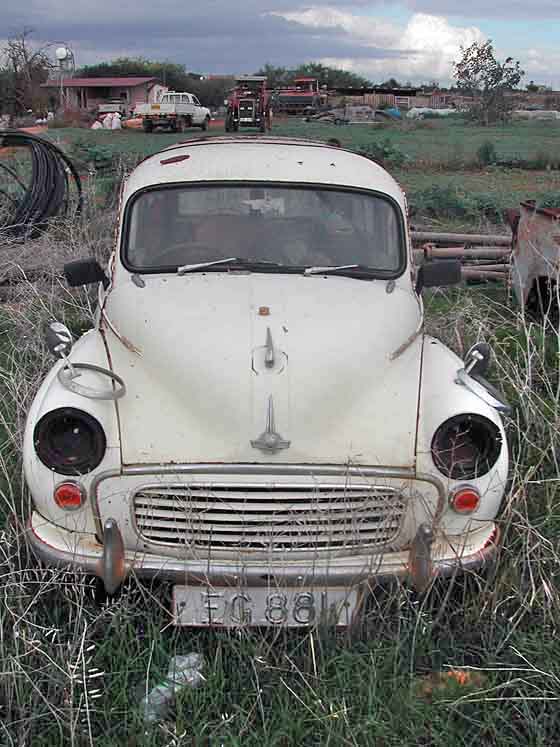

If anyone has any additional information - photos and captions for this page - I would dearly love to hear from them...full acknowledgement given. Also my thanks to Roger Griffiths for the corrections.
Polite notice: All text and photographs are protected by copyright and reproduction is prohibited without the prior consent of the © owners. If you wish to discuss using the contents of this page the email address is below. Please note - this is not a 'clickable' mail-to link via Outlook Express. You will have to email manually.
dheycollection@ntlworld.com

